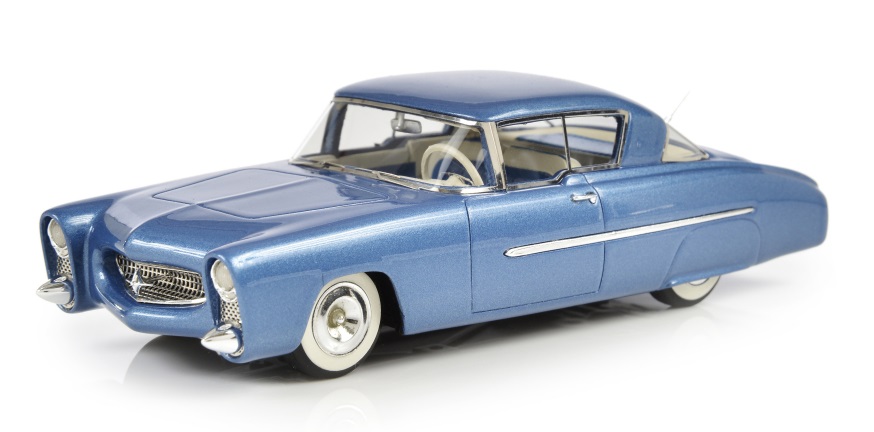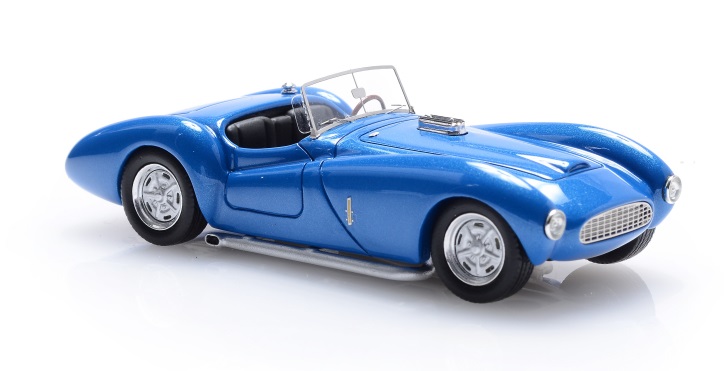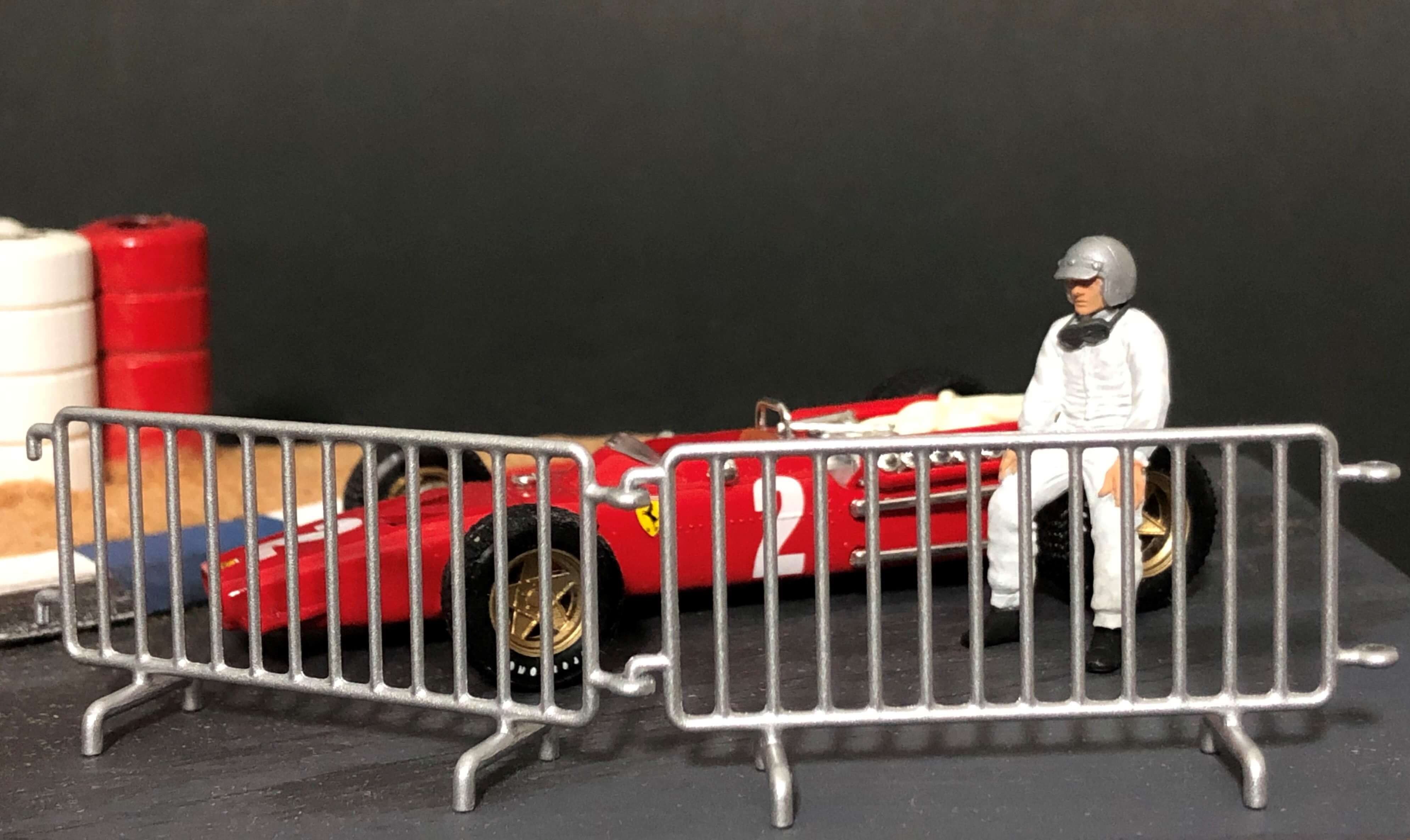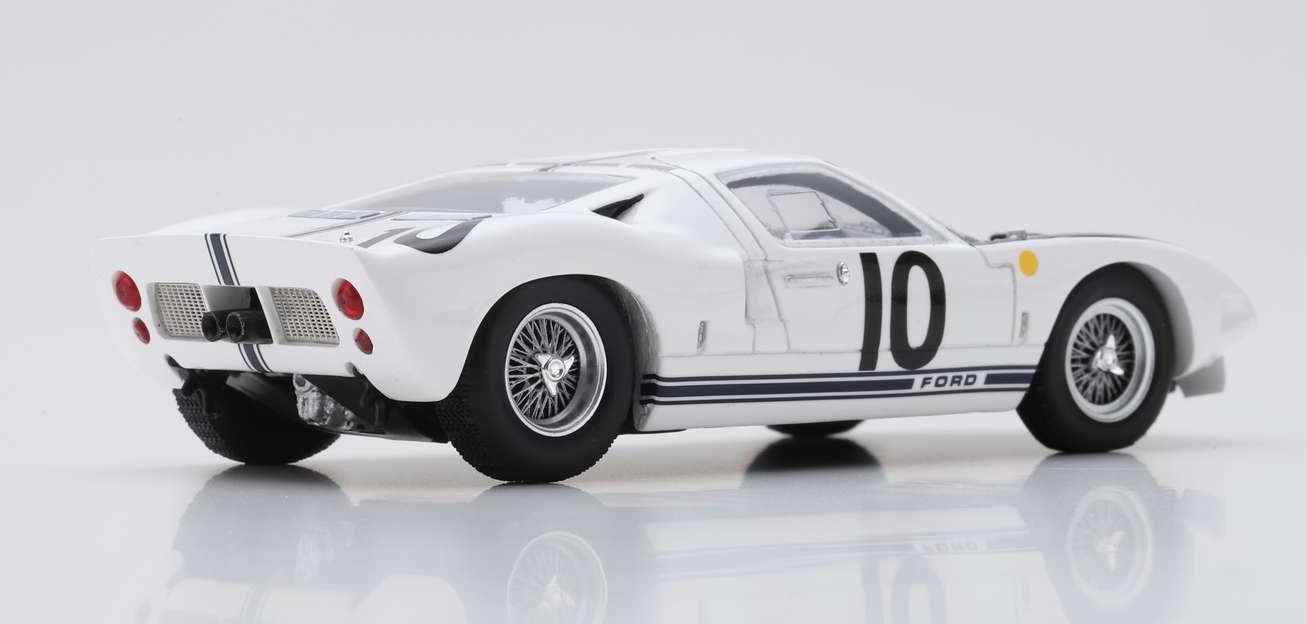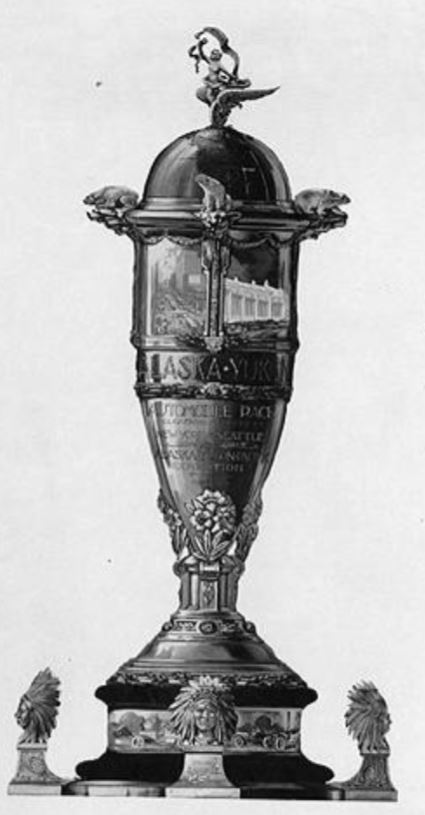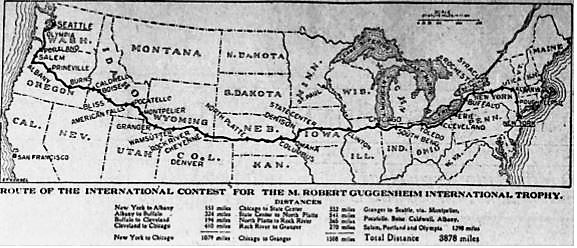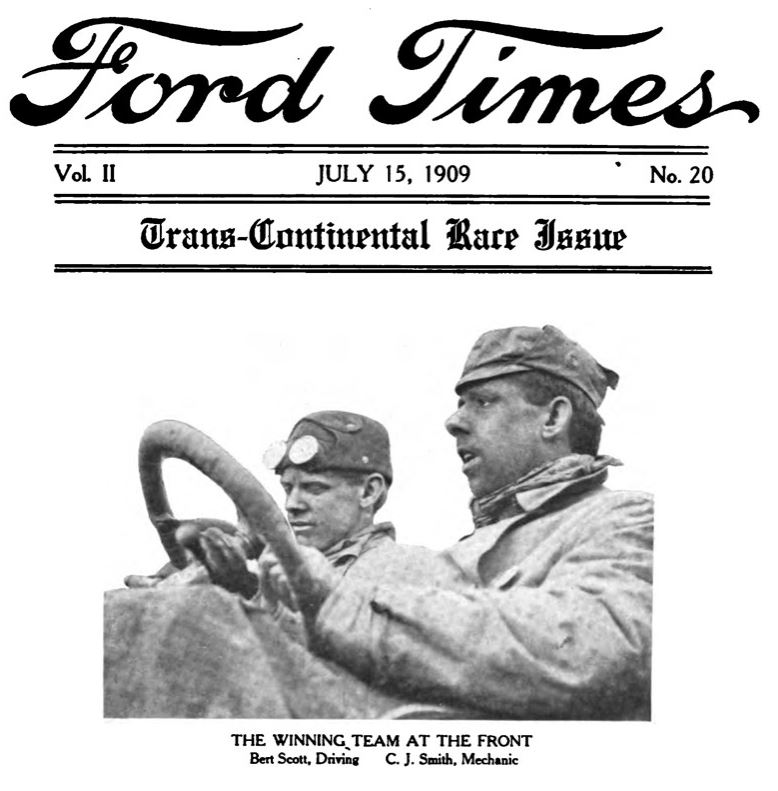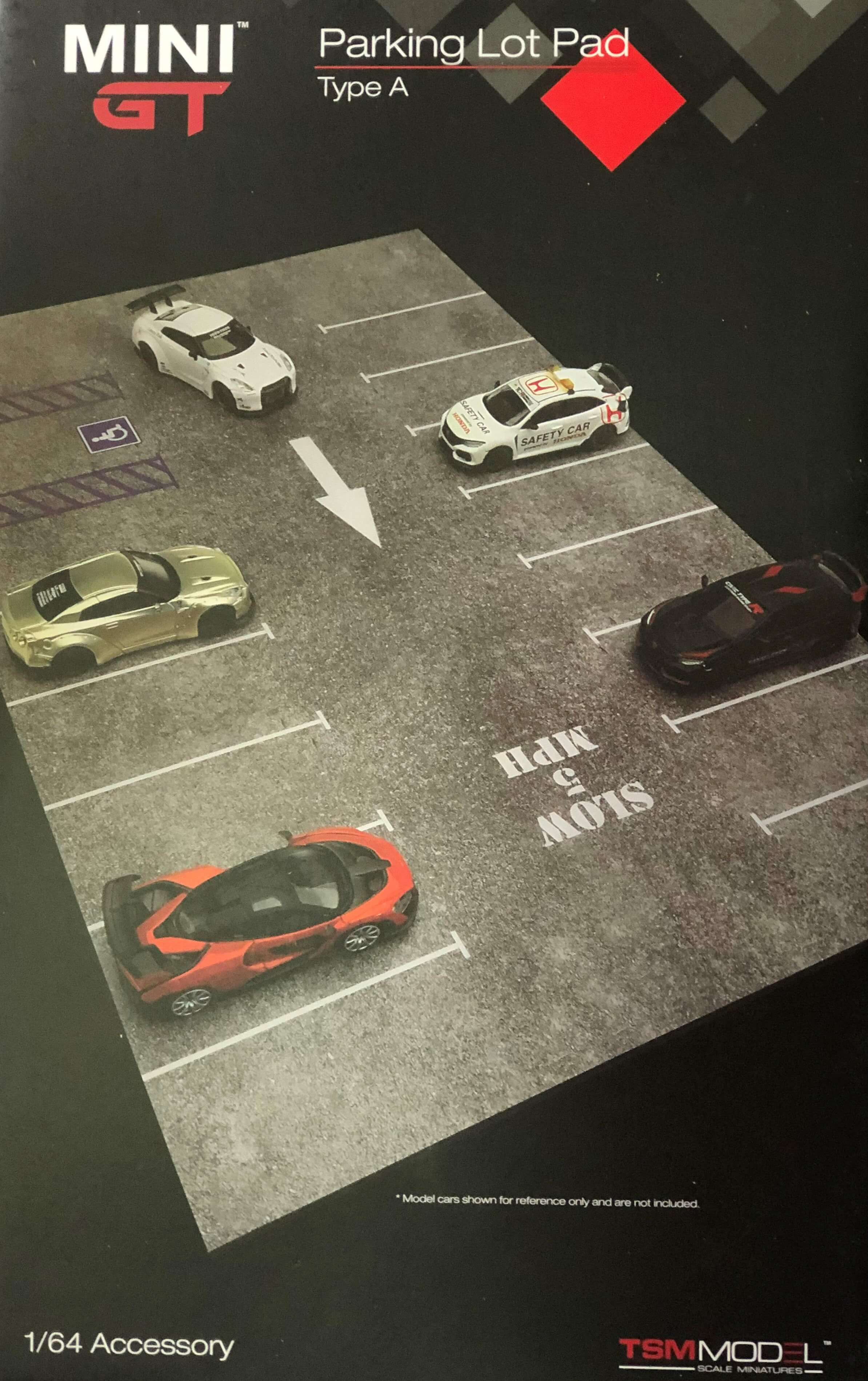www.F1scalemodels.com
... specialising in 1:43 scale model cars (Formula 1, Indy 500, Le Mans, GT and classic and modern road cars)
New Additions: December 2020
Welcome to the December update, just one more month before we can forget about 2020. Our state government has announced further easing of Covid restrictions on gatherings, however, any alleviations appropriate to model fairs will not come into effect in time for any December fairs so it appears a January restart may be a possibility. One interesting point, the Brisbane Model Diecast Collectors Club will be holding its December swap meet but with trading done outside in the carpark, in the style of a car boot sale. This is something worthy of consideration for the Sydney Granville fair. OK, not too many new additions this month which is really a sad reflection of the current state of the economy; I'm not selling much so consequently I can't buy much either. I'm really looking forward to the model fairs restarting! So, what are the highlights for this month...
In 1935, a one-off speed record car was built by Duesenberg, Inc. based on their Model J with a supercharged engine and was designated as the Duesenberg Special. In October 1935, the Special set the one-hour (247.79 kph) and twenty-four hour (218.18 kph) average speed records at a circuit on the Bonneville Salt Flats; the twenty-four hour record stood until 1961. In search of higher speeds, the Special had its engine replaced with a Curtiss Conqueror aircraft engine and this version of the car was named "Mormon Meteor", chosen after a naming competition was held by a local Utah newspaper. The Mormon Meteor broke several records beginning in 1936; the 500 km record of 264.69 kph and the 48-hour average speed of 239.21 kph. In 1938, the Curtiss aircraft engine was removed and the car was restored back to Duesenberg Special specifications, with the body modified for road use. The car was regularly driven on the streets until 1943. The current owner had the car restored to its 1935 racing condition and won the 2007 Pebble Beach Concours d'Elegance award. The high quality 1:43 model is made by Kess, an Italian model manufacturer.
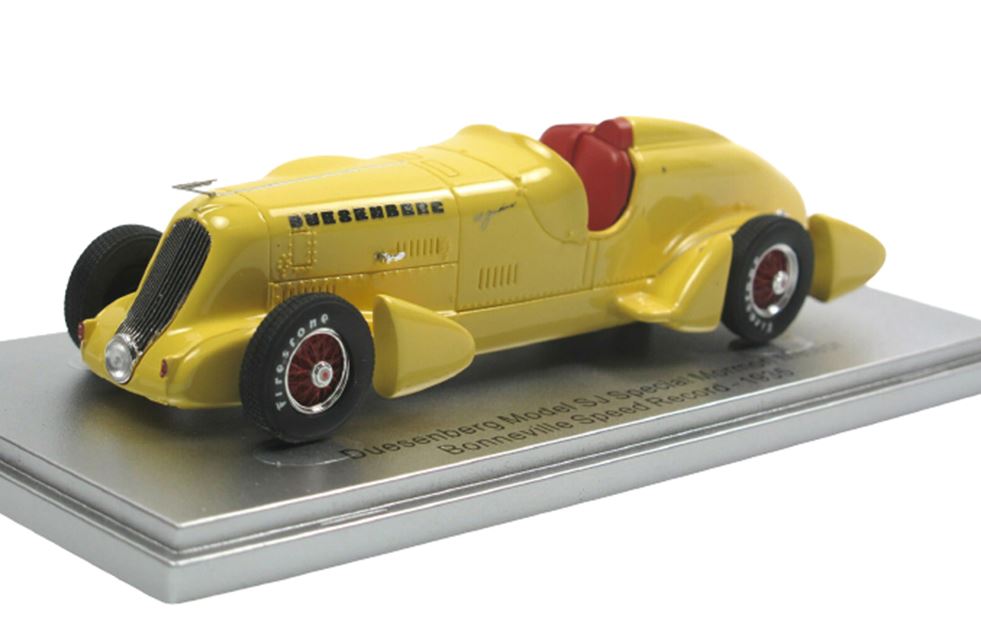 Kess: 1935 Duesenberg SJ Mormon Meteor
Kess: 1935 Duesenberg SJ Mormon Meteor
Invicta is a British car manufacturer that produced vehicles intermittently from 1925 to 1950. The S-Type was launched in 1930 using the 4.5 litre Meadows engine in a dramatically "under-slung" chassis and about 75 were produced. The Meadows engine was a low-revolution engine that delivered ample torque in the lower and middle speed ranges such that it could accelerate rapidly from a low speed while still in top gear. Rally driver Donald Healey (later of Austin-Healey fame) won the Monte Carlo Rally outright in 1931 with the S-Type and then placed second in 1932. The Invicta S-Type were pretty much indestructible, over 70 years after its production in 1930, about 68 of the 75 built are known to have survived and most are in excellent order. Matrix have produced both the 1931 and 1932 versions of Healey's Monte Carlo Rally cars. Both these 1:43 models are now difficult to obtain due to their low production runs.
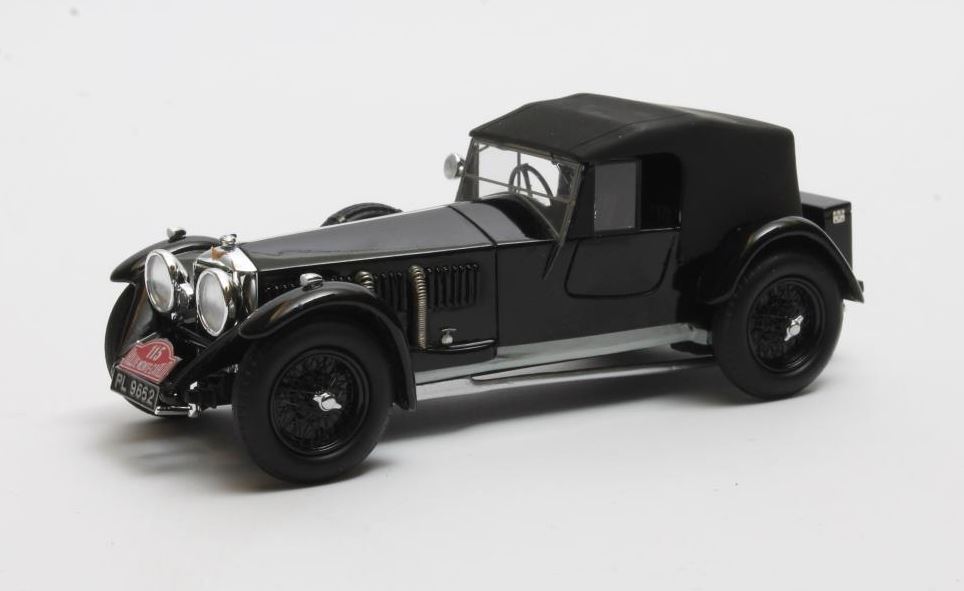 Matrix: Invicta S-Type 1932 2nd Monte Carlo Rally
Matrix: Invicta S-Type 1932 2nd Monte Carlo Rally
OK, that's a wrap for another month and another year. No model car fairs this month but there is a collectibles fair at Hurstville on 27th December. I've never been this fair so I can't say if there are many or, indeed any model car traders in attendance. Finally, I'd like to wish everyone a safe and happy festive season; hopefully we can meet again in person in January. Until then, happy collecting.
Formula one
- 1975 Ferrari 312T, C.Regazzoni (11) 1st Italian GP (Looksmart)
- 2018 McLaren Renault MCL33, F.Alonso (14) Race car (Minichamps)
- 1975 Parnelli Ford VPJ4, M.Andretti (27) Swedish GP (Spark)
American Race Series
- 2018 Acura NSX GT3, Marks/Aschenbach/Farnbacher (93) Watkins Glen (TSM)
- 2018 Ford GT, Dixon/Briscoe/Westbrook (67) 1st class 24h Daytona (TSM)
Land Speed Record
- Duesenberg SJ Special Mormon Meteor, Bonneville Speed Record car (Kess)
Rally Car
- 1932 Invicta S-Type 4.5 Litre, D.Healey (115) 2nd Monte Carlo Rally (Matrix)
Le Mans / Sports Car Racing
- 1964 AC A98 Coupe, Sears/Bolton (3) Le Mans (Matrix)
- 1963 Ferrari 250P, Surtees/Mairesse (23) Le Mans (Looksmart)
- 2017 Ford GT, Dixon/Briscoe/Westbrook (69) Le Mans 24h (TSM)
- 2017 Honda NSX GT3, Presentation car in carbon fibre (TSM)
- 1906 Itala, A.Canio (3) 1st Targa Florio (RIO)
Road Cars
- 1928 Bugatti 41 Royale Torpedo (open top) in green/black (RIO)
- 1954 Chrysler New Yorker Ghia Coupe in blue (Kess)
- 1960 Imperial LeBaron Southampton in metallic ligh blue (Kess)
- 2018 Maserati Gran Turismo MC in white (TSM)
After Thoughts: "A 60-year retrospective - The 1960 F1 World Championship." Congratulations to Lewis Hamilton (again) on winning his seventh world title after another dominant year in his Mercedes and also breaking the most GP wins record. There are a number of similarities between the current championship and the one sixty years ago; both were dominanted by one team and by one driver.
In 1960, points were awarded on an 8-6-4-3-2-1 basis at each round, with only the best six rounds to count for the championship. A total of 35 teams (discounting the teams who raced only at the Indy 500) contested the championship although most only raced at one or two rounds. On February 7th the teams travelled to Argentina to begin the 1960 championship and it did not start well for the reigning champion, Jack Brabham and his Cooper Works team. Brabham qualified poorly in 10th with the previous season's T51 chassis while his team mate, Bruce McLaren started 13th. The race itself proved disastrous for Brabham who retired near the half way mark but McLaren managed to salvage a win for the Cooper team. Cliff Allison in a Ferrari 246 was second and Stirling Moss who took over Maurice Trintignant's Rob Walker Cooper was third, but was not awarded points for the shared drive. For the Argentinian Jose Frolian Gonzalez, who scored Ferrari's first World Championship win, it was his last GP appearance. The next round was at the tight Monaco circuit; Moss, now in a Rob Walker Lotus 18 (having switched from Coopers) was on pole with Brabham next ot him. Brabham's race ended with a spin and Moss went on to win his second Monaco GP with Bruce McLaren in second, Phil Hill (Ferrari) was third. McLaren now led the championship (14 points) with Moss second with 8 points. Brabham had yet to score any points. Moss' Monaco GP win was the first ever for a Lotus car.
The third race was the Indy 500 and predictably, no European-based driver contested the race which was won by Jim Rathman who shot up to third in the championship. This would be the last time the Indy 500 officially counted towards the World Championship.
The situation looked dire for Jack Brabham, three races into a ten-race season and with no points scored. He needn't have worried. With the new Cooper T53 chassis, he won the next five races, the Dutch, Belgium, French, British and Portugese Grand Prix in a dominant display. His team mate, McLaren also scored two second places and one third place finsh to cement his second position in the championship. Brabham was now on 40 points, McLaren on 33 and Innes Ireland (Lotus-Climax) with 12 points in third.
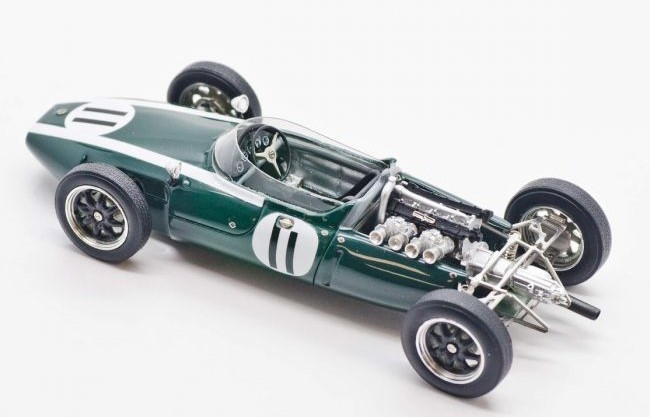 Biante: Cooper Climax T53, Jack Brabham 1st Dutch GP
Biante: Cooper Climax T53, Jack Brabham 1st Dutch GP
At the ninth race at Monza, the Italian organisers saw an opportunity to give the Ferrari team an advantage. The 1960 season had been a frustrating one for Ferrari as they still campaigned their obsolete front-engined Dino 246 but the venerable Ferrari had one advantage, straightline speed so the organisers incorporated the banked oval circuit with the road circuit, making an already fast Monza circuit even faster. Citing the fragility of their cars, the major British factory teams, Lotus, BRM and Cooper all boycotted the race. It was no surprise that Ferrari scored the top three positions at the end of the race. Phil Hill took the honours and moved to 3rd in the championship with 15 points. The race was also notable as being the last to be won by a front-engined car.
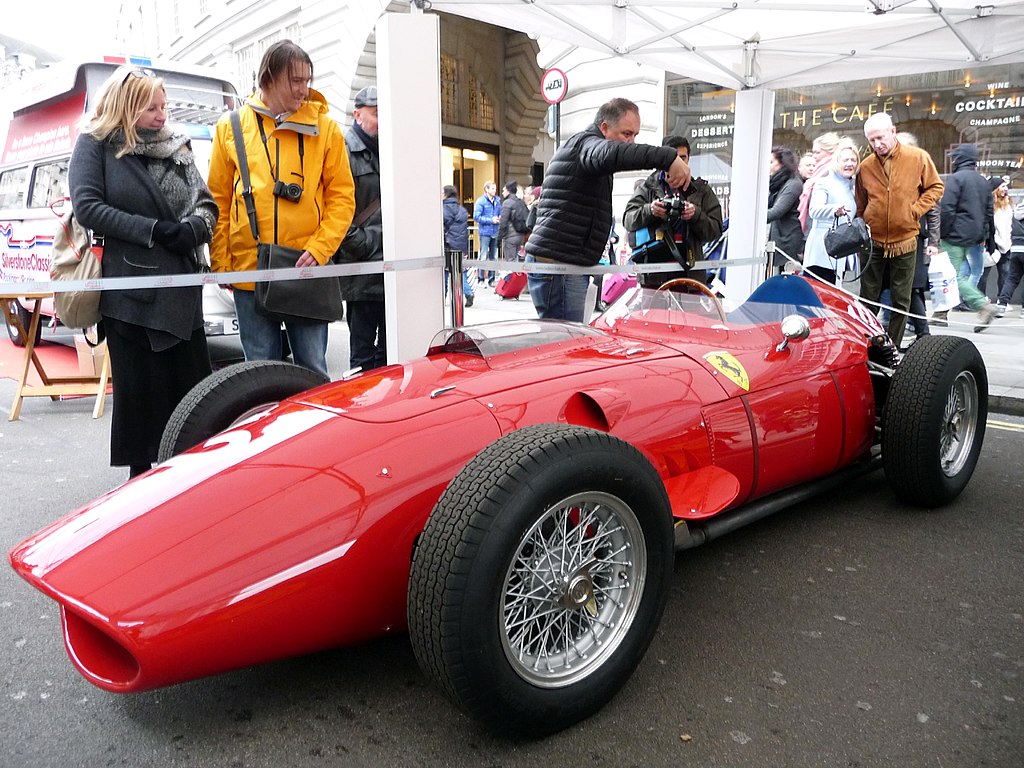 Ferrari Dino 246 at Regent Street Motor Show in 2016
Ferrari Dino 246 at Regent Street Motor Show in 2016
The 1960 season ended with the US GP at the Riverside International Raceway in California. With the tilte already decided in Jack Brabham's favour, Ferrari decided to skip the race to concentrate on preparing for the new 1.5-litre formula. Stirling Moss won the race which propelled him to 3rd in the Championship, behind Bruce McLaren in 2nd . Brabham was now a double World Champion.
New Additions: November 2020
Wow, another month has gone by; welcome to the November update. Covid, understandably is dominating the news at the moment and our thoughts are with all model car collectors worldwide but in particular America and Europe as they experience a massive surge in infections. I hope everyone manages to stay safe. Although we seem to have got on top of our second wave in Sydney, there's still no news of restarting our model fairs. Realistically, we have assume they won't restart until an effective vaccine is developed. The monthly Friday night model fair at Granville is held in a school hall and I'm sure the school wouldn't be keen to allow a bunch of potentially infectious people roaming around their assembly hall anytime soon. OK, so what are the highlights this month?
Ken Block is a professional American rally driver who is better known for his gymkhana exploits in his vintage, modified Ford Mustangs. Gymkhana is a form of motorsport where the goal is to negotiate a course that requires the driver to perform 180 and 360 degree spins, figure 8s, drifts and other advanced car skills. If you haven't seen his Pikes Peak "Climbkhana" in his 1400 horsepower twin-turbo methanol fueled 1965 Ford Mustang Hoonicorn RTR V2, then please check it out on YouTube. Seeing a wheel or two wheel hanging over the cliff edge is really amazing. TopMarques have produced two of Ken Block's Mustangs. These are listed in the American Race Series section.
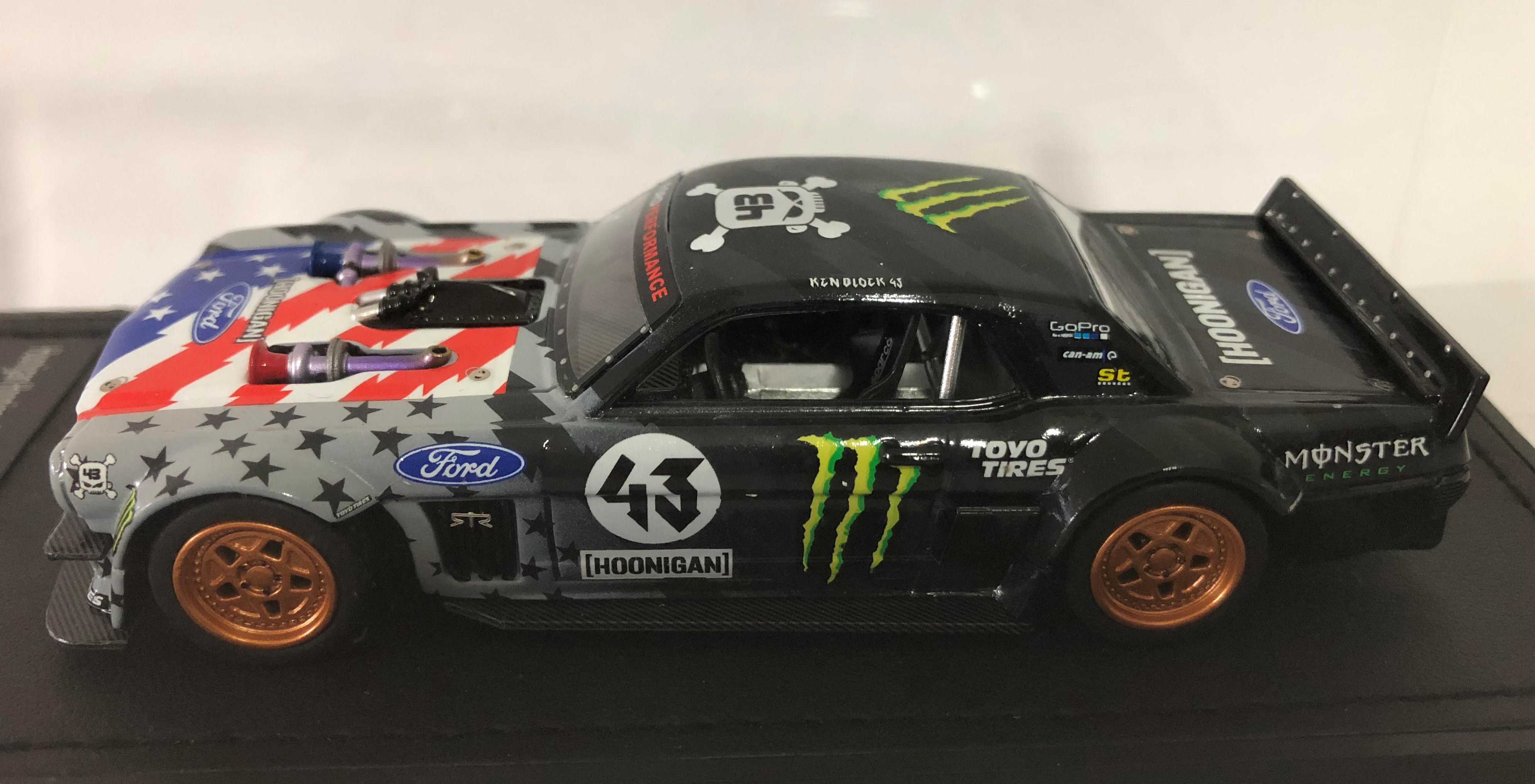 Top Marques: Ken Block's 1965 Ford Mustang "Stars & Stripes"
Top Marques: Ken Block's 1965 Ford Mustang "Stars & Stripes"
Newly signed to Ferrari in 2019, Charles Leclerc performed above expectations and certainly upstaged his 4-time World Champion team mate. In only his second race for the Scuderia, Leclerc scored his first pole position and then in the race, went on to score his first podium (3rd). Several more podium positions were scored before he achieved his maiden win at the Belgium GP and this was followed with another win at his next race at Imola. Looksmart have produced both the Belgium and Italian GP winning cars to their usual high standards.
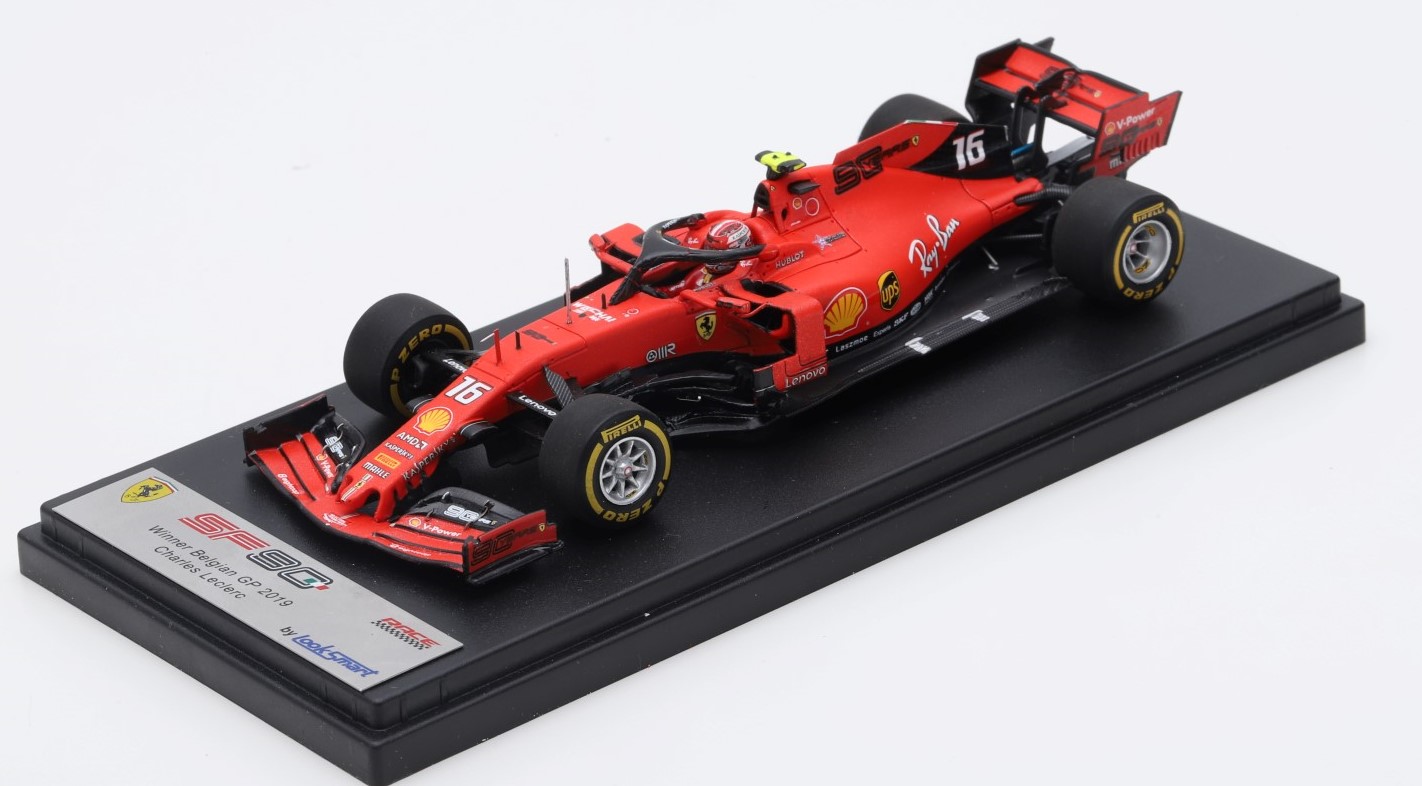 Looksmart: Ferrari SF90 2019 C.Leclerc Belgium GP
Looksmart: Ferrari SF90 2019 C.Leclerc Belgium GP
Mohs was a car brand built by the Mohs Seaplane Corporation in Wisconsin, USA. Bruce Mohs, the founder built his limited-production cars on International Harvester truck chassis' to custom specifications. Mohs was certainly a visionary who anticipated future automotive trends long before they became manistream which is probably why no one actually purchased any of his Ostentatienne Opera sedans back in 1967. The car had 20" truck wheels, weighed 6100lbs (2800 kg) and with over-the-top styling but propelled by an underwhelming 250 hp 304 V8 engine. The car had no side doors, the entrance was through the fold-up central rear door which allowed heavy steel girders to be fitted on the sides as a safety feature. Only one prototype was ever built, it remained in Bruce Mohs' possession and was restored in 2009 after sitting in storage for twenty years. Matrix has produced this model of a truly unique car.
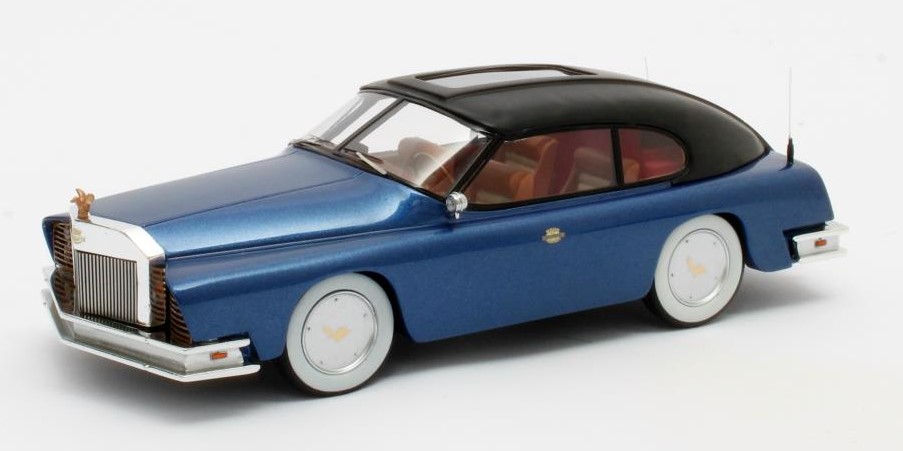 Matrix: Mohs Ostentatienne Opera 1967
Matrix: Mohs Ostentatienne Opera 1967
OK, that's it for another month. Lastly, this month's sale will be 20% off all BoS (Best of Show) models. Until next month, happy collecting
Formula One
- 1982 Ferrari 126C2, D.Pironi (28) 1st San Marino GP (Brumm)
- 2019 Ferrari SF90, C.Leclerc (16) 1st Belgium GP (Looksmart)
- 2019 Ferrari SF90, C.Leclerc (16) 1st Italian GP (Looksmart)
- 1974 Iso-Marlboro Ford FW, T.Belso (21) Swedish GP (Spark)
- 1976 Ligier Matra JS5, J.Laffite (26) 4th place Long Beach GP (Spark)
- 1962 Lotus Climax 24, G.Hill (14) Swedish GP (non-championship race) (Spark)
- 1969 Matra Ford MS80, J.P.Beltoise (8) Monaco GP (Spark)
- 1971 McLaren Ford M19A, D.Hobbs (31) US GP "Sunoco" (Spark)
- 1988 McLaren Honda MP4/4, A.Prost (11) 1st Brazilian GP Ed.43 No.193 (Minichamps)
- 2019 Mercedes AMG W10, L.Hamilton (44) US GP World Champion (Minichamps)
- 2002 Toyota TF102, M.Salo (24) Australian GP, 1st championship points (Minichamps)
- 1956 Vanwall VW2, F.Gonzalez (18) British GP (Spark)
Le Mans / DTM
- 1992 BMW M3 E30, W.Gardner (20) "Jagermeister" DTM (CMR)
- 1992 Toyota 92C-V, Sekiya/Raphanel (8) JSPC MINE 500km (Spark)
Australian Race Series
- 2019 Bentley Continental GT3, Gounon/Kane/Pepper (107) 8th Bathurst 12h (TSM)
- 2017 Porsche 911 GT3 Cup, D.Wall (38) 1st Carrera Cup Australia "Payce" (Spark)
American Race Series
- 1965 Ford USA Mustang, Ken Block (43) "Hoonigan" Beast 2017 (TopMarques)
- 1965 Ford USA Mustang V2, Ken Block (43) "Hoonigan" Stars and Stripes (TopMarques)
- 1968 Lola T70 Mk3, C.Parsons (10) Can Am (Spark)
Road Cars
- 1957 Chrysler Dual Ghia Convertible in cream (Matrix)
- 1940 Ford Panel Van in grey (MotorHead)
- 1955 Ford Thunderbird Coupe in yellow (MotorHead)
- 1962 Ford Thunderbird Sport Roadster in white (MotorHead)
- 1964 Jensen P-66 Prototype in metallic green (Matrix)
- 1968 Mercury Cougar Coupe in red (MotorHead)
- 1967 MOHS Ostentatienne Opera in blue/black (Matrix)
- 1994 Toyota Celica in red (Maxichamps)
After Thoughts: "The Great Designers - Harvey Postlethwaite." In the field of formula One car design, only a few have managed to become absolute giants of their field. During the 1970s, 1980s and 1990s one man stood out for his brilliance and pioneering vision and his name was Harvey Postlethwaite. Born on 4th March 1944, Postlethwaite went on to study science and then mechanical engineering eventually obtaining work as a research scientist for ICI after completing his PhD. For a while Postlethwaite competed in club motor racing but a lack of funds soon ended his racing ambitions and as he grew bored with his job, he began to pursue a career as a race car engineer. Here is but a brief summary of his life's work in designing F1 racing cars.
 Harvey Postlethwaite (c. 1990's)
Harvey Postlethwaite (c. 1990's)
Hesketh (1973 - 1976). In 1970, at the age of 26, Postlethwaite joined the March team working on the fledgling company's F2 and F3 cars. Eventually, he was lured away to join Hesketh Racing, a March customer. When asked why he joined such an eccentric, party-loving racing team, Postlethwaite simply explained, "They got me drunk!" His job at Hesketh was to modify and improve the March 731 chassis and his work helped to move the team up the crowded field to become serious contenders. In 1974, "Doc" Postlethwaite designed an all-new car, the Hesketh 308 and James Hunt scored three 3rd place finishes. In 1975, Hunt scored the team's only win at the Dutch GP with an improved 308. But by 1976 Lord Hesketh ran out of money and the party was over. Postlethwaite went with his cars to the newly founded Wolf-Williams Racing.
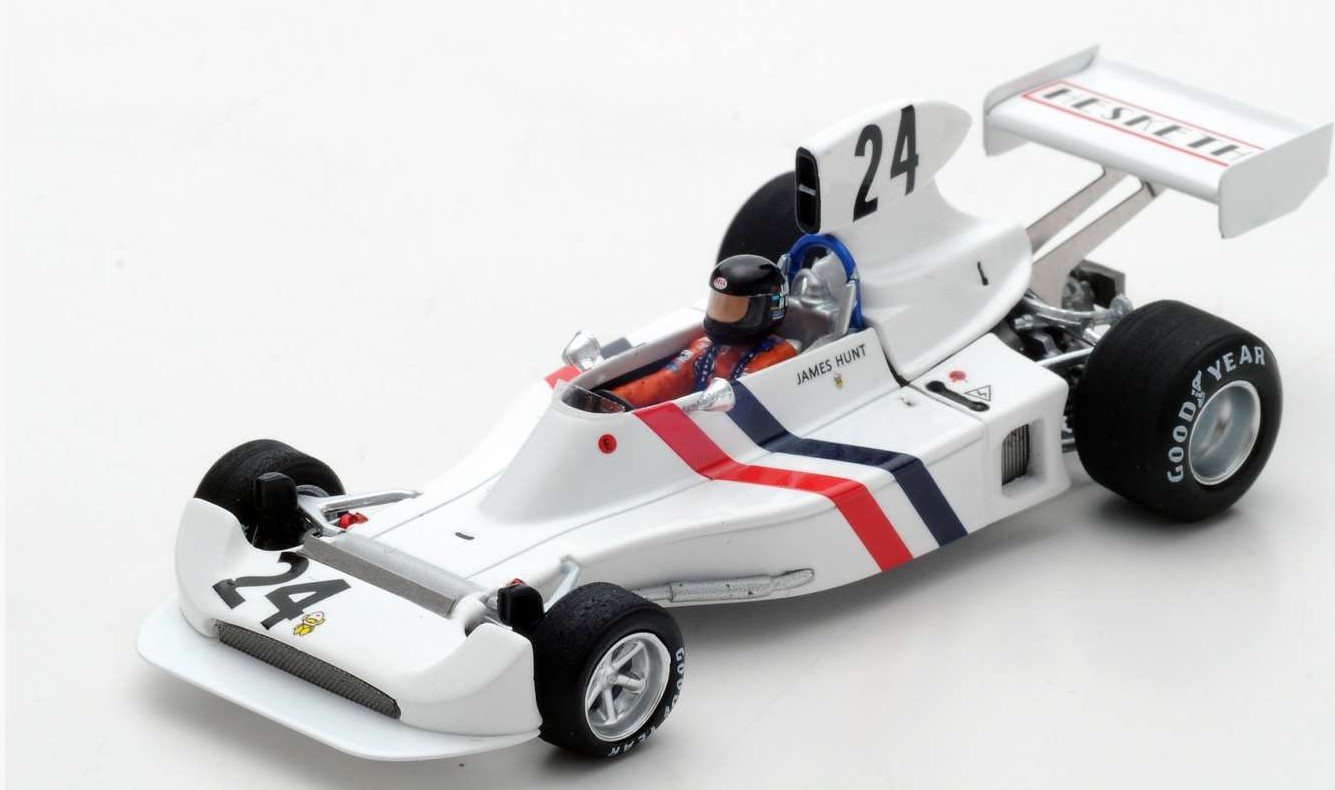 Spark: Hesketh Ford 308 J.Hunt 1974 Swedish GP
Spark: Hesketh Ford 308 J.Hunt 1974 Swedish GP
Wolf-Williams (1977 - 1979). After Walter Wolf took a 60% stake in Frank Williams' team, he purchased the assets of Hesketh Racing and the Hesketh 308C became the Wolf-Williams FW05. The car was no longer competitive and failed to qualify for many races. At the end of 1976, Frank Williams left the team to form Williams Grand Prix Engineering but Postlethwaite stayed with Wolf and designed the Wolf WR1, a conventional Cosworth package. The WR1 won three races in 1977 and gave Wolf 4th place in the Constructors' Championship. Postlethwaite stayed with Wolf until the end of 1979 when the team folded and they were never to repeat their 1977 success. Postlethwaite, along with the Wolf cars, moved to the Fittipaldi Automotive team.
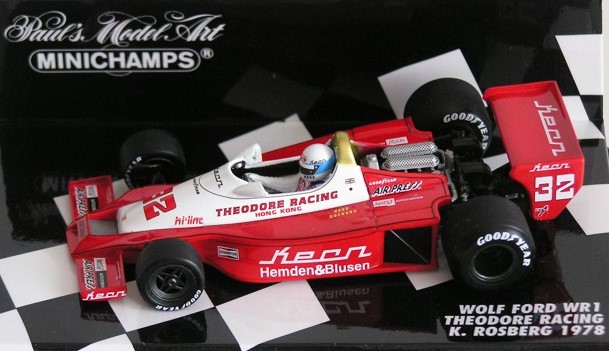 Minichamps: Wolf Ford WR1 1978
Minichamps: Wolf Ford WR1 1978
Fittipaldi (1980). The team used a re-worked Wolf chassis from the previous season, designated as F7s scoring a couple third places. For the latter half of the 1980 season, Postlethwaite designed the Fittipaldi F8 but was less successful than the previous F7. At the end of 1980, Postlethwaite joined Ferrari.
Ferrari (1981 - 1987). At the time he joined Ferrari, the Italian team had mastered the turbo technology but they lacked a chassis to go with the power and Enzo Ferrari selected Postlethwaite to rectify this problem. Postlethwaite, nicknamed "Postalmarket" by the Italians who found his name impossible to pronounce, overhauled the 126CK chassis in time for the 1982 season and was called the 126C2. Smaller and nimbler, the 126C2 handled far better than its predecessor and in the hands of Villeneuve and Pironi, won the Constructor's Championship. The '82 season was marred by the death of Villeneuve and the serious injuries sustained by Pironi. Ferrari took the Constructor's Championship again in 1983 with the 126C2B and 126C3. In 1987, Ferrari employed John Barnard as the new technical director and Postlethwaite was restricted to the management of the cars on track. The inevitable friction between him and Barnard saw Postlethwaite move to Tyrrell.
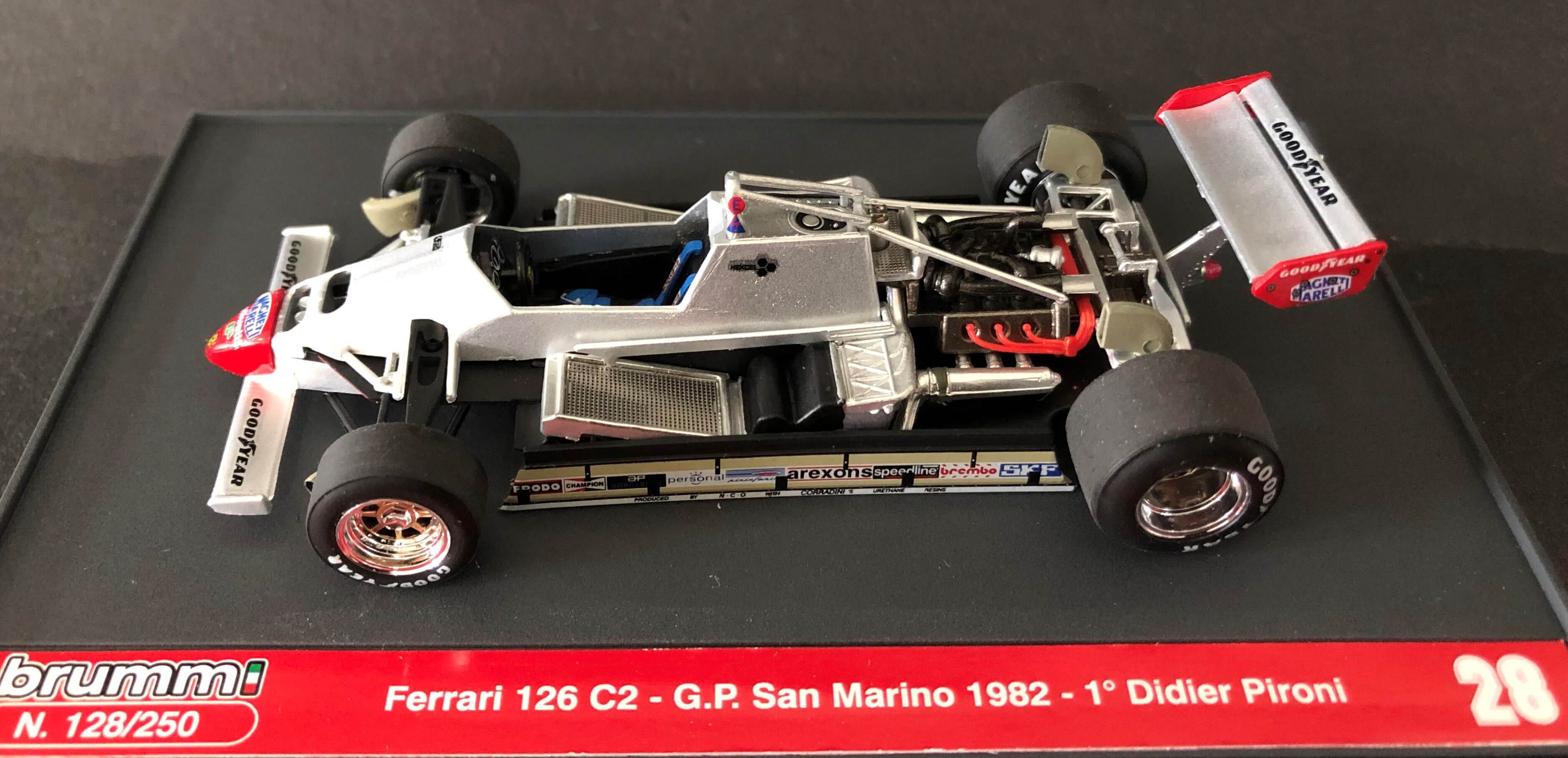 Brumm: Ferrari 126C2 1982 D.Pironi
Brumm: Ferrari 126C2 1982 D.Pironi
Tyrrell (1988 - 1991). During his tenure as technical director, Tyrrell's results improved noticeably, culminating in the 1990 season opener in Phoenix, where Jean Alesi was able to challenge Ayrton Senna's McLaren for victory in a Tyrrell 018. Alesi repeated the feat in Monaco, driving the 019 - the first of the revolutionary 'anhedral high nose" F1 cars and this feature would be copied by other teams for several years.
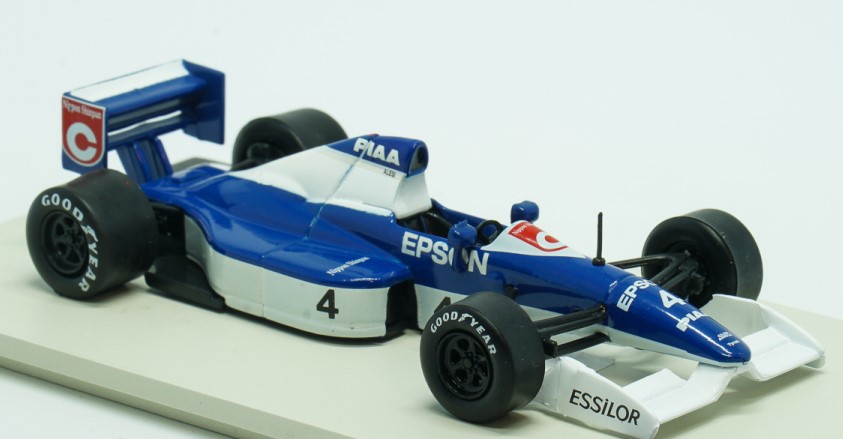 RBA: Tyrrell Ford 019 J.Alesi 1990
RBA: Tyrrell Ford 019 J.Alesi 1990
Sauber (1992). Postlethwaite was appointed technical director of the Sauber team who planned to enter F1 in 1993 and was tasked to produce the team's first car. However, the Doc left before the start of the 1993 season but his car scored regular points in the hands of JJ Lehto and Karl Wendlinger.
Ferrari (1992 - 1993). Postlethwaite returned to Ferrari but after the death of Enzo Ferrari in 1988, the team was not the same. Mired in bureaucracy, Postlethwaite's stay was short. Upon leaving he reflected that, "I'd had some good times with Ferrari, especially when the old man was alive, but by the end I had too many memories of sitting in planning meetings with some 40 other people, all talking, all getting nowhere." He moved back to Tyrrell.
Tyrrell (1994 - 1998). Despite Postlethwaite's presence, the Tyrrell team slowly dropped back from the middle of the pack and in 1998, in the face of dwindling form and ill-health, Ken Tyrrell sold his team to British American Racing. During his tenure with Tyrrell, the Doc remained well-respected within the sport and he was hired by the in-house Honda F1 project in 1999. Although Honda had not committed to F1, Postlethwaite produced an evaluation car built by Dallara. It was during the testing of this car in Spain that Harvey Postlethwaite suffered a fatal heart attack. He was just 55 years old.
Update: 8th October 2020
I've had no news about the October model fair at Granville and as it's scheduled for tomorrow, it's safe to assume it's not going to be held. Let's hope for better news next month.
New Additions: October 2020
Another month has passed by; just three months to go to finish off 2020. It's been quite an unforgettable year so far, for all the wrong reasons. Welcome to the October monthly update. The Covid situation in NSW has improved with some easing of restrictions but the Sydney Model Auto Club have yet to make a decision about restarting their model fair at Granville. As soon as I know, I'll post an update so please check back regularly. Just a reminder that mail-order is an option if you need a model or two for your collection. A number of deliveries arrived earlier than expected so the there's quite a few new additions this month and a few worthy of a special mention.
Scuderia Coloni was an Italian racing team founded by Enzo Coloni in 1982, participating in F3 before making the leap to F1 in 1987. From 1987 to 1989 the team used Cosworth DFZ and DFR 3.5 litre engines. The under-financed team scored no points using the Cosworth engines but did manage to qualify for a hand full of races, an eighth place at the Canadian GP in 1988 being their best result. Then in 1990, a contract was signed with Subaru that brought considerable financial backing and an exclusive works engine for free. The Japanese company took a 51% stake in Coloni and paid off the team's debt. The Subaru flat-12 engine was in fact designed by Carlo Chiti but it soon became apparent it was severely under-powered, producing no more than 500bhp (compared to 680 bhp for the top engines). The Coloni Subaru team only finished work on their single C3B chassis hours before it was due to be shipped by the FIA to the first race in Phoenix. In the pits at Phoenix, the car was fully assembled for the very first time and a short shakedown took place in the parking lot of a local supermarket. At Phoenix, there were 35 cars present and only 26 places on the starting grid, so the Coloni was forced to "pre-qualify" to get into the main qualification session. The Coloni was over-weight, under-powered and ill-handling so unsurprisingly, Bertrand Gachot was the slowest runner and did not pass pre-qualifying. In the eight races the Coloni Subaru attended, it failed to pre-qualify and by mid-1990, Subaru sold the team back to Enzo Coloni, debt-free.
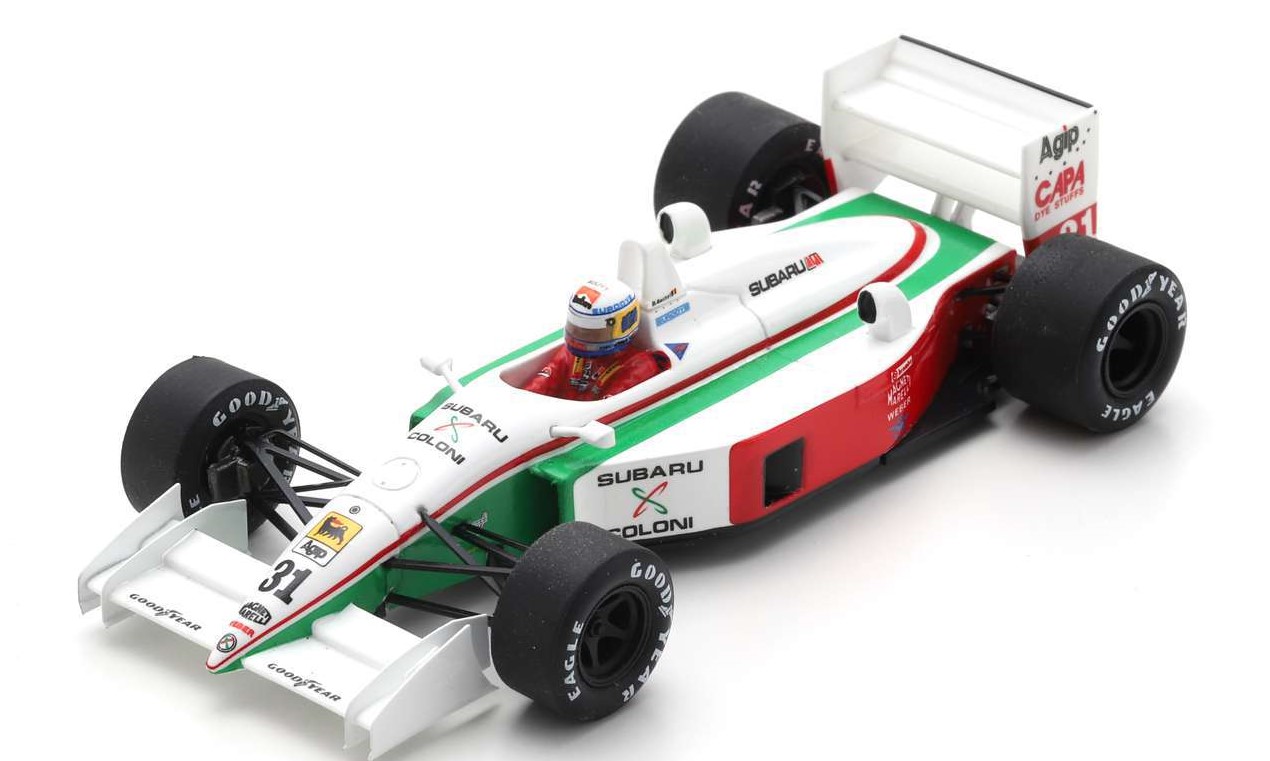 Spark: Coloni Subaru C3B, 1990 Phoenix GP
Spark: Coloni Subaru C3B, 1990 Phoenix GP
Esval, a relatively new American model manufacturer established in 2013 is a new brand for me. The level of craftsmanship, detail and authenticity of their resin models have been well regarded by the collecting community. Some of the models produced are really interesting and here's a couple that particulary caught my attention. The first one is the 1950 Mercury Leo Lyons Coupe. In 1950, 20-year-old Leo Lyons had a dream of building a custom car unlike any other. Lyons purchased a chassis and body panels from the Ford Motor Company and then turned to a metal-shaping firm to custom design and bulid the doors, hood and top. The resulting Coupe was the most radically customised 1941-51 Custom Mercury built in the 1950s and the initial plan was to build ten cars. But, only one prototype was ever built.
The other Esval model that deserves a mention is the 1954 Victress S-1A. The body of this sports car was produced by the Hellings Company of North Hollywood, California and has been hailed as one of the most beautiful American designs offered during the 1950's. The Victress was truly one of the pioneers of the "fiber-sports" era of the early 50's. Since the Victress was fitted on a variety of chassis, no two cars were alike and approximately 200 Victress S-1A bodies were fabricated from fiberglass.
Finally, also new in stock are some 1:64 models from ACME (another American based company) and are made by Greenlight. There are some really cool Chevrolet and Ford ramp trucks from the late 60's and early 70's with their respective Trans Am race cars, including Alan Moffat's Brut and Coke Mustangs. There's also a couple of really beautiful 1970 Plymouth Barracuda Trans Am cars as well. All are reasonably priced.
OK, that's it for another month. I hope we see a return of the model fairs before the end of the year. Lastly, I've decided to extend the sale of all White Box models for another month so the price of all White Box models will be reduced by 20%. Until next month, happy collecting.
Formula One
- 1979 Brabham Alfa BT48, N.Lauda (5) 4th Italian GP (Spark)
- 1990 Coloni Subaru C3B (FC189B), B.Gachot (31) Pre-Qualifying US GP (Spark)
- 1973 Iso-Marlboro Ford FX3B, N.Galli (24) Spanish GP (Spark)
- 1974 Iso-Marlboro Ford FW, A.Merzario (20) Brazilian GP (Spark)
- 1978 Ligier Matra JS9, J.Laffite (26) Monaco GP (Spark)
- 1974 Parnelli Ford VPJ4, M.Andretti (55) Canadian GP (Spark)
- 1976 Parnelli Ford VPJ4B, M.Andretti (27) Long Beach GP (Spark)
- 1977 Shadow Ford DN8, R.Patrese (16) 6th Japanese GP (Spark)
- 1971 Surtees Ford TS9, J.Surtees (23) 5th Dutch GP (Spark)
- 1971 Surtees Ford TS9, R.Stommelen (24) British GP (Spark)
- 2019 Helmet - Daniel Riccardo - Renault F1 helmet 1:5 scale (Spark)
Australian Race Series
- 2019 Mercedes AMG GT3, Buhk/Gotz/Marciello (999) 3rd Bathurst 12h (Spark)
American Race Series
- 2019 Cadillac DPi-V.R, Nasr/Curran/Derani (31) 1st 12 hours Sebring (Spark)
- 1966 Ford GT40 X1 Roadster, Miles/Ruby (1) 1st Sebring 12-hour (Spark)
- 1986 Porsche 962, Barilla/Wollek (86) 1st IMSA Miami (Spark Car.tima exclusive)
Le Mans
- 1977 Alpine Renault A310, Decure/Therier/Cauchy (87) Le Mans (Spark)
- 2010 Aston Martin V8 Vantage, Borness/Rubis/Shaw (67) 24h Nurburgring (Minichamps)
- 1973 BMW 3.0 CSL, H-J Stuck/N.Lauda (60) Spa 1000km (Spark)
- 2019 Ford GT, Briscoe/Dixon/Westbrook (69) Le Mans (Spark)
- 1979 Lotus Europa Turbo Gr.5 (Zakspeed), H.Ertl (22) 1000 km Nurburgring (Spark)
- 1984 Porsche 956, Thackwell/Winkelhock (10) Fuji (Spark Car.tima exclusive)
- 1985 Porsche 956, Berger/Brun (Jagermeister) (20) 1000 km Hockenheim (Spark Car.tima exclusive)
- 1988 Porsche 962, U.Schafer (8) ADAC Supersprint Nurburgring (Spark Car.tima exclusive)
- 1989 Porsche 962, Jelinski/Wollek (7) 1st Dijon (Spark Car.tima exclusive)
- 1990 Porsche 962, Herbert/Wollek (33) 500 km Fuji (Spark Car.tima exclusive)
Road Cars
- 1956 Chevrolet 150 Handyman 2-door wagon in turquoise/white (Esval)
- 1929 Cord L-29 Coupe by Hayes, Coupe for Count de Sakhnoffsky in two tone blue (Esval)
- 1949 Delahaye 135M Coupe by Guillore in white (Esval)
- 1934 Duesenberg Sedan by A.H.Walker in grey with closed lights (Esval)
- 1938 Humber Super Snipe Saloon (2 side windows) in black/red (Esval)
- 1947 Kurtis Omohundro in red (Esval)
- 1950 Mercury Leo Lyons Coupe in blue (Esval)
- 1941 Packard 180 7 Limousine in maroon (Esval)
- 1956 Pegaso Z-102 Spider by Serra (open roof) in red (Esval)
- 1975 Porsche 911 (930) Turbo 3.0 in minerva blue (Minichamps)
- 1975 Porsche 911 (930) Turbo 3.0 in viper green diamond (Minichamps)
- 1948 Tucker Torpedo 2 door Convertible (closed roof) in blue (Esval)
- 1954 Victress S-1A Roadster in dark blue (Esval)
- 1955 Willys Aero Bermuda, two-door hard top in light blue/blue (Esval)
Misc Scales (ACME 1:64)
- 1955 Chevrolet Bel Air "So-Cal", So-Cal Speed shop Chev Bel Air Nomad (ACME)
- 1967 Chev C-30 Ramp Truck/Camaro, Smokey Yunick Camaro (13) + Ramp Truck (ACME)
- 1967 Chev C-30 Ramp Truck/Camaro, Nickey '70 Chev C-30 ramp truck + '67 Camaro (ACME)
- 1968 Chevrolet C-10 with Airstream 16' Bambi Sport (ACME)
- 1971 Chev Ramp Truck/Camaro Z/28, Holley Speed '67 Chev Ramp truck + 71 Camaro (ACME)
- 2018 Chevrolet Silverado 3500 + Camaro SS + Trailer "Hurst" (ACME)
- 1956 Ford F-100 Wrecker, Stacey David's Wrecker GearZ Series Rel. #1 (ACME)
- 1969 Ford F350/Mustang Boss 302, P.Jones (15) Mustang Trans Am + Ramp truck (ACME)
- 1969 Ford F350/Moffat Brut Mustang, A.Moffat (33) 'Brut' Mustang + Ramp truck (ACME)
- 1969 Ford F350/Moffat Coke Mustang, A.Moffat (38) Coke Mustang + Ramp truck (ACME)
- 1974 Ford F250 "Firestone" Monster Truck (ACME)
- 1970 Plymouth Trans Am Barracuda, Dan Gurney (48) Trans Am (ACME)
- 1970 Plymouth Trans Am Barracuda, Swede Savage (42) Trans Am (ACME)
After Thoughts: "Kremer Wins Le Mans." Firstly, congratulations to the drivers of the #8 Toyota TS050 for winning this year's Le Mans 24 Hours race and commiserations to the #7 sister car which once again was dogged by bad luck while leading by several laps. This, however is a great segue to another Le Mans race that was held in 1979 where bad and good luck conspired to give a privateer team their greatest victory.
At the 1979 Le Mans, Porsche were the unbackable favourites to win the great race. Although there were two works Porsches entered, Stuttgart's hopes were eventually entrusted to the privateer teams of Dick Barbour Racing and Kremer Racing who were racing the dominant Type 935 Group-5 car. Here, the story of the final stages of the race is an extract from the book, "Porsche Kremer Racing - The Complete Team History" by M.Cotton, U.Trispel and R.Weber (more about this book later).

"Porsche Kremer entered three Group 5 935s for Le Mans in 1979, running two versions of the latest 935 K3 and one 935/77 which was basically an off-the-shelf car. In the hands of Klaus Ludwig, the 935 K3, a technical masterpiece in regards to aerodynamics which produced excellent downforce, had already turned out to be the car to beat in the first races of the DRM. Before Le Mans Ludwig had already won three out of four races of that championship easily and finished second once.
During qualifying at Le Mans it became clear very early on that at least the two 935 K3 crews - Klaus Ludwig and brothers Don and Bill Whittington from Florida as well as Axel Plankenhorn with Frenchman Philippe Gurdjian - were going to be contenders for overall victory as far as the lap times were concerned. Behind the two factory Group 6 Porsche 936/78s driven by Bob Wollek/Hurly Haywood (3m30.07s) and Jacky Ickx/Brian Redman (3m31.37s), Ludwig set the third-quickest time (3m34.60s).
After brothers Don and Bill bought the car from the Kremer brothers to be allowed to drive the start, Ludwig and the Whittingtons drove a great wet race and were leading in the morning hours. With three hours to go, the Kremer Porsche had built itself a near-unassailable 16-lap lead over the Dick Barbour Racing Porsche, driven by Barbour, Paul Newman and Rolf Stommelen. But suddenly Don Whittington was stranded trackside thanks to a broken ignition pump belt. Luckily, there was a spare on board, which the American located and then rolled around in the dirt to fit. The engine started, Whittington took off, and a short time later - near the Mulsanne corner - the belt broke again.
'A few metres away in the pit lane, Paul Newman was laughing,' Manfred Kremer remembers to this day. 'At first we considered taking a new belt down and hiding it in the grass, but the Ickx/Redman 936 had already been disqualified for outside assistance. The ACO people just wouldn't buy the idea that these belts were growing on trees at La Sarthe. But we did have a spare engine in the garage. I looked at it and thought maybe we could do something with the alternator belt.'
The idea was passed on to Whittington, who took off the alternator belt. 'We were speaking to him on the radio the whole time,' says Manfred Kremer. 'We told him where to find the tools and the spare alternator belt and how to do it. Every two minutes he'd answer: "Manfred, it won't work!" "Go on, you'll get the belt on." "But it won't fit." "Yes, it will! Get on with it!" He crawled under the car, where there was a big puddle. Fortunately, he managed to get it on while his head was halfway under water!'
At this point there was a double miracle. Firstly, the engine started again. It didn't run all that well due to the timing being out of synch, but it made it back to the pits, albeit at walking pace. There, the mechanics got the engine back to good working order. The whole thing took more than an hour, yet the Kremer Porsche retained its lead. It had shrunk to three laps, but it was still a lead. How did that happen? The Barbour Porsche had spent five laps stuck in the pits with its own problem - a wheel nut issue meant the only way to change the front-left tyre was to replace the entire strut.
'It was simply an indescribable feeling,' says Manfred, 'when the entire team could celebrate that we had won at Le Mans. Nowhere else do you feel that way.' "
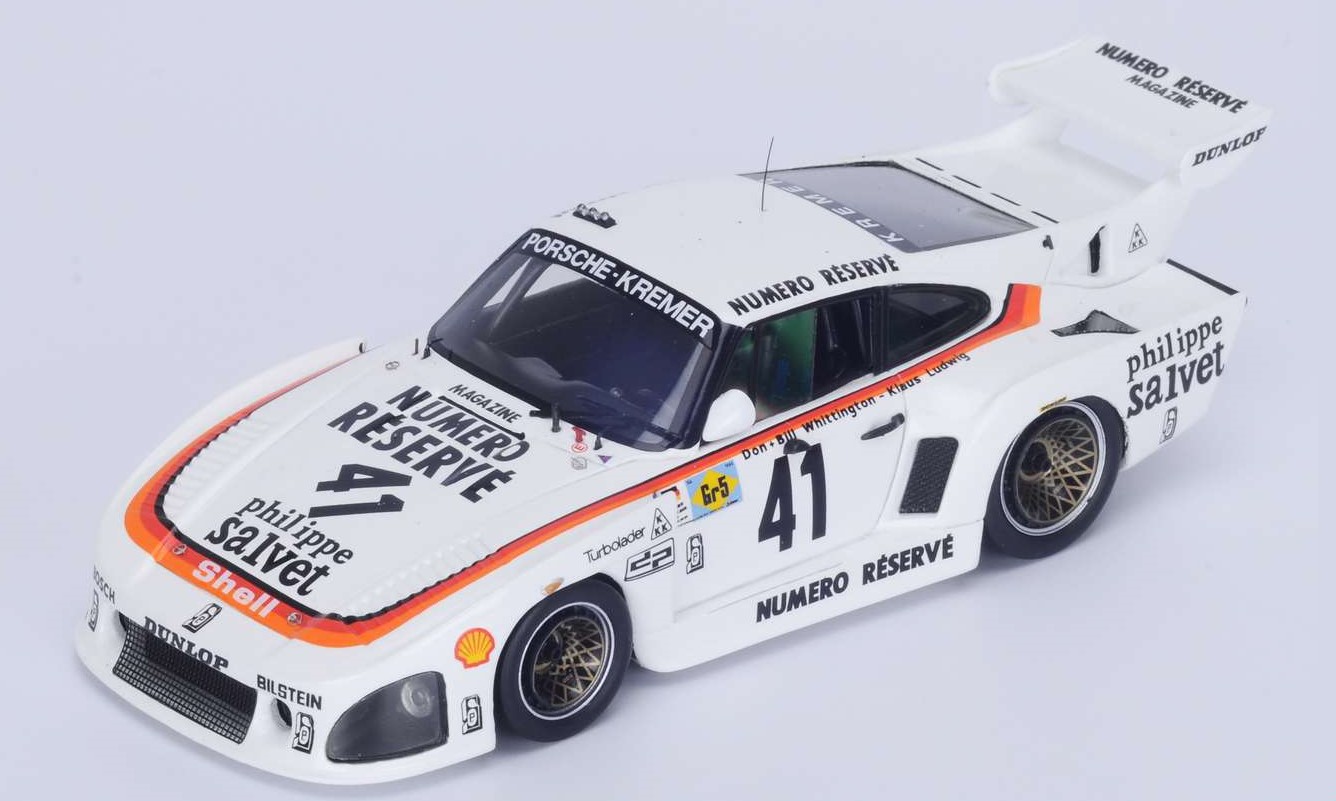 Spark: Porsche 935 K3 1st Le Mans 1979
Spark: Porsche 935 K3 1st Le Mans 1979
The book "Porsche Kremer Racing - The Complete Racing History" is a 392 page limited edition (99 copies) each hand-signed by Manfred Kremer, Klaus Ludwig and the Whittington brothers. The authors are Michael Cotton, Ulrich Trispel and Robert Weber and the text is in English. The cost is 225 euros and is available from www.sportfahrer-zentrale.com
New Additions: September 2020
Welcome to the September monthly update which, regrettably sees no good news on the Covid situation. The Sydney Model Auto Club have understandably canceled the September model fair at Granville so another month with no model shows (All British Day, Collectormania and Hawkesbury Model & Hobby Show have previously announced their September cancellations). It's hard to see a return to normality until early 2121 or later. Although attending model fairs is not possible at the moment, you can still satisfy your collecting passion by ordering online. Just send me an email and I can give you a postage cost to send nationwide and internationally (pick up available in Sydney area). However, please note that Australia Post are not sending to some countries due to Covid-19. Ok, so what's new and interesting this month?
An excellent documentary was aired recently on TV called "Hitler's Supercars" which charts the rise of Germany's racing cars in the late 1930's. Under the orders of Hitler himself, drivers risked their lives smashing records that the Third Reich exploited for propaganda. One such project featured in the documentary, was to break the land speed world record of 595.04 kph (370 mph) at that time held by Englishman John Cobb and Mercedes-Benz produced a three-axled, 27-foot long car powered by a V12 44.5-litre aircraft engine (an increased displacement derivative of the engine used in the Me-109 fighter). This car was the T80 which was capable of producing 3,500 horsepower and Germany looked likely to break the record with a target speed of 750 kph (466 mph). Unfortunately, World War II broke out before an attempt could be made; the car was stored away and survived the war but the project was never revisited. The T80 is now on display at the Mercedes Museum in Stuttgart. Dutch model maker Neo, have produced an excellent model of this car.
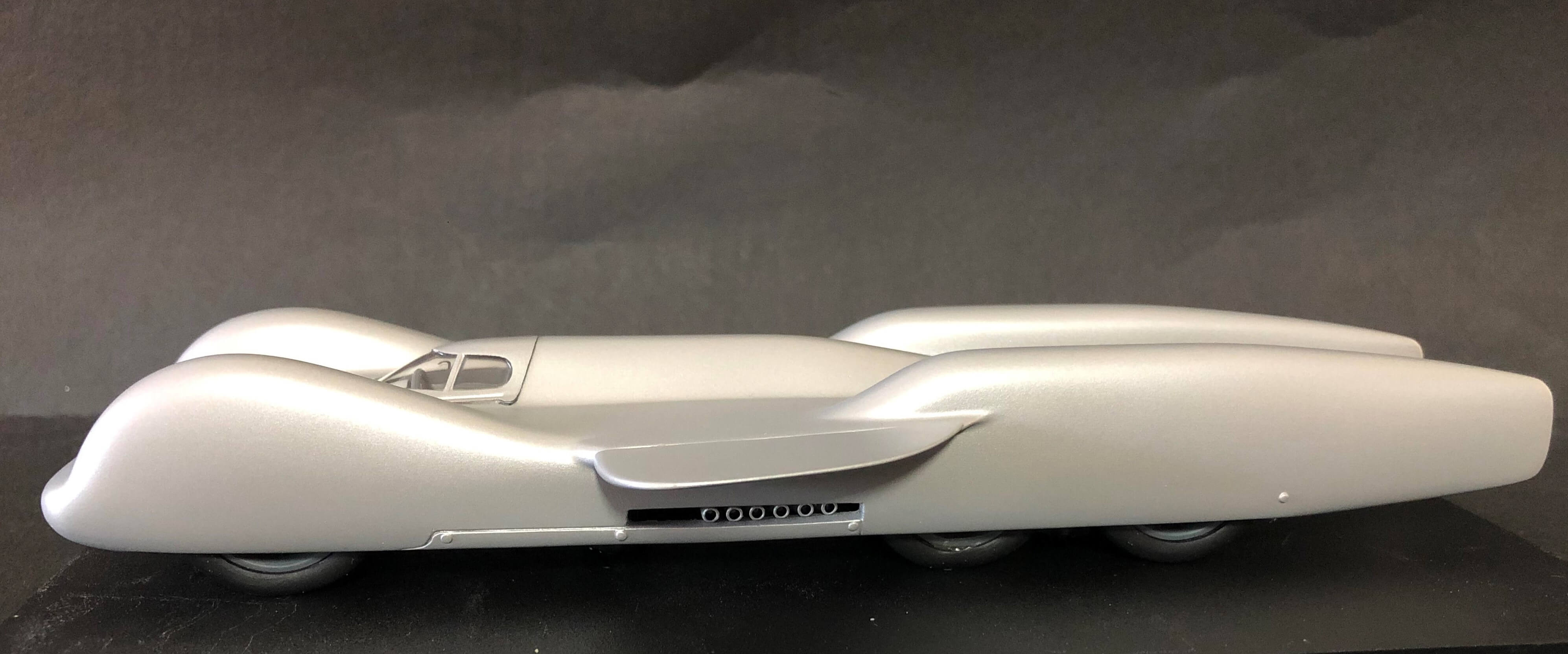 Neo: Mercedes-Benz T80 Speed Record car 1939
Neo: Mercedes-Benz T80 Speed Record car 1939
Edicola is a new brand that I've added to my stocklist this month. Edicola is not actually a diecast model maker but is a brand under the Altaya Partworks umbrella. Altaya sources their models from different manufacturers and these Edicola Le Mans models are made by Spark. Being Partworks models, they come packaged in a cardboard-backed blister pack but with the same acrylic cover found on regular Spark models. Also, instead of the wooden base used for Spark models, the Edicola models have a plastic base and the price is much cheaper. The quality is very good; I've done a direct comparison between a Spark model against the Edicola version and found the panel lines are not as sharp on the Edicola version. This leads me to believe the Edicola may be a diecast model rather than a resin cast one.
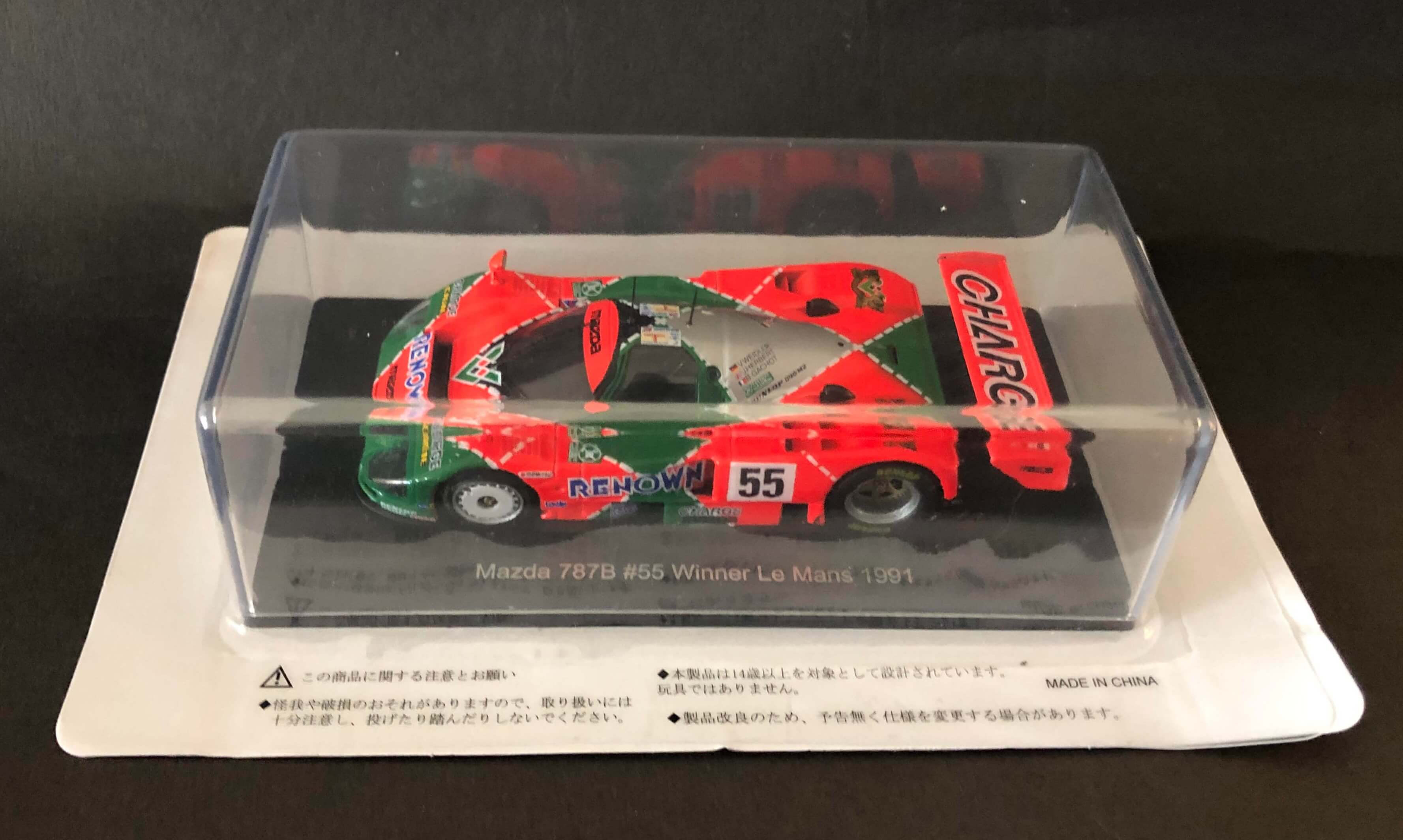 Edicola/Spark: Mazda 787B 24H Le Mans 1991
Edicola/Spark: Mazda 787B 24H Le Mans 1991
Another interesting model for Australian collectors in particular, is the Porsche 935 driven by Rusty French in the Adelaide round of the 1982 Australian GT Championship. The 1982 championship was dominated by Alan Jones, also in a Porsche 935 who won all nine rounds. French was second but would win the championship the following year in a 935. The Spark model is limited to 500 pieces.
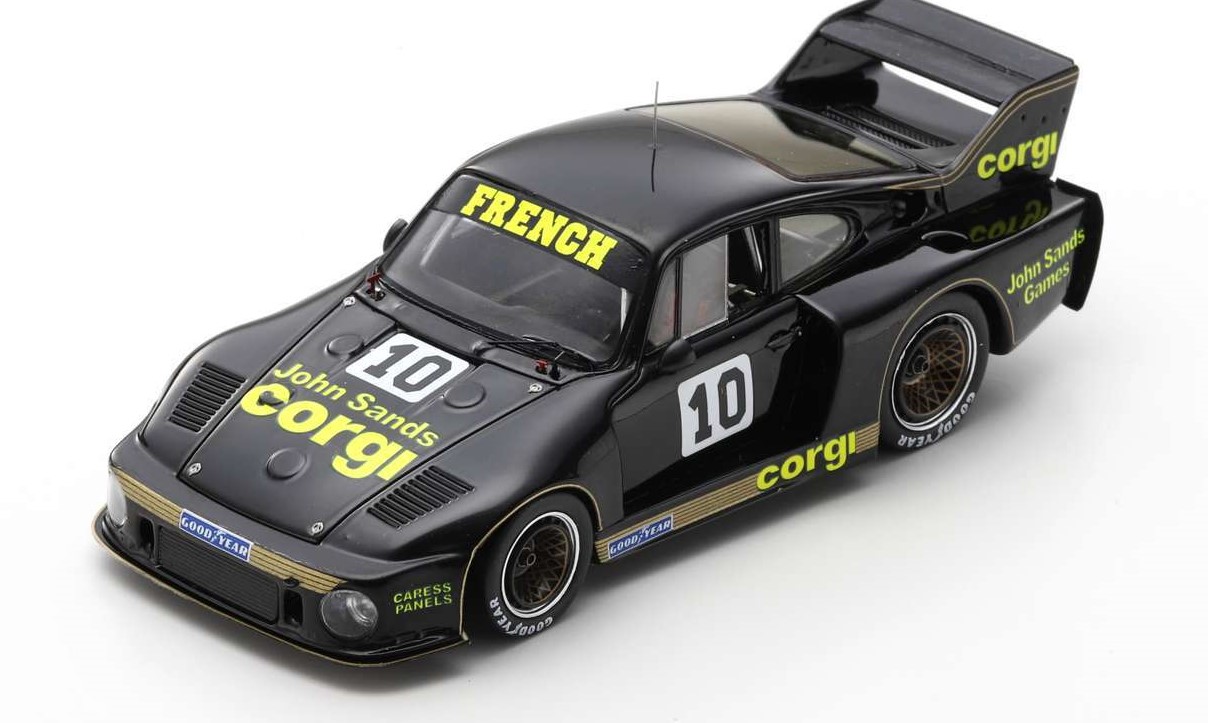 Spark: Porsche 935 R.French 1982 GT Championship
Spark: Porsche 935 R.French 1982 GT Championship
This month, I've decided to put all White Box models on SALE. So, for the month of September the price of all White Box models will be reduced by 20%. There are 38 different road cars to chose from, all in 1:43 scale.
Finally, quite a few collectors have asked me to look for models that are no longer available from shops and dealers, so I've decided to put together a list of these models on a separate page called "Models Wanted". Please have a look to see if you have any of these listed models and if you wish to part with them, please send me an email and we can start a discussion. All are Spark models which are very popular and sell out quickly, also Spark do not re-release models very often so really, the only way to obtain them is through other collectors. Thanks for checking out the list.
OK, that's it for another month so until next time, happy collecting.
Formula One
- 1978 Brabham Alfa BT45C, N.Lauda (1) 2nd Argentine GP (Spark)
- 1963 BRM P57, L.Bandini (3) 5th British GP (Spark)
- 2012 HRT Ford F112, N.Karthikeyan (23) Monaco GP (Spark)
- 2017 Red Bull Tag Heuer RB13, D.Ricciardo (3) Chinese GP (Minichamps)
Partworks F1 Collection by Panini
- 1979 Alfa Romeo 177, V.Brambilla (36) Italian GP (Issue 94)
- 1962 BRM P57, G.Hill (17) World Champion (Issue 100)
- 1979 Williams Ford FW07, C.Regazzoni (28) race car (Issue 79)
- 2014 Williams Mercedes FW36, V.Bottas (77) race car (Issue 92)
Australian Race Series
- 1982 Porsche 935, R.French (10) Aust. GT Champioship, Adelaide (Spark)
Le Mans
- 2000 Audi R8, Biela/Pirro/Kristensen (8) 1st Le Mans (Edicola/Spark)
- 2008 Audi R10 TDI, Capello/Kristensen/McNish (2) LM Winner (Edicola/Spark)
- 2003 Bentley EXP Speed 8, Kristensen/Capello/Smith (7) Le Mans winner (Edicola/Spark)
- 1976 BMW 3.5 CSL, Posey/de Fierlant/Grohs (42) Le Mans (Edicola/Spark)
- 1968 Ford GT40, Rodriquez/Bianchi (9) Le Mans winner (Edicola/Spark)
- 1991 Mazda 787B, Weidler/Herbert/Gachot (55) Le Mans Winner (Edicola/Spark)
- 1995 McLaren F1 GTR, Dalmas/Lehto/Sekiya (59) LM winner (Edicola/Spark)
- 1981 Porsche 936/81, Ickx/Bell (11) "Jules" Le Mans winner (Edicola/Spark)
- 1984 Porsche 956L, Pescarolo/Ludwig/Johansson 1st LM (7) Newman (Edicola/Spark)
- 1978 Renault Alpine A442B, D.Pironi/JP Jaussaud (2) Le Mans winner (Edicola/Spark)
Land Speed Record Car
- 1939 Mercedes-Benz T80 in silver (Neo)
1:18 Models
- 1969 Holden Hurricane Concept Car in orange (Apex Replicas)
After Thoughts: "From Tragedy to Triumph - The McLaren M8D." On 2nd June 1970, Bruce McLaren was pulling in and out of the pits at the Goodwood circuit, making adjustments to the rear wing to cure an oversteer issue on the team's latest Can-Am race car. At 12:19 McLaren left the pits and at the fast left-hand kink leading on to the main straight part of the tail section lifted at 170 mph which sent the car into a spin. The car struck a marshals' protective embankment with such force that McLaren was thrown from the wreckage and was killed instantly. The car in which Bruce McLaren tragically lost his life was the McLaren M8D.
The story of the McLaren M8D starts with its predecessor, the M8B (the M8C was a customer version of the M8A) which was raced successfully for the 1969 Can-Am season. In fact, the M8B in the hands of Bruce McLaren and Denny Hulme won all 11 races that year, with Bruce winning the championship. The M8B used a rear wing that was mounted high on pylons which were attached directly to the suspension uprights. This arrangement allowed the car to run softer springs than would've been required had the enormous rear wing been attached to the bodywork. For the 1970 season, the rulemakers banned the high strut mounted rear wings, which were susceptible to failure so the new M8D was designed with a pair of tail fins which acted as fences to channel airflow over a wide, low-mounted wing located eight-inches above the rear bodywork. The distinctive appearance earned the car the nickname "the Batmobile". Because the rear wing was less aerodynamically efficient than the high wing of the M8B, the team compensated by seeking more horsepower from the Chevrolet engine. A new silicone-aluminium Chevrolet 7.6-litre block was acquired, giving 670 bhp (compared with 630 bhp from the 7-litre engine on the M8B).
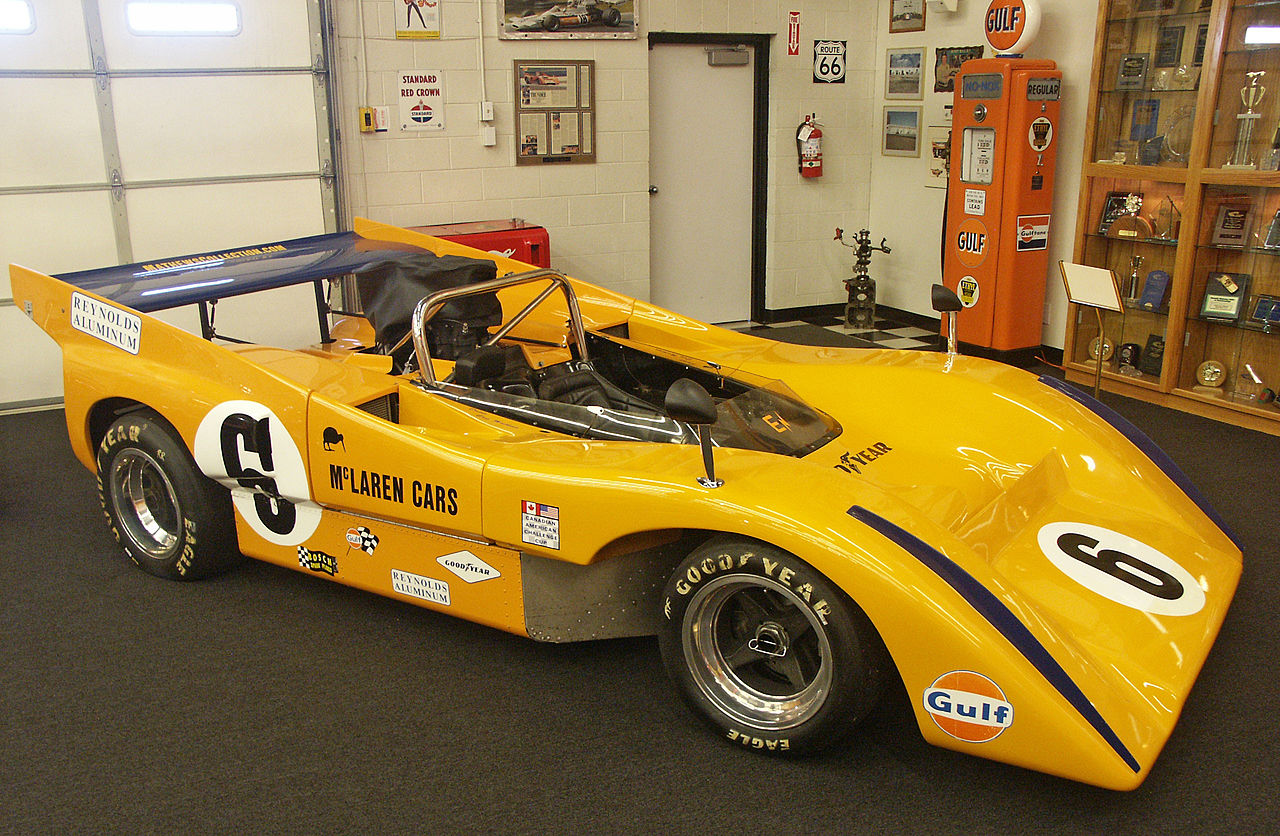 McLaren M8D, Mathews Collection, Colorado (D.Wildhirt)
McLaren M8D, Mathews Collection, Colorado (D.Wildhirt)
Just twelve days after the testing accident at Goodwood, a sombre McLaren team assembled for the first Can-Am race on the calendar; Mosport Park, Canada. Without their team leader, they were down one driver and to compound the situation Hulme was still recovering from severe burns to his hands. While practising for the Indy 500, Hulme's car had caught fire when the fuel filler cap opened out on the track and although bailing out from his moving car he suffered burns to his hands and feet. Dan Gurney, who had scaled back his international appearances in favour of developing and driving his Indy cars, stepped forward to volunteer his services to the team. Gurney's legendary height meant the M8D had to be hastily modified, including an extra high windscreen and an extension piece on the roll bar, also a Gulf logo patch was hastily taped over the Castrol patch on his driving suit. Despite never seeing or sitting in the M8D prior to Mosport, Gurney was fastest in practice and qualifying, in fact, his pole time broke the qualifying record for both Grand Prix and Can-Am cars. During the race, the two McLaren M8D cars were in a constant battle with the only other competitive car present, the Autocoast TI-22 driven by Jackie Oliver. In the end, Gurney won a famous victory in the M8D, with Oliver second and Hulme in third.
Gurney won the next race at St. Jovite but retired during the third race at Watkins Glen, where Hulme claimed the win using a 7-litre Chevrolet to combat overheating issues with the 7.6-litre engine. After Watkins Glen, Gurney who was loyal to longtime sponsor Castrol, left the team; the politics of oil company contracts finally forcing him to leave. His seat was taken over by Peter Gethin who was also remarkably quick to adapt to the M8D. Hulme won the next two races, at Edmonton and Mid-Ohio while Gethin won at Road America. At the seventh round at Road Atlanta, the M8D faced some really stiff competition. Vic Elford in a Chaparral 2J with its two suction fans, was over 1.25 seconds faster than Hulme in qualifying; it was the first time since 1967 that a McLaren team car had not sat on pole for a Can-Am race. After an eventful race where all the front-runners suffered various problems and accidents, a tiny 3-litre powered Porsche 908 driven by Tony Dean greeted the chequered flag. It was the end of an era, for it marked the first time in 19 races that the McLaren team had been shut out of the winner's circle in a Can-Am race.
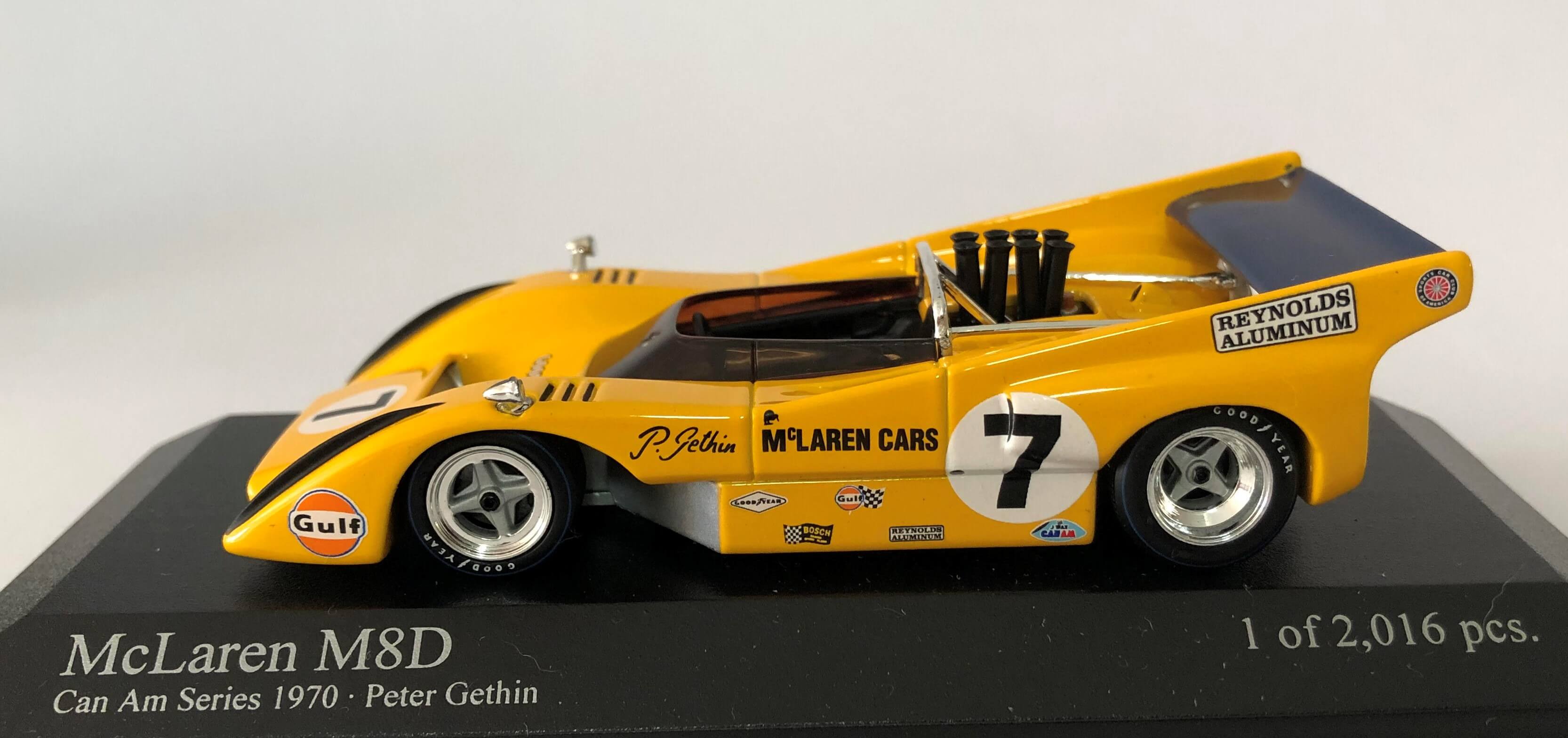 Minichamps: McLaren M8D Peter Gethin 1970
Minichamps: McLaren M8D Peter Gethin 1970
The situation returned to normal for the last three races where Hulme was victorious in the M8D. Hulme had won the 1970 Can-Am Championship in a canter, with Lothar Motschenbacher (McLaren M8C) in second and Peter Gethin in third. From a season starting with tragedy, it ended triumphantly for the M8D and the McLaren team.
New Additions: August 2020
Welcome to the August monthly update. The Covid situation remains grim; rather than restrictions on social gatherings easing they have been tightened in the last week or so due to the number of daily infections in NSW showing no signs of diminishing. So, under the current climate, the organisers had no option but to announce there will be no model fair at Granville again this month. Also, the organser of the All British Day scheduled for 13 September has cancelled the show for this year. Ok, so what new models deserves a mention this month ...
During the fledgling years of the William's F1 team, Frank Williams ran a couple of Iso-Marlboro FX3B Fords in 1973. New Zealander Howden Ganley drove one car for the entire season but the other car was shared between eight drivers. One of these was another New Zealander, Graham McRae who was well-credentialed having won the Tasman Series three years in a row (1971-73) and was the US F5000 Champion in 1972. He had been offered a one-off drive in 1972 to replace an ill Jackie Stewart at the Belgian GP in the competitive Tyrrell team but McRae's busy race schedule precluded this drive. McRae did accept Frank Williams' offer to race the uncompetitive Iso-Marlboro at the 1973 British GP but his race ended before completing a lap when throttle issues caused his retirement. The 1973 British GP was notable for the fact that 4 New Zealanders started the race (Hulme, Ganley, Amon and McRae), an occasion probably never to be repeated.
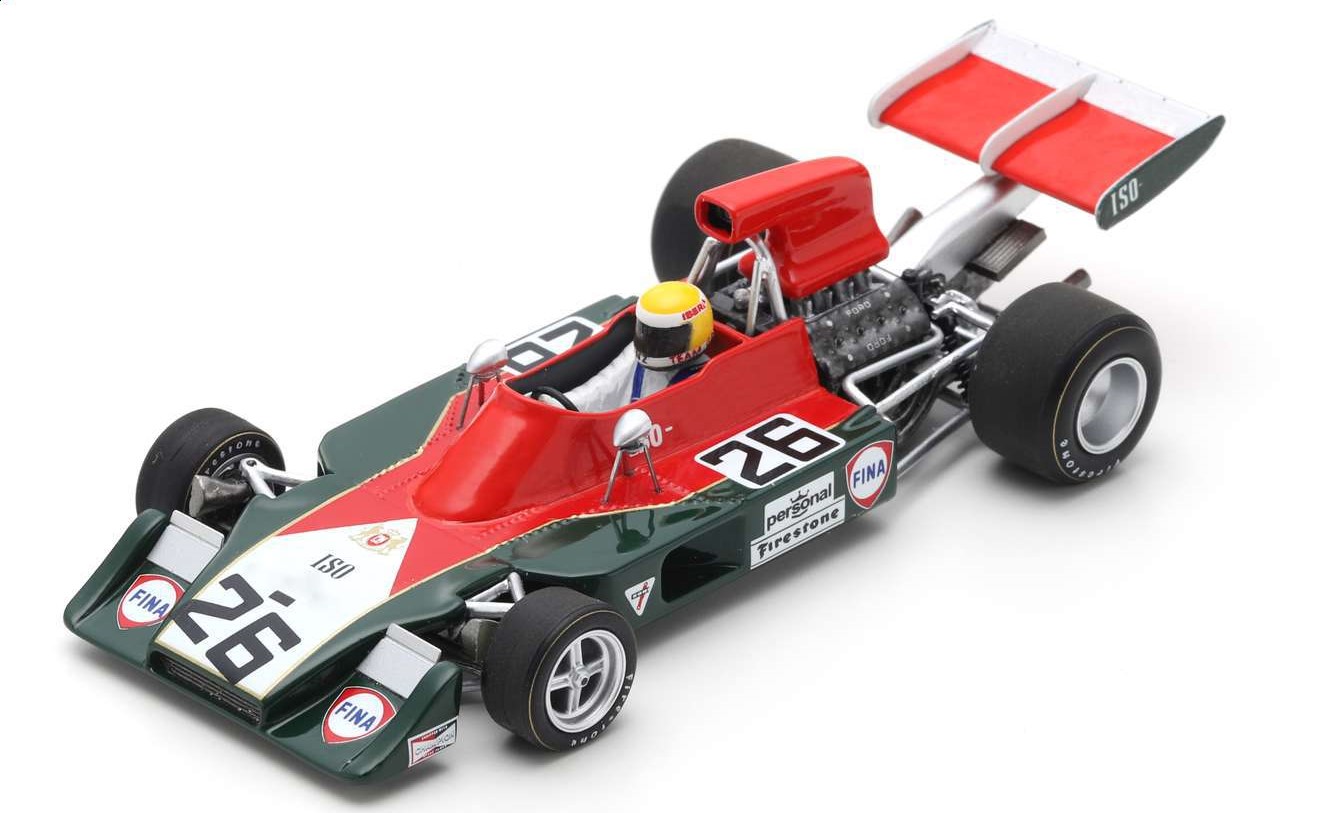 Spark: Iso-Marlboro Ford FX3B 1973 G.McRae
Spark: Iso-Marlboro Ford FX3B 1973 G.McRae
I recently received another shipment of Partworks F1 Collection models by Panini. These models continue to represent good value for money and the collection now extends to 117 issues. As I have some good stock levels of these models, I've decided to have a SALE, so just for the month of August all Partworks F1 cars will be reduced to just $10.00 each. Please note, these models do not come with the magazine. A good reference site for these models is https://needswapgot.com/collections/panini-f1-car-collection-uk
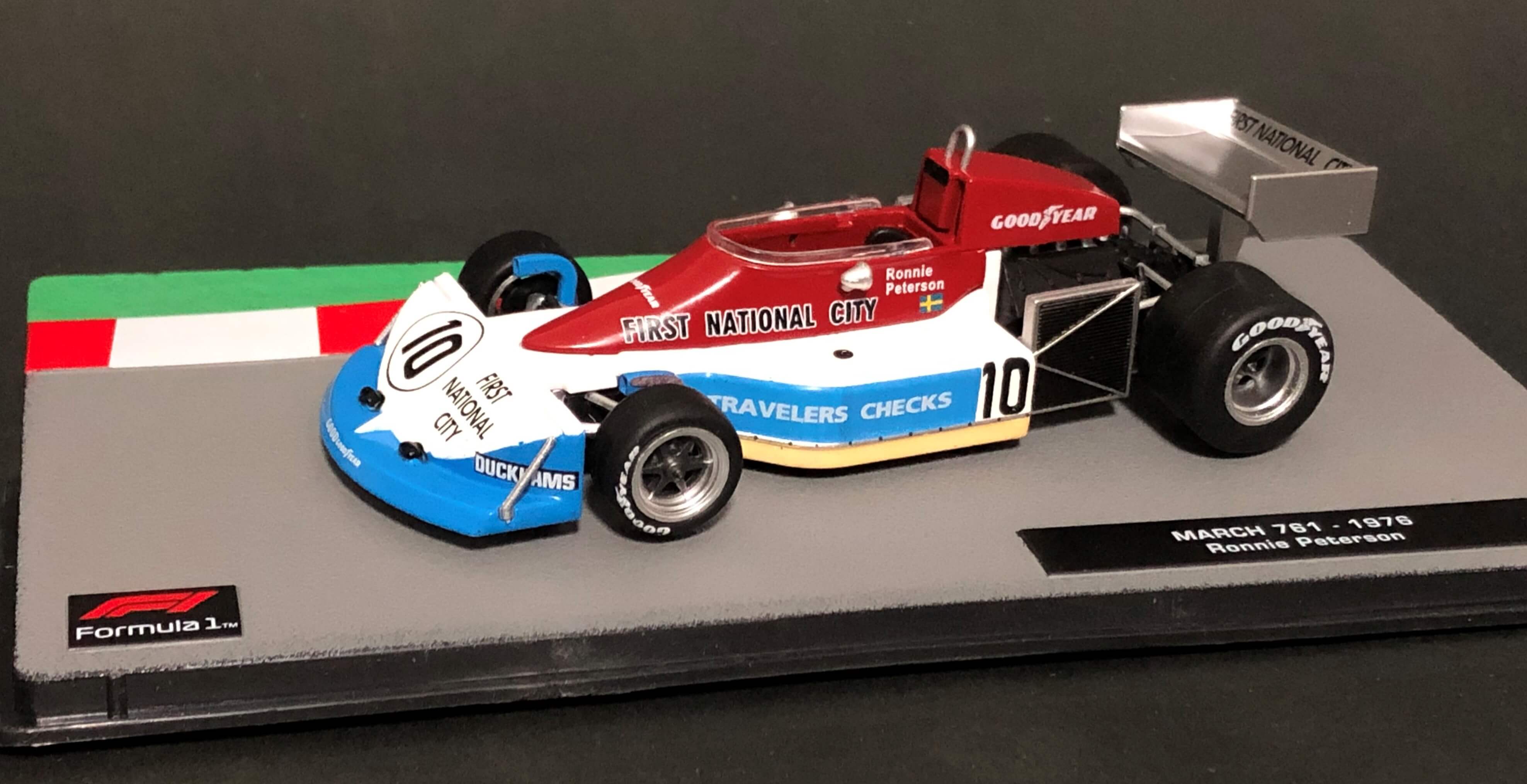 Partworks F1 Collection: March Ford 761 - Issue 87
Partworks F1 Collection: March Ford 761 - Issue 87
Another interesting addition this month is not a model car but an accessory to embellish your car display. French manufacturer, Norev have just released a set of 2 metal barriers in 1:43 to keep the crowd from getting too close to your model car. These barriers can be interlinked and would look great in your display cabinet or diorama. They have a little bit of a weight to them so they are made from metal, definitely not plastic.
OK, that's it for another quiet month. Let's see what September holds, until then happy collecting.
Formula One
- 1973 Iso-Marlboro Ford FX3B, G.McRae (26) British GP (Spark)
- 1984 McLaren TAG MP4/2, A.Prost (7) 1st German GP (Spark)
Partworks F1 Collection by Panini
- 2000 BAR Honda 002, J.Villeneuve (22) race car (Issue 85)
- 1969 Brabham Ford BT26A, J.Ickx (6) race car (Issue 89)
- 1953 Ferrari 500 F2, N.Farina (2) race car (Issue 90)
- 1979 Ferrari 312 T3, J.Scheckter (11) Argentine GP (Issue 83)
- 2013 Ferrari F138, F.Alonso (3) race car (Issue 97)
- 1975 Hesketh Ford 308B, A.Jones (26) Monaco GP (Issue 96)
- 2010 HRT Ford F110, B.Senna (21) race car (Issue 99)
- 2003 Jaguar Cosworth R4, M.Webber (14) race car (Issue 91)
- 1979 Lotus Ford 80, M.Andretti (1) race car (Issue 93)
- 2012 Lotus Renault E20, K.Raikkonen (9) race car (Issue 95)
- 1976 March Ford 761, R.Petersen (10) race car (Issue 87)
- 1974 McLaren Ford M23, E.Fittipaldi (5) World Champion (Issue 84)
- 2017 Mercedes AMG W08, L.Hamiton (44) World Champion (Issue 81)
- 1977 Renault RS01, J.P.Jabouille (15) race car (Issue 82)
- 2004 Toyota TF104B, J.Trulli (16) race car (Issue 88)
- 1984 Toleman Hart TG184, A.Senna (19) Portugese GP (Issue 86)
- 1978 Tyrrell Ford 008, P.Depailler (4) race car (Issue 98)
Le Mans
- 1966 Ford GT40 Mk ll, Miles/Hulme (1) 2nd Le Mans (Spark)
- 1958 Lotus Elite, J.Clark (59) Brands Hatch (Spark)
Road Cars
- 1979 BMW M1 in white (Maxichamps)
- 1957 Ford Fairlane 500 Hard-top in black/white (Neo)
- 1976 Peugeot 504 Coupe in brown metallic (Maxichamps)
- 1960 Plymouth Fury Coupe in light beige/black (Neo)
- 1956 Pontiac Star Chief Convertible in blue/black (Neo)
- 1963 Studebaker Champ Pick-Up in red (Neo)
Accessories (1:43)
- Portable Barriers - set of 2 (Norev)
After Thoughts: "A Moment in Time - Monza 1957." 1957 was a break-through year for the Vanwall F1 team. Formed in the early 1950's by Industrialist Tony Vandervell, the first Vanwalls were built for the 1954 season but the cars ran without any success for a couple of seasons. Vandervell was then persuaded to employ the services of a young but untried designer to improve his cars for 1956; the designer was Colin Chapman. The new space-frame car designed by Chapman and aerodynamist Frank Costin showed early promise by winning the non-championship race at Silverstone and then scored a fourth place in the championship Belgian GP.
For the 1957 season, Stirling Moss had been signed alongside Tony Brooks and Stuart Lewis-Evans and as the season unfolded the cars became faster and more reliable. By the time of the British GP at Aintree, Fangio had a commanding lead in the championship with three wins but was destined to suffer a rare retirement at Vanwall's home GP. Moss held a commanding lead in the race until an engine misfire caused him to retire his car and to take over Brooks' car which was then in 9th position. Moss went on to a famous victory overtaking cars but helped by the misfortune of some of the leading cars. This was to be the first win by a British-built car in the World Championship.
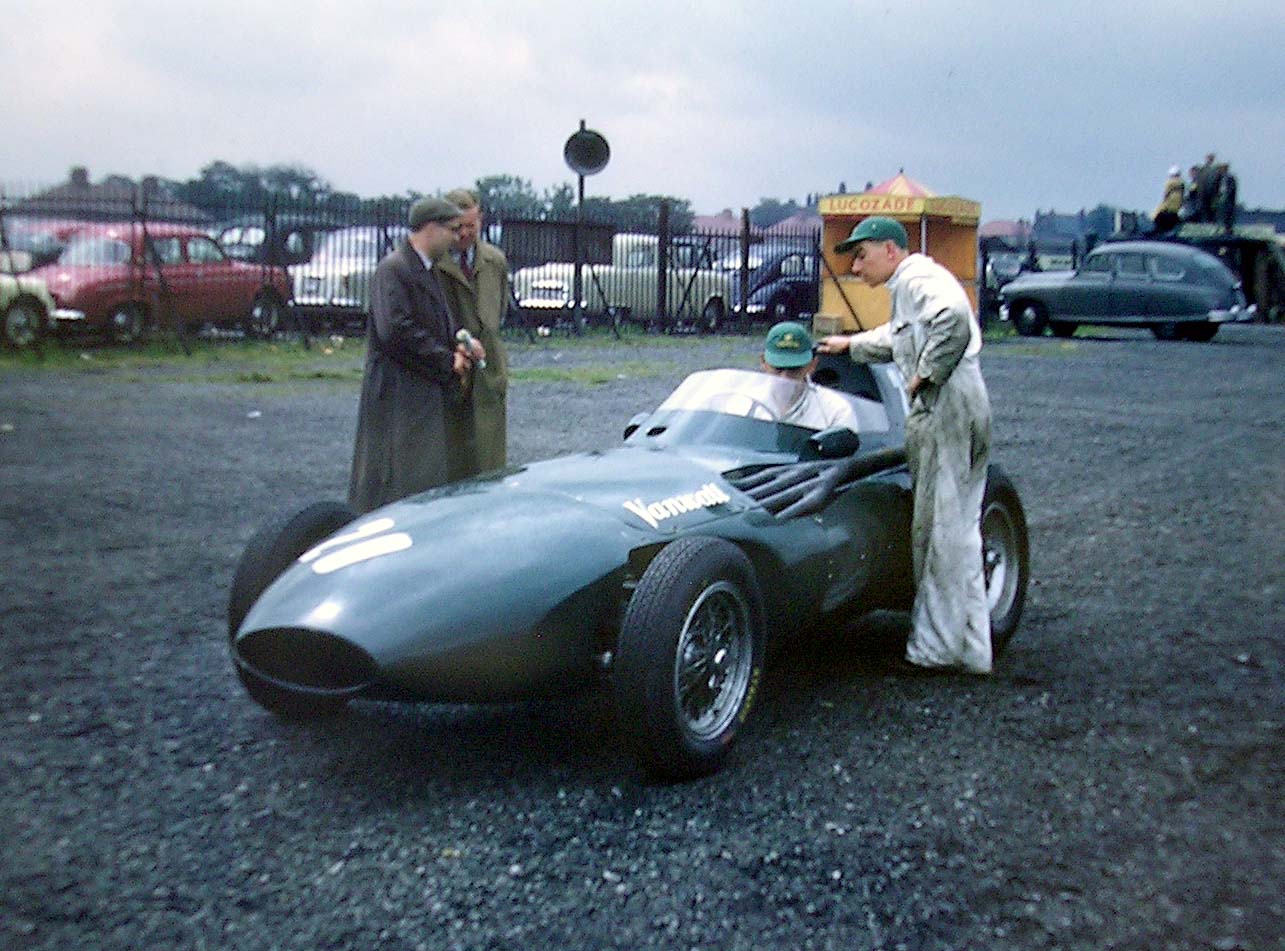 The Brooks/Moss Vanwall at the 1957 British GP (Photo: T.Whalebone)
The Brooks/Moss Vanwall at the 1957 British GP (Photo: T.Whalebone)
Two races later the championship moved to Italy for the Pescara GP. Fangio, in his Maserati 250F had already won his 5th world championship at the preceding race in Germany. The Pescara circuit, the longest ever circuit to host a F1 GP at 25.8 km, was renowned at the time as one of the most difficult and dangerous route for a motor race. The circuit was so dangerous that Enzo Ferrari, in a rare show of compassion for his drivers did not send his team to Pescara. After three hours of racing, Moss in his Vanwall fought off the challenge from the Maserati drivers for another famous win for the British team.
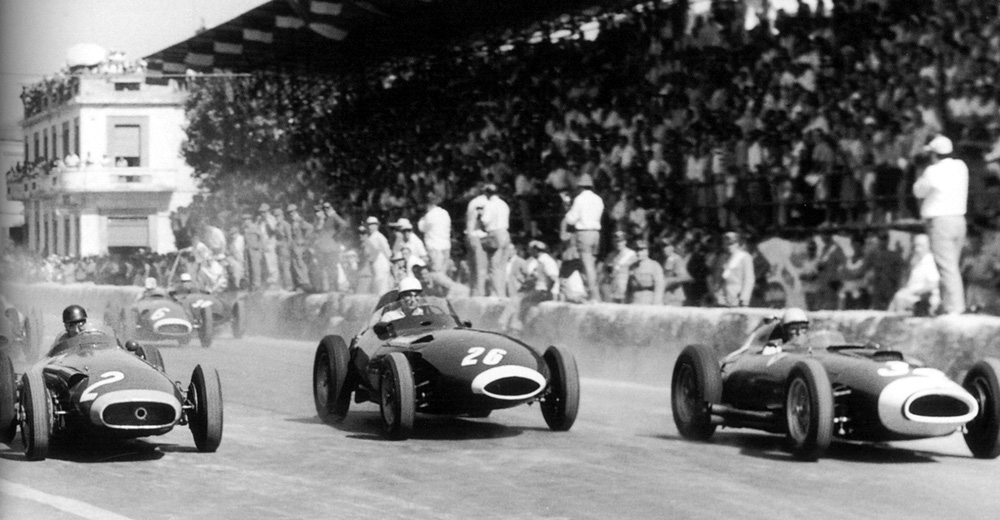 Start of the Pescara GP. L to R. Fangio, Moss, Musso
Start of the Pescara GP. L to R. Fangio, Moss, Musso
The next race, the final of the season was held at the imposing Monza circuit where the Vanwalls faced no fewer than eleven Maseratis and four Ferraris. The Vanwall win at Aintree was "at home", the win at Pescara was against a dimiinshed field but if Vanwall could win at Monza, they could prove beyond doubt they were capable of beating the greatest Italian race cars at their home Grand Prix and in front of a passionate, partisan crowd. Every year before Monza the two Italian teams test their cars a week before the race and Fangio, in the 12-cylinder Maserati had unofficially lapped in 1 min 44 seconds. When official practice started, Fangio lowered the mark to 1 min 43.1 sec but Moss was undaunted and ended the first practice session with a 1 min. 42.7 sec. Then on the second day of practice, Lewis-Evans, the junior Vanwall driver managed a lap of 1 min 42.4 sec and Brooks joined in with a 1 min 42.9 sec to show the Vanwalls were clearly the pace-setters. The two days of practice had been truly memorable, with the Vanwall team in complete command and taking the first three starting positions. For the British fans, it was a wonderful sight to see the first row filled with green cars and behind them came row after row of red cars.
With the cars formed up for the start, everyone started to inch forward even before the flag fell (no jump starts back then) and then they were off, with Moss leaping to the lead with the screaming pack hard on his heels. On the fourth lap, Behra (Maserati) sailed past Moss going down the back straight with the first five cars running nose to tail, with only a foot or two between each car. Every kilometre of the race was being hotly contested, the cars running two and three abreast through the corners. On lap seven, the order was Fangio, Moss, Brooks, Lewis-Evans and Behra; the rest of the field trailing along in the rear. The lead continued to see-saw between the five leaders and they finished each lap in a tight bunch. The pace was so hot that someone had to give in and on lap 20, Brooks pitted with a stuck throttle losing a lap to the leaders. Then on lap 23, Lewis-Evans signalled distress to his pit having cracked the head of his Vanwall. Fangio and Behra now backed off the pace, allowing Moss to get ahead but hoping he too would have problems like his team mates. Behra had to make a routine pit stop which left just Moss and Fangio on the same lead lap. By lap 40 Moss was leading Fangio by 17.5 seconds and it was obvious the World Champion was playing a waiting game, hoping the Vanwall would break down. But after Fangio made his pit stop for rear tyres, Moss was nearly a full lap ahead. At lap 55 of 87, a lull had settled on the race with little chance of overtaking so it became a waiting game to see who was going to break down first. By lap 68, Moss had managed to put a lap on Fangio in second place but when Moss made a pit-stop on lap 77 to change a tyre and to add some oil to the tank, Fangio went by to be back on the same lap as Moss. The Vanwall driver kept his cool and amid much rejoicing by the British fans, Moss crossed the line to win Vanwall's third GP and the first British win at Monza having beaten the full force of Italy on its home ground in a straight fight. It was a nice birthday present to Mr. Vandervell; he was 57 on the day of the race.
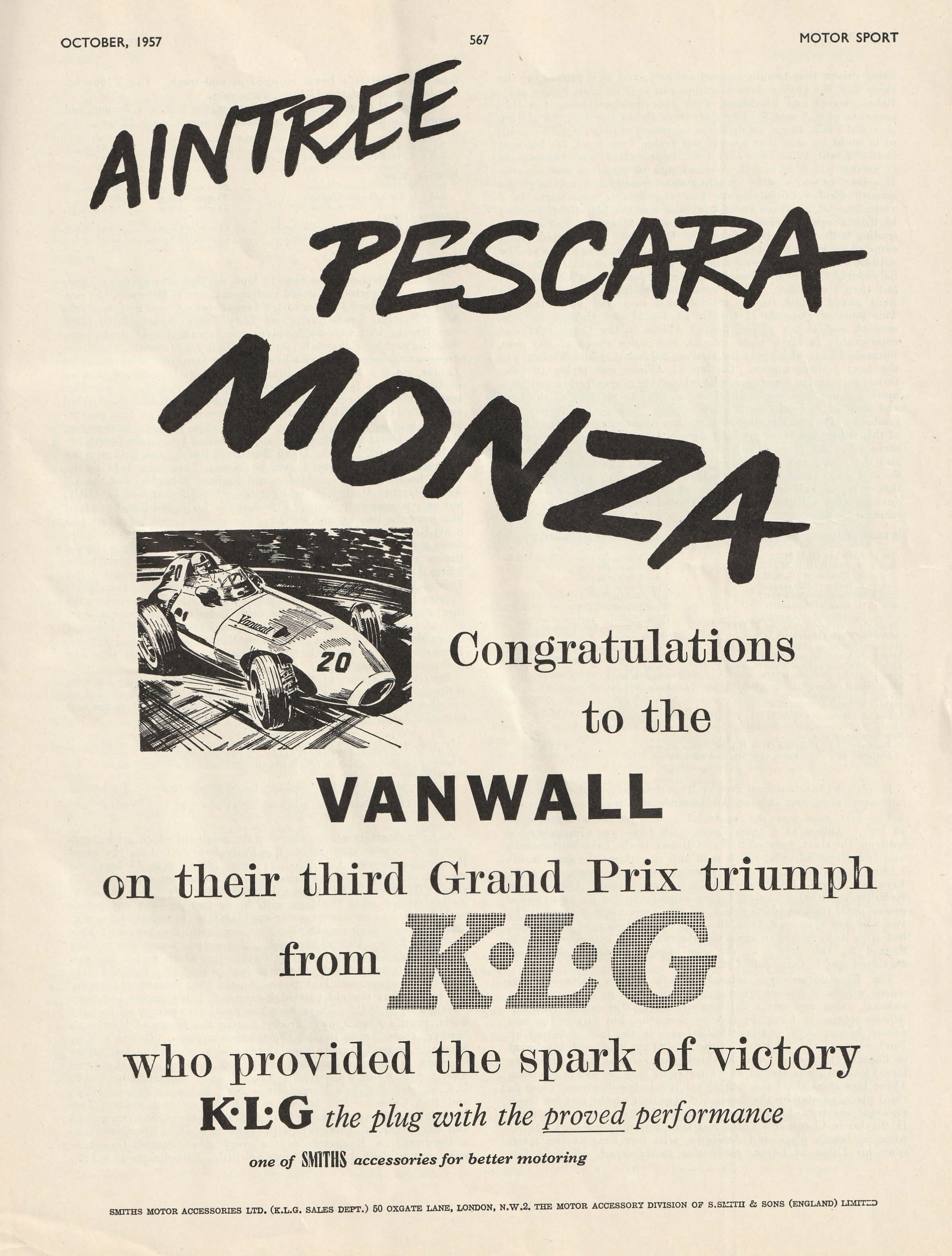 Celebrating Vanwall's three GP wins in 1957 (Motorsport Oct 57)
Celebrating Vanwall's three GP wins in 1957 (Motorsport Oct 57)
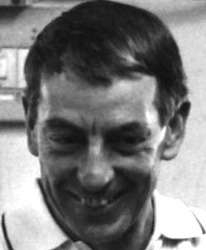 Vale Ron Tauranac AO (13 January 1925 – 17 July 2020)
Vale Ron Tauranac AO (13 January 1925 – 17 July 2020)
New Additions: July 2020
Welcome to another monthly update; can you believe we're already half way through 2020? The Covid pandemic continues to have a profound effect on our lives with a vaccine or cure still some time away. There are no indications yet regarding re-starting model fairs and swap meets so July will be another barren month. New models are still being released by manufacturers but I'm finding it difficult and expensive to import them into Australia. As the international postal system is under considerable strain, some suppliers are turning to freight delivery companies which are charging higher rates during this crisis.
Nevertheless, I did manage to get a few new models this month, as well a few 'restocked' models and a couple of models deserve a special mention. In March 1975, BMW Motorsport entered two 3.0 CSL cars in the 12 hours of Sebring; one for Hans Stuck/Sam Posey and the other for Brian Redman/Allan Moffat. Jochen Neerpasch, the team manager gathered his drivers together before the race and instructed Stuck to go out and break the Porsches while Redman and Moffat were to take care of their car and win the race. The strategy went to plan with the Stuck/Posey BMW taking the lead but retiring with engine failure after 102 laps of the 8.34 kilometre track. The Redman/Moffat BMW inherited the lead with both Stuck and Posey joining them, sharing the driving in a truly team effort. Going into the last hour, the #25 BMW had a good lead on the second placed Porsche Carrera but with 20 minutes to go, Redman noticed the rear axle temperature gauge had gone off the clock. He had to slow down considerably to save the car while the team monitored the closing gap to the Porsche. The minutes ticked by and the BMW scored an important win. The victory had set up retail success for BMW with sales in the US tripling in the following months.
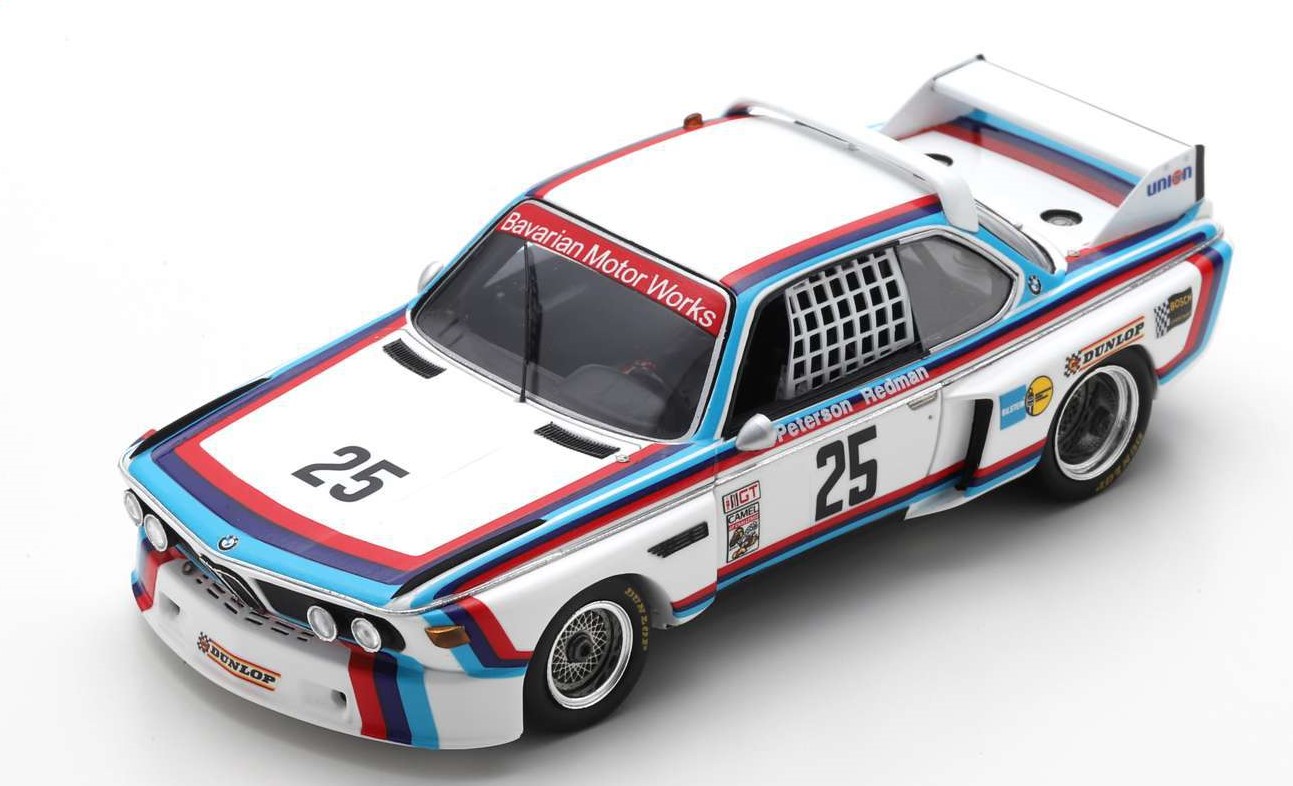 Spark: BMW 3.0CSL 1975 1st Sebring 12 hour
Spark: BMW 3.0CSL 1975 1st Sebring 12 hour
The 1981 Camel GT Championship was the 11th season of the IMSA GT auto racing series and it was a series for GTX class Group 5 cars and for GTO and GTU Grand tourer cars. Group 5 was an FIA classification for "Special Production Cars" that allowed for extensive modifications to production based vehicles. The rules restricted the width of the car so cars were built with standard body widths but with outrageously wide mudguard extensions. The rules also required only the bonnet, roof, doors and rail panels to be left unmodified but left a loophole that Porsche exploited allowing them to lower the nose of the 935. The resulting 'flat-nose' Porsche proved to be highly successful. In the early 1980's Zakspeed, the German racing team prepared a Mustang for Ford USA's Special Vehicle Operations for the IMSA Camel GT series. The Miller Beer sponsored Mustang GTX, built on a Capri chassis used a 1.6L 4-cylinder turbocharged engine that produced upwards of 600bhp and Klaus Ludwig, a German road racing star was hired to drive the Mustang. For the 1981 season, Ludwig won at Brainerd and Sears Points, proving the quickness of the new car, but not necessarily the reliability; he would finish tenth at the end of the season.
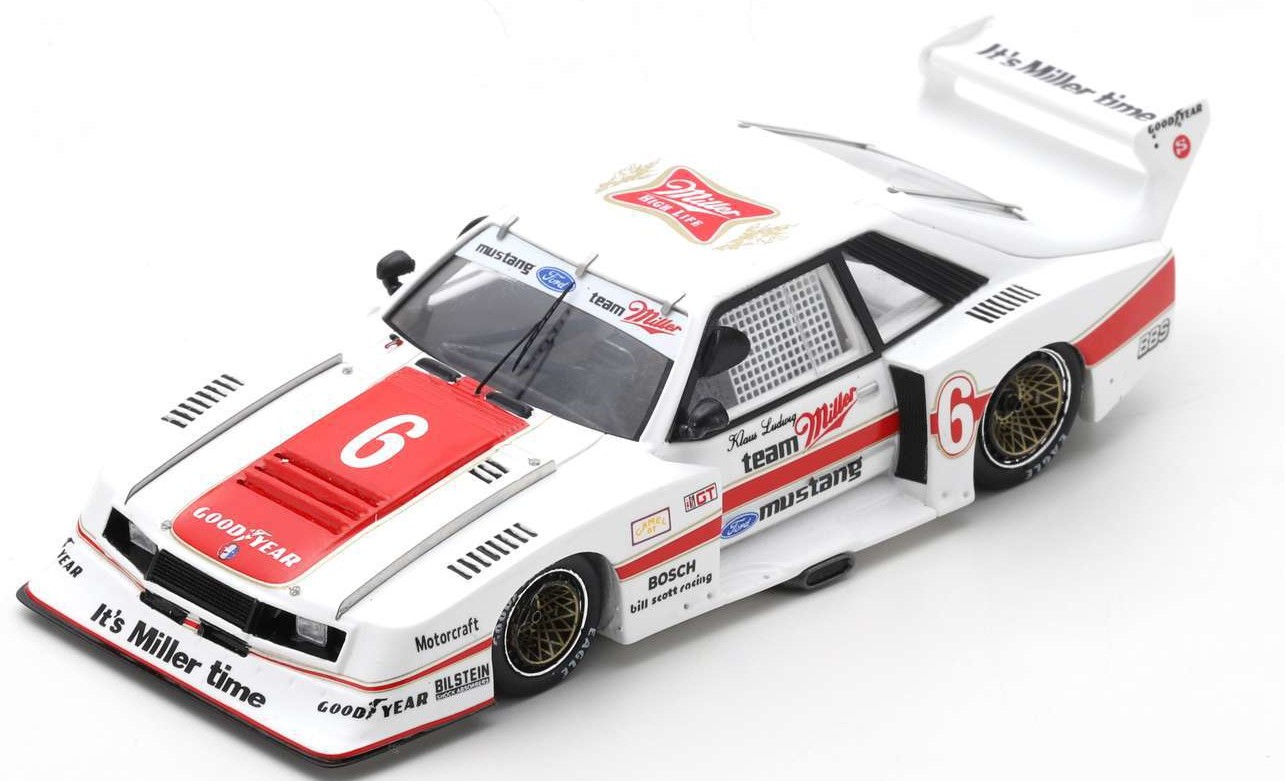 Spark: Ford Mustang GTX Zakspeed 1981 IMSA Camel GT
Spark: Ford Mustang GTX Zakspeed 1981 IMSA Camel GT
OK, that's a wrap for another month. Let's hope August sees more easing of restrictions on gatherings. Until then, happy collecting.
Formula One
- 1962 Cooper Climax T60, B.McLaren (14) 1st Monaco GP (Spark)
- 1990 Ferrari 641, A.Prost (1) British GP winner (La Storia) (Vitesse)
- 1967 McLaren BRM M4B, B.McLaren (16) 4th Monaco GP (Spark)
- 1972 McLaren Ford M19A, D.Hulme (12) 'Yardley' South African GP (Minichamps)
- 2018 Red Bull Tag Heuer RB14, D.Ricciardo (3) 1st Monaco GP (Minichamps)
American Race Series
- 1966 Eagle Ford Mk2, L.Ruby (14) 11th Indy 500 "Bardahl Eagle" (Spark)
- 1975 BMW 3.0 CSL, Redman/Moffat/Posey/Stuck (25) 1st Sebring 12h (Spark)
- 1981 Ford Mustang GTX Zakspeed, K.Ludwig (6) IMSA Camel GT 1st Brainerd (Spark)
Le Mans
- 2016 Ford GT, Briscoe/Westbrook/Dixon (69) 3rd GTEPro Le Mans (TSM)
- 2018 Porsche 919 Hybrid EVO, T.Bernhard (1) Nordschleife Lap Record 5:19:55 (Spark)
- 2019 Porsche 911 RSR, M.Campbell/Ried/Andlauer (77) Le Mans (Spark)
Road Cars
- 1957 Buckle Dart in yellow (built in Sydney) (Autocult)
Helmets
- 2019 Lewis Hamilton - Mercedes-AMG helmet 1:5 (Spark)
After Thoughts: "The Unheralded Drivers Series #3 - George Follmer." Follmer was one of those rare breed of drivers who could race anything and everything, from big Trans-Am cars, brutal Can-Am beasts, Indy cars, NASCARS, Le Mans sportscars through to F1 cars. Born in Phoenix, Arizona in January 1934, Follmer began racing at club level in 1960 and not finding his insurance job exciting enough, he became a professional driver in 1965. He promptly won that year's United States Road Race Championship with his Porsche-powered Lotus 23. He then made his Indycar debut in 1967 and won his first and only Indycar race in 1969 at the Phoenix International Raceway. That season also included Follmer's first Trans-Am victories and he would win the title twice during the 1970's. The 1972 season saw Follmer achieve the rare distinction of winning both the Trans-Am and the Can-Am titles in an AMC Javelin and a Porsche 917/10 respectively.
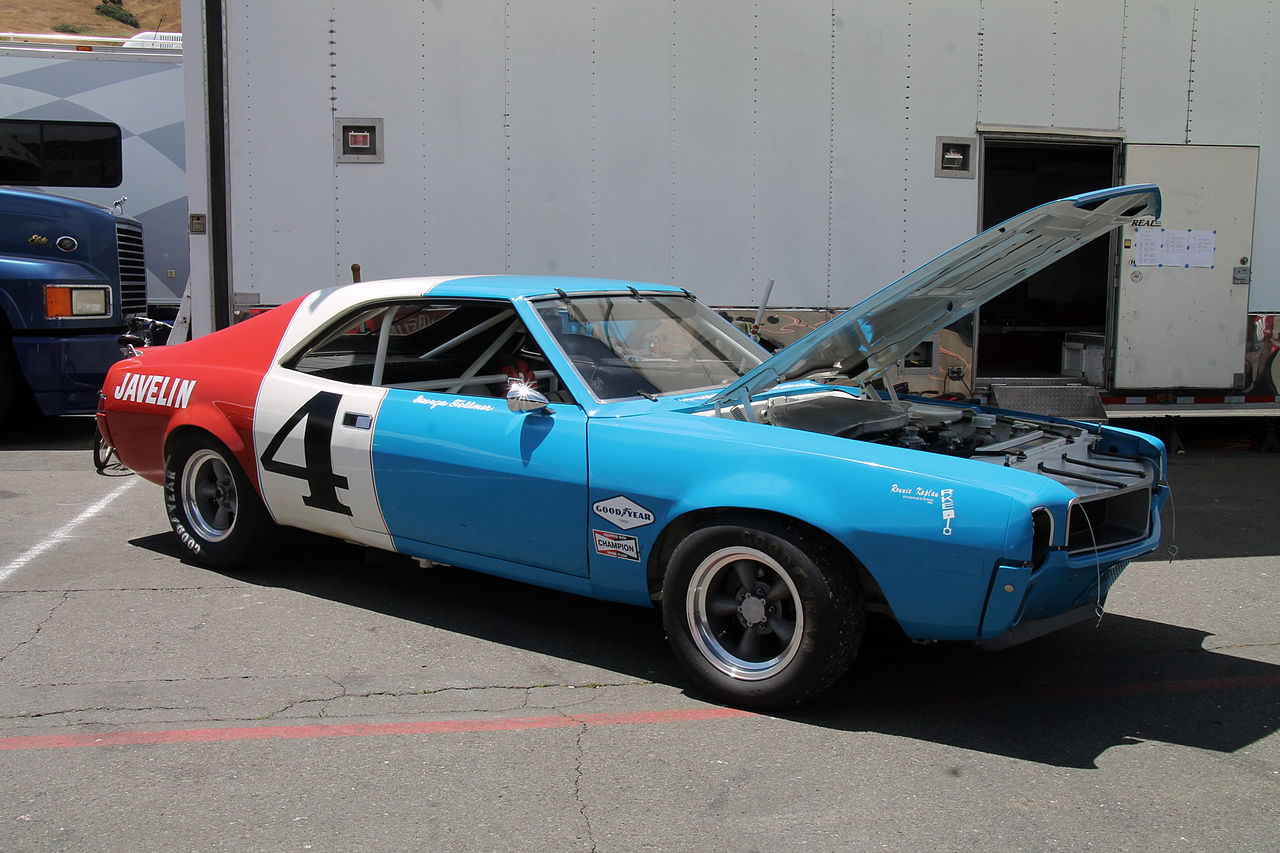 Follmer's 1968 AMC Javelin (Photo: Sarah Stierch)
Follmer's 1968 AMC Javelin (Photo: Sarah Stierch)
George Follmer's next career move was a surprising one; the 39-year old joined the new Shadow F1 team for 1973. Advanced Vehicle Systems was a company founded by Don Nichols in California in 1968 and their cars were called Shadows. The first Shadows (Mk.1) were entered in the Can-Am series with Follmer and Vic Elford doing the driving. Towards the end of 1972, Nichols announced he was entering his team into F1 with a car designed by Tony Southgate (ex-BRM designer) with financial backing from Universal Oil Products (UOP) and with Follmer and Jackie Oliver chosen to debut the new car at the 1973 South African GP. The Shadow DN1 Ford was also made available to Graham Hill who ran his car under the Embassy Hill banner. In his very first F1 race, Follmer finished in a creditable sixth place after qualifying the new car down in 21st. In his second race at the Spanish GP, Follmer improved on his qualifying position to 14th and finished in 3rd place. Unfortunately, Follmer's luck dried up and he wasn't able to score any more points for the remainder of the season finishing the championship in 13th position with 5 points. The Shadow F1 team did not retain his services for the following year.
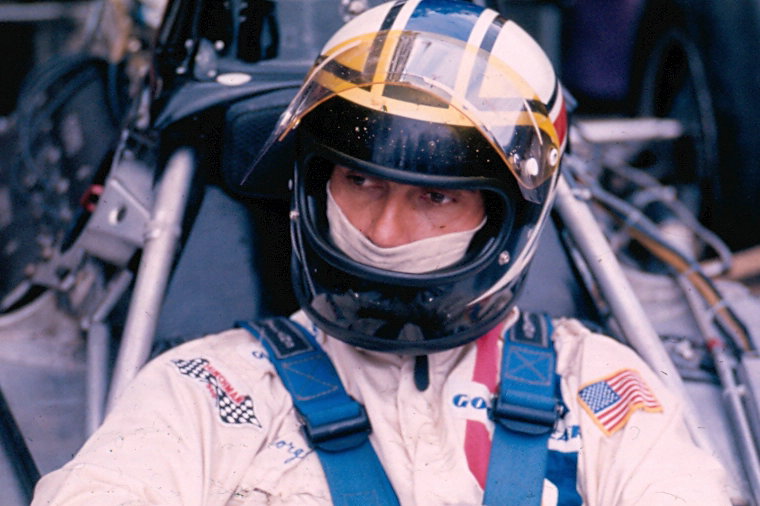 George Follmer 1973 German GP (Photo: Raimund Kommer)
George Follmer 1973 German GP (Photo: Raimund Kommer)
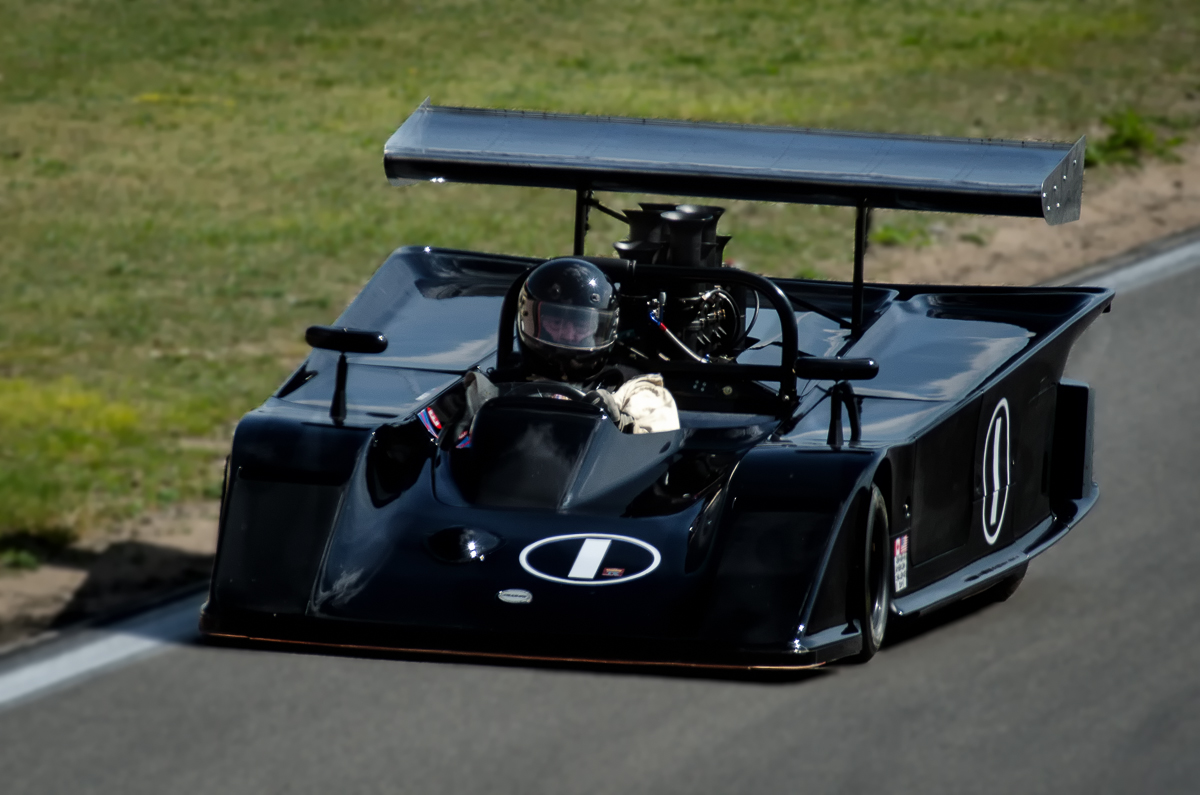 Shadow Mk.1 Can Am car (Photo: Frank Ullrich)
Shadow Mk.1 Can Am car (Photo: Frank Ullrich)
Following his one season in F1, Follmer continued to race in the NASCAR Winston Cup Series and the Can-Am series. In 1976 he won his second Trans-Am title with a Porsche 934 turbo but two years later, Follmer was seriously injured practising a Can-Am Prophet-Chevrolet at Laguna Seca. Suffering a broken leg and internal injuries, it appeared his driving career was over but he recovered sufficiently to return to Trans-Am in 1979. George Follmer's last major race was in 1986 where he raced at the Le Mans 24 Hours, some 20 years after his only other appearance at the La Sarthe circuit. Follmer co-drove the third placed Joest Porsche 956B. After retiring from professional racing, Follmer continued to compete in vintage races, often driving the very same cars in which he competed during his heyday.
New Additions: June 2020
Welcome to the June update. Only a handful of additions to report this month and mainly just restocked models. Covid-19 is having a massive impact on air freight at the moment which meant a couple of parcels did not arrive in time for this month's update. The crisis has grounded 90% of passenger flights worldwide and normally these aircraft carry half of the worlds air freight so there is a critical shortage of air cargo capacity. This decreased capacity has resulted in delays to shipping times, so I guess we all need to be patient when expecting a delivery.
While we're all required to spend more time at home, it does give us an opportunity to admire our beautiful model cars, perhaps even rearrange that crowded cabinet or maybe find those gaps in your collection. Hopefully, I can help with the latter! Despite the easing of restrictions on some gatherings, it hasn't been enough to allow the resumption of model car fairs and swap meets yet. As well, I've been informed by the organisers of the Shannons Sydney Classic at Eastern Creek (August) and the Hawkesbury Model and Hobby Show (September) that both shows have been cancelled this year. As soon as I hear any news about the resumption of model fairs, I will let you know. Meanwhile, stay safe and happy collecting.
Formula One
- 1978 Tyrrell Ford 008, D.Pironi (3) 5th Monaco GP "Elf" (Spark)
- 1963 Porsche 718, Carel Godin de Beaufort (12) 6th US GP (Spark)
- 1989 Lola Lamborghini LC89, M.Alboreto (29) Portugal GP (Spark)
- 1962 Lola Climax Mk4A, R.Salvadori (15) "Yeoman Credit" German GP (Spark)
- 1967 Matra Ford MS7, J.P.Beltoise (22) 7th Mexican GP (Spark)
- 1969 Matra Ford MS10, J.Stewart (7) 1st South African GP (Spark)
- 1963 Cooper Climax T60, J.Bonnier (12) 5th Belgium GP (Spark)
- 1973 Brabham Ford BT42, R.Stommelen (9) Italian GP (Spark)
- 1970 BRM P153, P.Rodriguez (20) South African GP (Spark)
Le Mans / DRM
- 1974 BMW 3.0 CSL, Mohr/Facetti/Finotto (87) Le Mans (Spark)
- 1980 Ford Escort Turbo, W.Boller (58) DRM Zolder Div.II (Spark)
After Thoughts: "The Triple Crown of Motorsports" The Triple Crown of Motorsport is an achievement (allbeit, unofficial) of winning three of the most prestigious motor races in the world, the Indianapolis 500, the 24 Hours of Le Mans and the Monaco Grand Prix. This holy trinity of racing has inspired many drivers but only a handful who competed in all three events have come close, winning only two of three races. These include such illustrious drivers as Tazio Nuvolari (Monaco, Le Mans, Indy 500 - DNQ 1938), Bruce McLaren (Monaco, Le Mans, Indy 500 - DNQ 1968, 1970), Jochen Rindt (Monaco, Le Mans, Indy 500 - 24th 1967, 32nd 1968), Juan Pablo Montoya (Indy 500, Monaco, Le Mans - 7th 2018) and Fernando Alonso (Monaco, Le Mans, Indy 500 - 24th 2017). There is, of course only one driver who has achieved the Tripe Crown...
The 1963 Monaco GP was the first race of the season and no major team wanted to risk their new cars on the formidable and unforgiving street circuit. So the field comprised entirely of cars from the previous season although some sported new engines and suspension parts. Qualifying for Monaco has always been a hectic affair as the circuit was notorious for it's lack of passing opportunities; a good qualifying position meant a good chance of victory. The qualifying for the '63 race was no exception. The top three postions on the grid were Jim Clark (Lotus-Climax) on pole and then Graham Hill (BRM) and John Surtees (Ferrari). When the flag dropped at the start on Sunday, all 15 cars got away cleanly with the two BRM's of Hill and Ginther powering pass Clark. It wasn't until the 5th lap that Clark managed to get past Ginther and then duelled with Hill for the lead with Ginther close behind. In spite of this furious battle for the lead, the majority of the field was keeping up reasonably well. Eventually, Clark moved ahead of Hill and seemingly had the race won by half race-distance with a lead of more than 8 seconds. By three-quarters race-distance, Clark's lead had ballooned to 17 seconds but then as he prepared to change down a gear for a corner, his gearbox jammed. Clark desperately tried to get a gear to select but his gearbox cried enough and his wheels locked solid. The race win was then handed to Graham Hill who never gave up chasing down Clark. Crown number one.
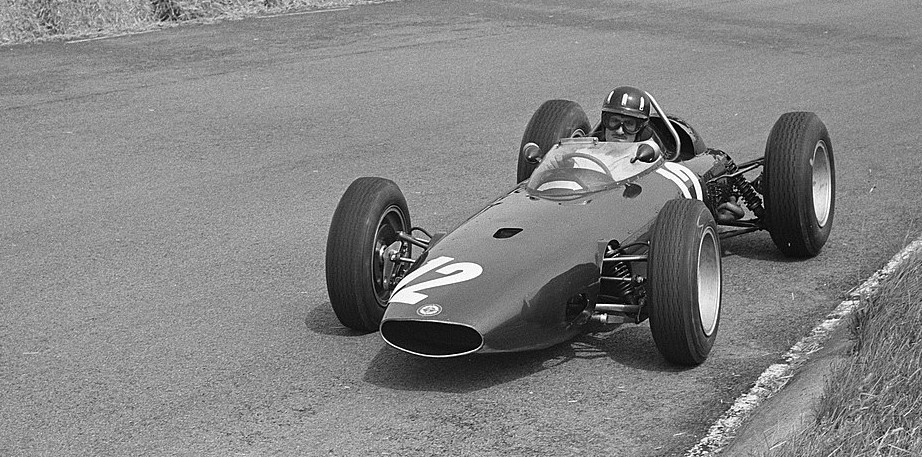 BRM P57 1963 (Photo: Harry Pot)
BRM P57 1963 (Photo: Harry Pot)
The 50th International 500-Mile Sweepstakes was held at the Indianapolis Motor Speedway on May 30, 1966. Defending champion, Jim Clark (Team Lotus) qualifed well, starting the 200 lap race in the middle of the first row. The Mecom Racing team entered three of the new, improved Lola T90's for Rodger Ward, Jackie Stewart and Walt Hansgen but when Hansgen was killed while testing at Le Mans in April, Graham Hill was signed in his place. Mario Andretti in a Brawner-Ford was on pole as the 33-car field roared across the yard of bricks at the start of the race. A little further back in the field, there was chaos. A car had hit the wall and the impact sent its right-side wheels and the nose-cone back into the oncoming pack of cars. With nowhere to go cars slid sideways, cars hit the wall or hit each other; in the middle of the accident, no less than ten wheels went airborne. The race was red-flagged before the end of the first lap and 11 cars were too badly damaged to continue. When the race restarted, Andretti held the lead until his engine expired, then Clark took the lead on lap 17 until he spun on lap 64, but recovered without hitting anything. Clark regained the lead on lap 75 before spinning again 11 laps later and again he skillfully regained control. Meanwhile, Jackie Stewart was slowing moving up the field; although a rookie at Indy, he drove like a veteran and he took the lead on lap 150. On lap 192 with only 8 laps to go, Stewart coasted to a halt with no oil pressure in his Ford engine. Graham Hill then found himself in the lead and took the chequered flag at the end of lap 200 and drove straight to Victory Lane. Shortly after he arrived, Clark thinking he had won, also drove to Victory Lane, only to find it occupied by Hill. There was some confusion about Clark's actual finishing position and it was due to the identical paint scheme of the two STP Lotuses; a lap by team mate Al Unser had been erroneously credited to Clark. No protest was filed and Hill's victory stood. Crown number two.
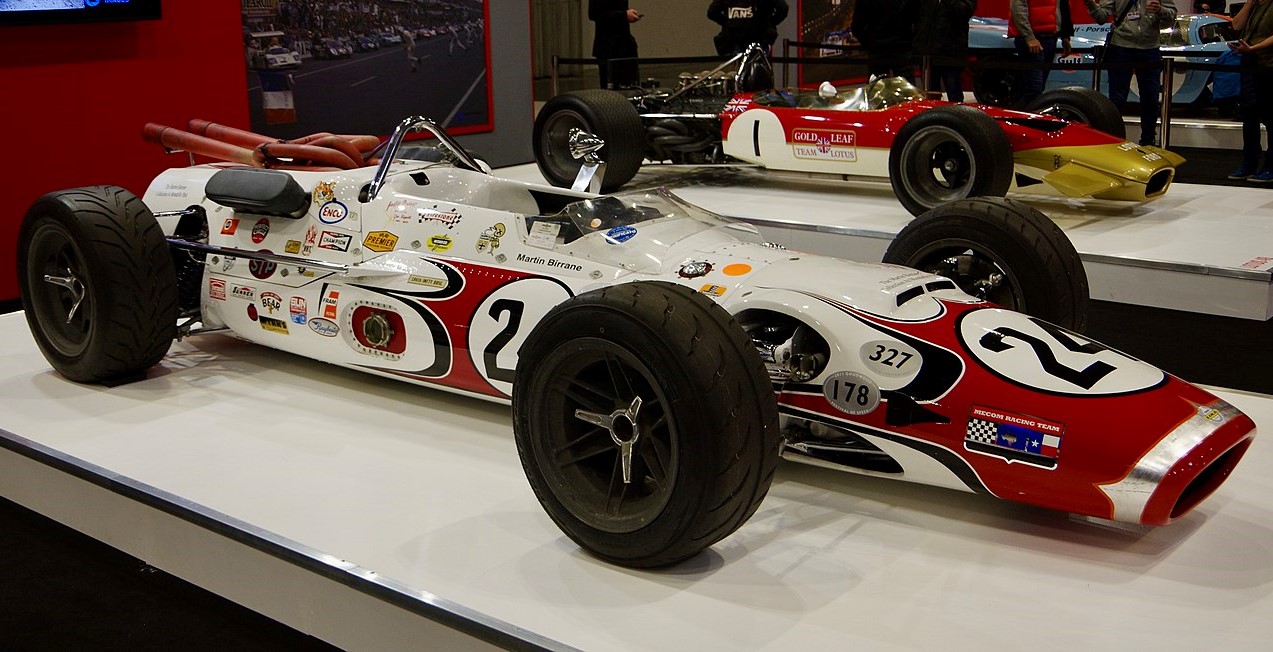 Lola T90 Indy 500 1966 (Photo: David Merrett)
Lola T90 Indy 500 1966 (Photo: David Merrett)
The French Matra team chose to concentrate all its effort to secure a win at the prestigious Le Mans endurance race in 1972 even to the point of foregoing all other races in the endurance championship. Now that the regulations had changed, limiting engine capacity to just 3 litres, Matra felt this was their best chance of victory. They entered four MS 670 cars and backed their chances with variations of body shape, engine power, fuel consumption, tyre sizes, gearbox variations and so on. Even their driver selection seemed to be carefully thought out. The Ferrari 312PB were to be Matra's main rival but a week before the race, Ferrari withdrew their four cars. The flat-12 cylinder Ferrari engines had failed to stand up to very long flat-out tests and besides, they had already won the 1972 Manufacturers Championship so had nothing to lose except pride. Nevertheless, the Matra team went all out during qualifying and were rewarded with a 1-2-3 race start with Cevert/Ganley on pole and Pescarolo/Hill in second. After the 55 cars started racing at 4pm Saturday 10th June from a rolling start (the classic Le Mans start had been abandoned in 1970), the crowd settled down to watch the Matra demonstration run, the only speculation being as to which Matra would win on Sunday afternoon. But only after 2 laps, the number 12 Matra of Beltoise/Amon expired in a cloud of smoke as its engine detonated. But worse was to come, by lap three a yellow Lola was in the lead and as it started to rain, it extended its lead over the three Matras. Thankfully for the French crowd, the order was restored after the first hour when the Lola pitted for fuel. From this point onwards the excitement for the lead was over, for one or other of the Matras led for the next 23 hours. The Matra of Cevert/Ganley was leading comfortably at the 21-hour mark and was travelling conservatively in the rain when a charging Chevrolet Corvette rammed into the back of the Matra causing considerable wheel and suspension damage but managed to limp back to the pits for repairs. The Matra of Hill/Pescarolo then took the lead and finished nine laps ahead of the repaired Cevert/Hanley Matra. Crown number three.
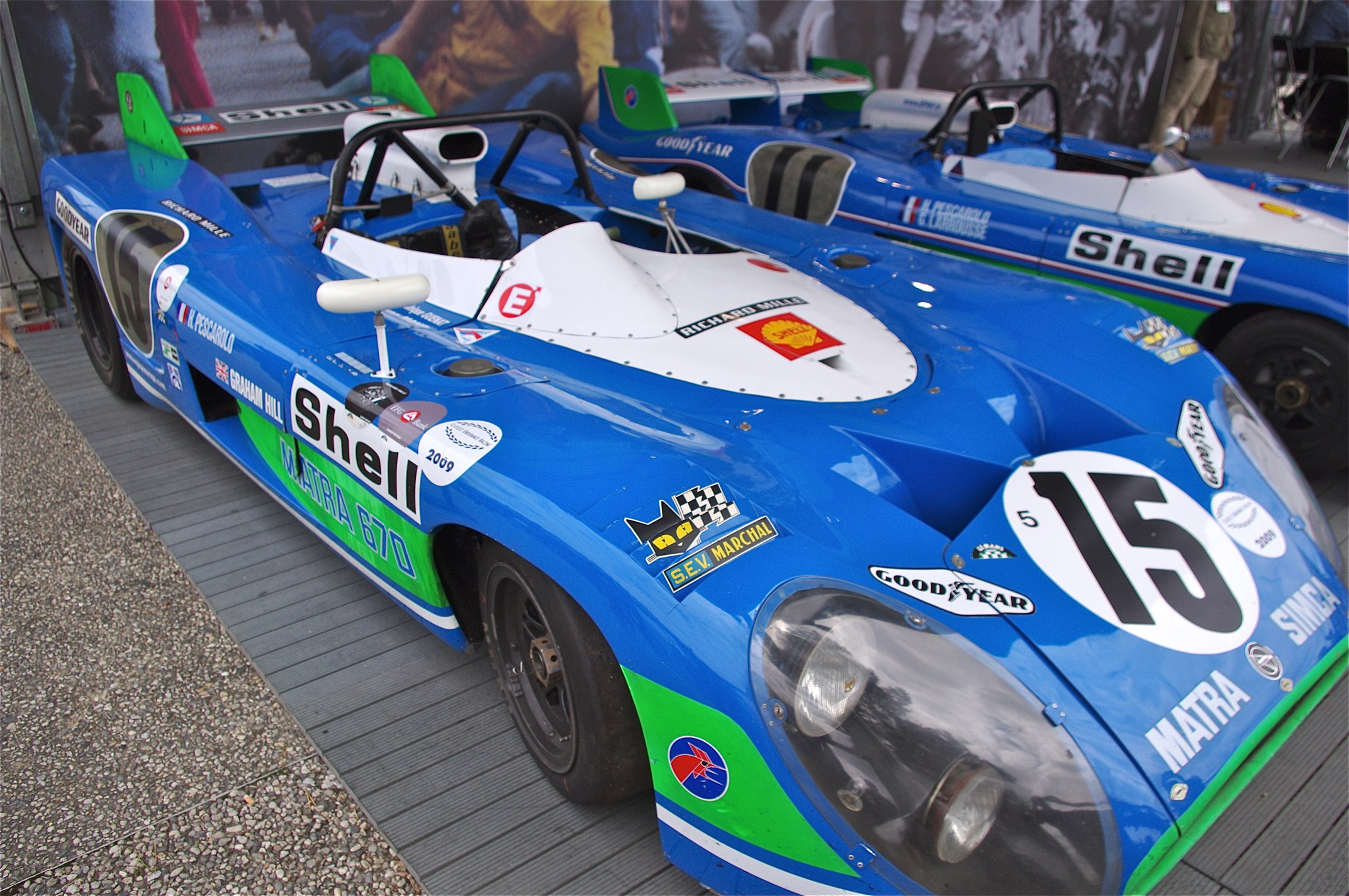 Matra Simca MS670 Le Mans 1972 (Photo: Dave Hamster)
Matra Simca MS670 Le Mans 1972 (Photo: Dave Hamster)
New Additions: May 2020
Welcome to the monthly update for May and I hope everyone is safe and well during these worrying times. It seems we may be relaxing the social distancing restrictions a tiny bit in Australia but mass gatherings are definitively still a long way off, so again, no model fairs this month. Unfortunately I've had to cut back on acquisitions this month due to softening sales but hopefully there may a few models that interest you from the meagre list.
I'm surprised that it's taken so long for Spark to produce models of the GT40's that raced at the 1964 Le Mans race. The Macau-based model maker has released the three factory Ford GT40's that made their debut at the 24 hour endurance race. It was not to be a happy race for Ford, the first to retire after 5 hours was the number 12 car of Schlesser and Attwood followed an hour later by Ginther and Gregory in car 11 with terminal gearbox issues. The third car, driven by Phil Hill and Bruce McLaren managed to get to the 14th hour before it too succumbed to gearbox failure. These models are sure to please GT40 fans.
Well, that's it for another quiet month (at home). Let's hope for some more positive news in June, until then, happy collecting.
Formula One
- 1956 Bugatti T251, M.Trintignant (28) French GP (Spark)
- 1976 Ferrari 312T, C.Regazzoni (2) 1st USA (West) GP (La Storia Collection) (Vitesse)
- 1989 Ferrari 640/F189C, N.Mansell (27) 1st Brazilian GP (La Storia Collection) (Vitesse)
- 1975 Hesketh Ford 308, A.Jones (26) Monaco GP (Spark)
Le Mans
- 1964 Ford GT40, P.Hill/B.McLaren (10) Le Mans (Spark)
- 1964 Ford GT40, R.Ginther/M.Gregory (11) Le Mans (Spark)
- 1964 Ford GT40, J.Schlesser/R.Attwood (12) Le Mans (Spark)
- 2018 Ford GT, Dixon/Briscoe/Westbrook/ (69) Le Mans (Spark)
- 2019 Ford GT, Priaulx/Tincknell/Bomarito (67) Le Mans (Spark)
- 1959 Lotus Elite, J.Clark/J.Whitmore (42) Le Mans (Spark)
- 2000 Panoz LMP-1 Roadster-S, Kageyama/Kageyama/Suzuki (23) 6th Le Mans (Action)
- 2005 Pescarolo C60 Judd, Collard/Boullion/Comas (16) 2nd Le Mans (IXO)
After Thoughts: "A Test of Endurance; The 1909 New York to Seattle Race" The year was 1909 and Robert Guggenheim, at 24 years of age had a mining fortune and a willingness to spend it. The Alaska-Yukon-Pacific Exposition, publicising the development of the Pacific Northwest was to open on June 1 in Seattle and Guggenheim was interested in promoting it. Since no car had ever driven from New York to this corner of the US, what better promotion than an automobile race from coast to coast. Guggenheim decided to offer a prize of $2000 and the Guggenheim Trophy to the automobile that could reach Seattle in the least possible time having stopped at various checkpoints along the official route. The race would be called the "Ocean to Ocean Automobile Endurance Contest". But as no car had yet driven from the East coast to Seattle, most of the 300-odd automakers active in the US weren't keen to publicly test their products in the mountainous country where roads were poor and often nonexistent.
As the start date approached, the organisers had received thirty-five expressions of interest but as the contest drew closer only six entries were received and only five actually made it to the New York starting line. The five that started on June 1 included two Ford Model T's (designated No.1 and 2). The Fords were powered by 20 hp 4-cylinder engines; the body stripped almost to the bare chassis weighed about 950 pounds, down from 1200 and only the two front seats were left intact. Opposing the lightweight Fords were:
- a six-cylinder, 48 hp Acme, weighing 3,500 pounds with a four man crew.
- a four-cylinder, 45 hp Shawmut, weighing 4,500 pounds with a three-man crew
- and a four-cylinder, 50 hp Itala (Italian-made), weighing 4,000 pounds with a crew of three.
The sixth car entered was a Stearns; it finally got under way 5 days after the race had started. It then broke down 24 miles from the start line; if nothing else, the crew at least had the good sense to quit early. All the entrants had to obey traffic laws from New York to St. Louis but from there to Seattle, they were allowed to go as fast and reckless as they saw fit or if the road conditions allowed it. The two Fords travelling together, entered St. Louis in the lead with the Shawmut a couple of hours behind.
Route for the Ocean to Ocean Race 1909
It was soon apparent the Shawmut and the two Fords were the main contenders, with the lead swapping between them as they headed in the general direction of Seattle. But the Fords had two advantages; Henry Ford had built up a dealer network across the country and advance planning. The dealers had been instructed to render assistance in any way they could. Torrential rain tormented the competitors with cars being bogged up to their axles, the lead changed regularly as one after the other became stuck in the quagmire, sometimes taking a full day to be freed. When the Fords reached Wyoming, the two Fords decided to split up, from here on it would be every man for himself, with no stopping to help the other crew. The durability of the Shawmut was beginning to concern them.
When Ford car no. 1 reached American Fall, Idaho it was nine hours ahead of the rest and the car was running beautifully. The 2-man crew were beginning to believe they had the race won. The guide scheduled to point the way to their next destination, Twin Falls, hadn't turn up but instead of waiting, they listened to the first person who told them he knew the way. He didn't. The Ford no. 1 lost 24 hours and were now 12 hours behind Ford no.2; the Shawmut had also overtaken them. The Acme and Itala were nowhere to be seen.
On June 23, at the Alaska-Yukon-Pacific Exposition gates with a crowd of 15,000 watching, Robert Guggenheim clicked his stop-watch as the Ford no.2 crossed the finish line. The Model-T had covered the New York to Seattle distance of 4,106 miles in 22 days, 55 minutes, an average of 7.75 mph. The Shawmut finished second, 17 hours behind, while Ford no.1 came home in June 25. The Acme arrived on June 29 and the Itala arrived on a freight car having given up in Wyoming. Henry Ford was estatic with the win and asked the winning drivers to drive the Model-T back to Detroit on a leisurely sales promotion tour.
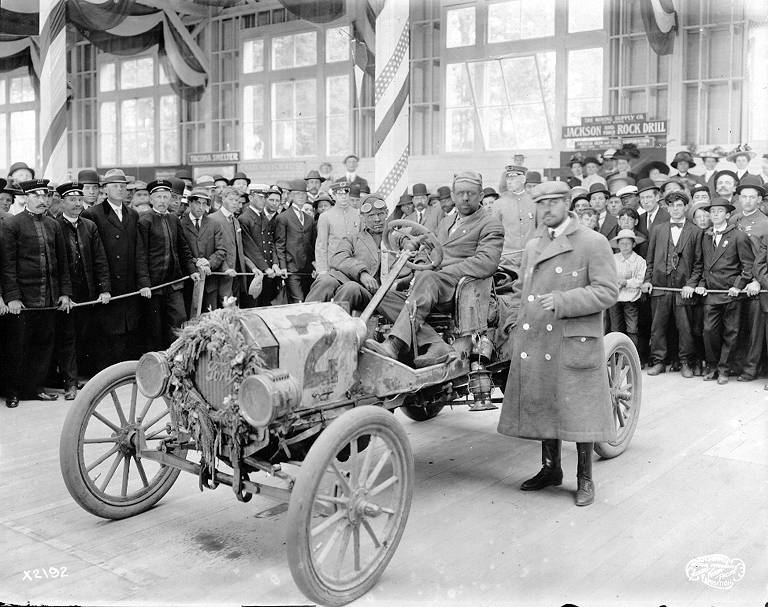 The "winning" Ford with R.Guggenheim standing beside it
The "winning" Ford with R.Guggenheim standing beside it
However, there was a slight problem, the officials of the Shawmut Motor Company announced they were entering a formal protest against Ford no.2. Four months later the contest committee finally disqualified Ford no.2 on the grounds that somewhere along the punishing route, Ford dealer mechanics had replaced the entire engine, a clear violation of the rules. From a sales/promotion standpoint, it didn't make much difference. The story of the race had already had its positive impact on Ford's Model-T sales whereas the Shawmut ceased production soon after the race.
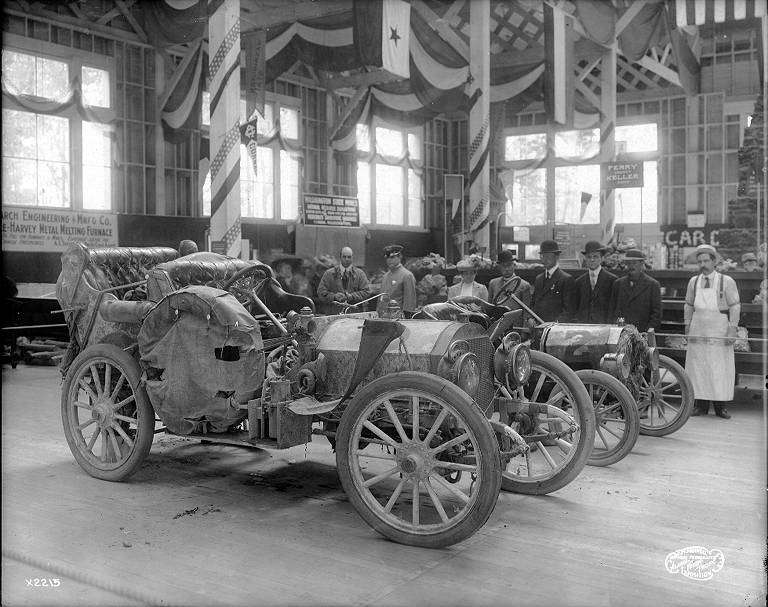 The Shawmut, in front of Ford No.2 which was eventually disqualified
The Shawmut, in front of Ford No.2 which was eventually disqualified
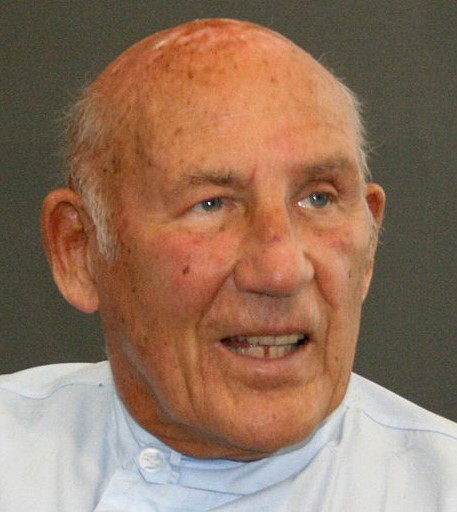 Vale Sir Stirling Moss, OBE 1929 -2020
Vale Sir Stirling Moss, OBE 1929 -2020
New Additions: April 2020
Welcome to another monthly update. How things can change so devastatingly in such a short period of time; the world is now grappling with a pandemic that has impacted our lives in many different ways. The world's economy seems to be in freefall as panic spreads even faster than the virus. The model car world hasn't been spared either; here in Sydney, the Collectormania Fair at Windsor and the Sydney Toy Fair at Granville have all been cancelled until further notice. And with the very weak Australian dollar, I've had to seriously cut back on my overseas purchases so hence the relatively small number of new additions this month. Having said that, here are some highlights this month.
The most celebrated of all Jordan drivers only raced for the team once and even then, he never got beyond the first lap. After his debut in the 1991 Belgium GP, Michael Schumacher was poached by Benetton and the rest, as they say is history. That year, Eddie Jordan employed two full-time drivers; Bertrand Gachot and Andrea de Cesaris. De Cesaris scored two fine 4th places including one at the Canadian GP (as modelled by Minichamps). However, Gachot lost his drive with the 7UP Jordan team when he spent two months in a British jail for assaulting a taxi driver thus providing Schumacher his golden opportunity in Belgium.
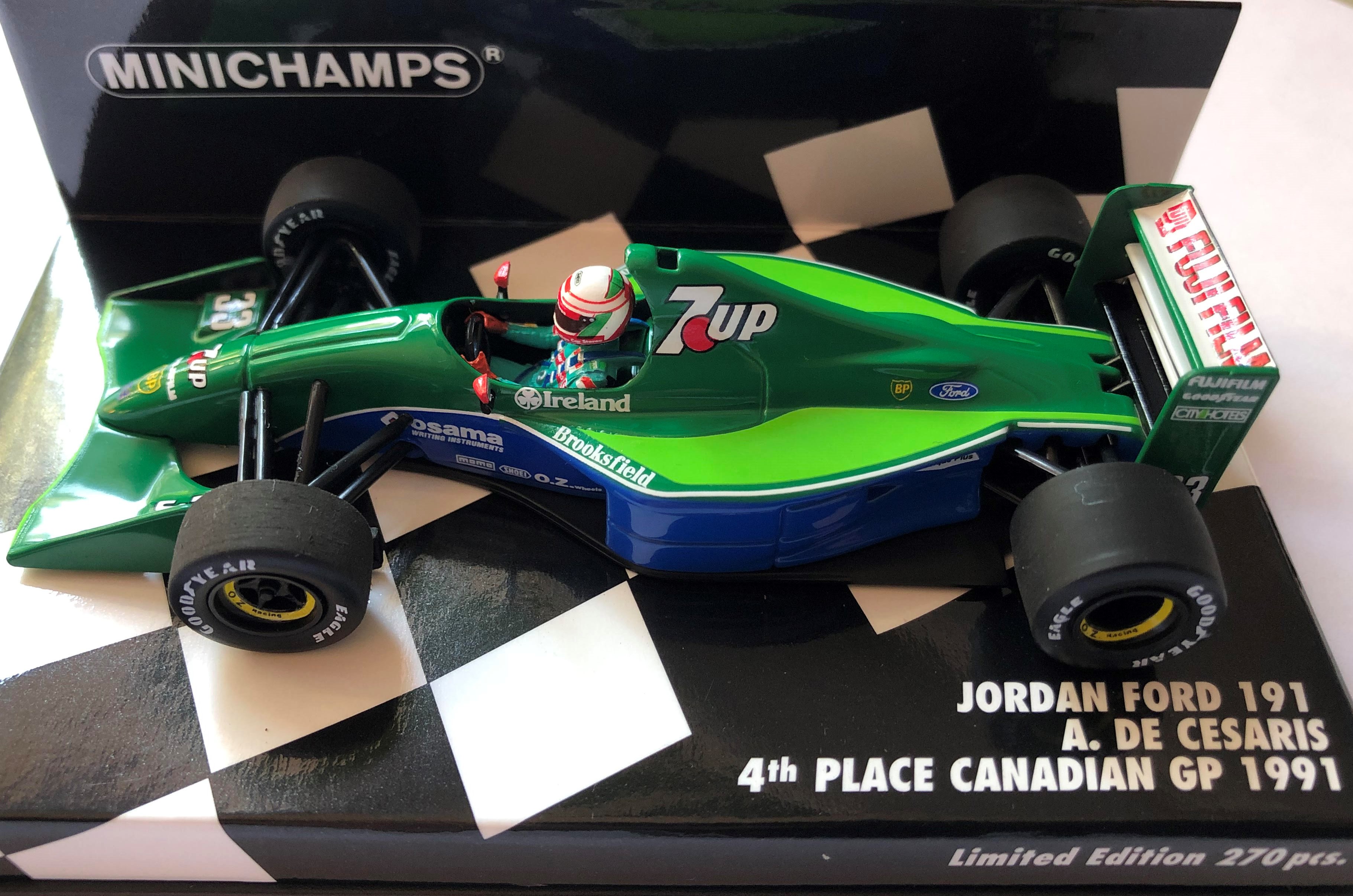 Minichamps: De Cesaris' Jordan Ford 191
Minichamps: De Cesaris' Jordan Ford 191
For those who collect 1:64 models, you've no doubt come across the MiniGT range from Truescale Miniatures. TSM have recently released a novel accessory to display your 1:64 models, a parking lot. This pad measures 40cm x 25cm and can comfortably "park" 13 cars but make sure you have a valid permit before parking in the disabled bay.
OK, that's it for another eventful month. As mentioned above, there are no model fairs for the foreseeable future but as soon as there's any change, I'll let you all know. By the way, I'm still able to post models and for overseas collectors, the exchange rate is very favourable at the moment. If your area is in total lockdown, I'm happy to put aside models until your situation improves. Until next month, happy collecting.
 (Thanks, Richard)
(Thanks, Richard)
Formula One
- 1991 Jordan Ford 191, A.de Cesaris (33) 4th Canadian GP (Minichamps)
- 2019 Mercedes AMG W10, L.Hamilton (44) US GP World Champion (Minichamps)
- 2019 Renault R.S.19, D.Ricciardo (3) race car (Minichamps)
- 1989 Reynard Spiess F893, M.Schumacher (32) Macau GP 1st Qual. Race (Minichamps)
- 1977 Surtees Ford TS19, V.Brambilla (19) 4th Belgian GP (Spark)
Misc Scale (1:64)
- Parking Lot Pad Type A 40cm x 25cm (MiniGT)
- 2019 Porsche 911 GT3, Werner/Olsen/Campbell (912) 1st Bathurst 12hr (Spark)
Driver Figures and accessories (1:43)
- 1981 Ferrari 126CK accessories - D.Pironi - F & R wings, tyres, driver figurine (Brumm)
- Pit Stop 6 Mechanics + base plate (Altaya)
- Ayrton Senna Figurine (Williams) 1994 (Minichamps)
- Ayrton Senna Figurine Type I arms akimbo (TSM)
After Thoughts: "The FISA-FOCA War and The Race that Never Was" While drivers battled for F1 World Championship supremacy during the late-seventies and early-eighties another battle was also being fought. A political war was being waged between the Federation Internationale du Sport Automobile (FISA) and the Formula One Constructors' Association (FOCA) for the control of Formula One racing. FOCA had been formed to advance the interest of privately owned teams, initially against the race organisers and later against the manufacturer-owned teams such as Ferrari, Renault and Alfa Romeo. Bernie Ecclestone (owner of the Brabham team) and Max Mosley (March Engineering) were the principal players for FOCA while FISA was led by Jean-Marie Balestre who was perceived as favouring the manufacturer-owned teams. The battle revolved around numerous issues; FOCA were of the opinion that their rights and ability to compete against the larger and better funded teams were negatively affected by FISA's bias towards the major manufacturers. Also, FOCA was unhappy with the way proceeds from the races were distributed amongst the teams.
The battles raged throughout the late-seventies and the first major confrontation occurred at the 1980 Spanish GP held on the Jarama circuit. Prior to this race, there had been skirmishes at the Belgian and Monaco races where FOCA drivers made a stand by refusing to attend the compulsory pre-race drivers' briefing. FISA responded to this rebellion by fining each offending driver and when the 15 drivers refused to pay, their licences were withdrawn just before opening practice of the Spanish GP. FOCA demanded the drivers' suspension be lifted and FISA refused to back down. FOCA then threatened to boycott the race and setting up the prospect of a farcical race with just six FISA-aligned cars (from Ferrari, Renault and Alfa).
With tensions high, Spanish monarch King Juan Carlos became involved, insisting the race organiser proceed while bypassing the Spanish motorsport federation, which was tied to FISA. This in turn resulted in the FISA teams withdrawing their 6 drivers from the event which now became one with FOCA-aligned teams only.
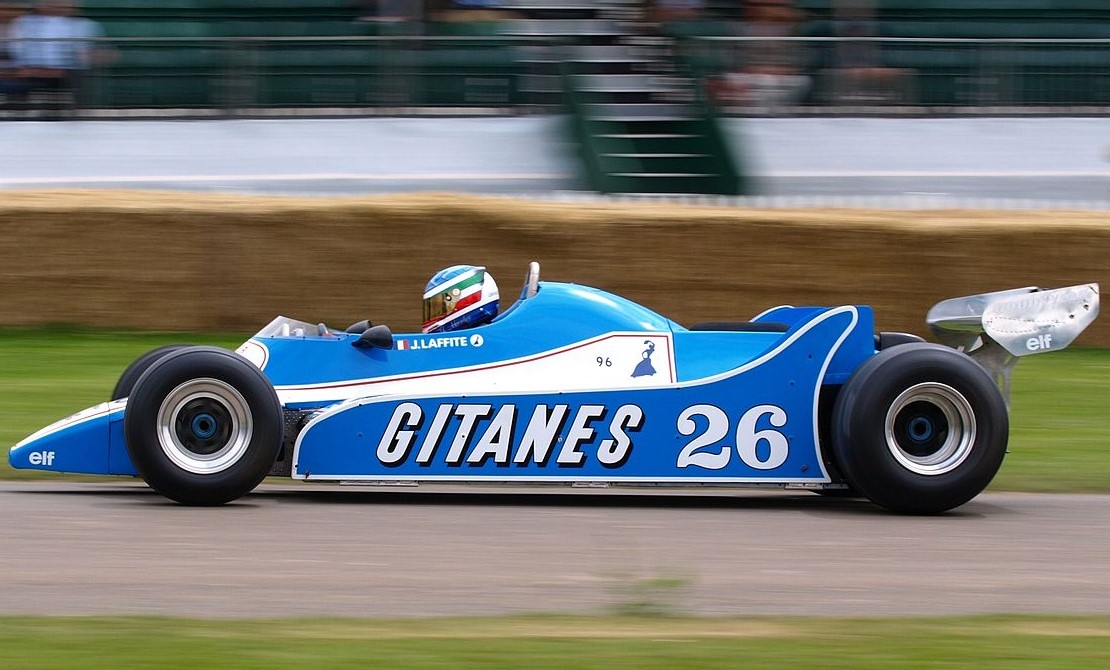 J.Laffite's 1980 Ligier JS11 in 2008 (photo: Darren)
J.Laffite's 1980 Ligier JS11 in 2008 (photo: Darren)
While chaos reigned behind the scenes, the race went ahead with Jacques Laffite in a Ligier on pole with Alan Jones (Williams) alongside. With only FOCA teams racing, all cars were powered by Cosworth DFV engines. The race of attrition, where only 6 cars finished was eventually won by Jones who enthusiastically sprayed the crowd with champagne thinking he had 9 points in the bag.
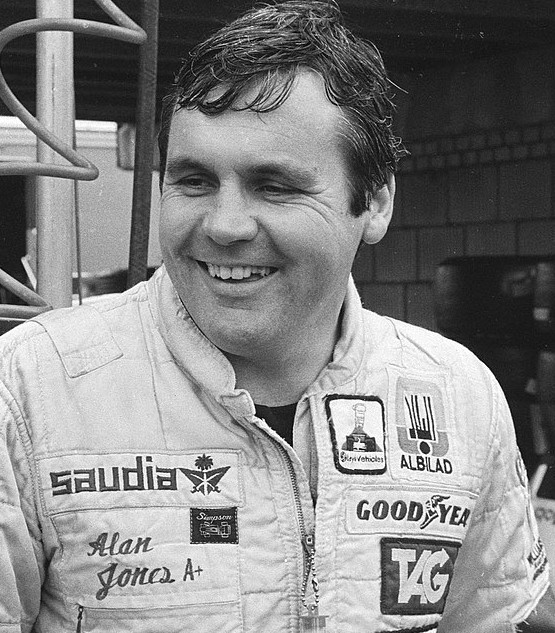 Alan Jones 1980 (photo: NL-HaNa, ANEFO)
Alan Jones 1980 (photo: NL-HaNa, ANEFO)
The next day, FISA executives met in Athens and declared the race would not count for points; this was eventually confirmed nearly two months after the race. Jones, of course was furious. The flashpoint at the Jarama circuit led to the drivers' fines being paid before the next round in France, Balestre's home GP. Fortunately, the loss of points from his win in Spain didn't cost Jones the 1980 world championship. Apart from the sport's reputation, the real loser was Patrick Gaillard who had finished sixth in Spain driving an Ensign. Denied a World Championship point, he never scored another.
March Update: 17/3/20:
With the recent Government ban on gatherings of 500 or more people, the organiser of the Collectormania Show has decided to cancel the show scheduled for 19 April. The next show is on 14 June but of course this will depend on the situation closer to this date.
March Update: 12/3/20:
Due to unforeseen circumstances, I'm unable to make it to the March Granville swap meet. Sorry for the inconvenience caused.
New Additions: March 2020
Thanks to everyone who dropped by my stand at Granville and Penrith last month. It was rather sad to leave Penrith after so many years there but I've got positive feelings about the new venue at the Hawkesbury Indoor Stadium at South Windsor. I believe it's going to be bigger and brighter than Penrith so let's hope for a good turn out on 19th April. In light of the "virus" spreading quickly around the world, I hope everyone is well. As the vast majority of model cars are made in China, I think some may be asking if it's safe to receive model cars from China? According to the World Health Organisation's website (https://www.who.int/emergencies/diseases/novel-coronavirus-2019/advice-for-public/myth-busters) it is safe to receive packages from China because the coronaviruses do not survive for very long on objects. I hope this puts your minds at rest.
Rather a small list of new additions this month, so there's only one model I wish to highlight. The British F1 manufacturer, March began designing and selling cars in 1970 and offered customers the 701 chassis mated with the Cosworth DFV. For 1972, a completely new design was revealed which was intended to be a technical break-through that March needed to bring it to the forefront. What was produced was the 721X (for experimental) and featured high mounted rear springs. The gearbox was also mounted between the engine and rear axle, instead of behind the the rear axle. In theory these two features would improve the car's overall weight distribution. The 721X made its debut at the Spanish GP driven by Niki Lauda and Ronnie Petersen. Unfortunately, the customer Goodyear tyres March were using, were designed for a conventional chassis and suspension configuration. The front tyres were completely overloaded and caused all kinds of trouble in corners from complete understeer to accute oversteer. After three races, the "experiment" was over and the 721X was replaced by a more conventional 721G. In the years to come, both the rear suspension and gearbox layout was applied on most GP cars, proving the theories behind the design of the 721X were correct.
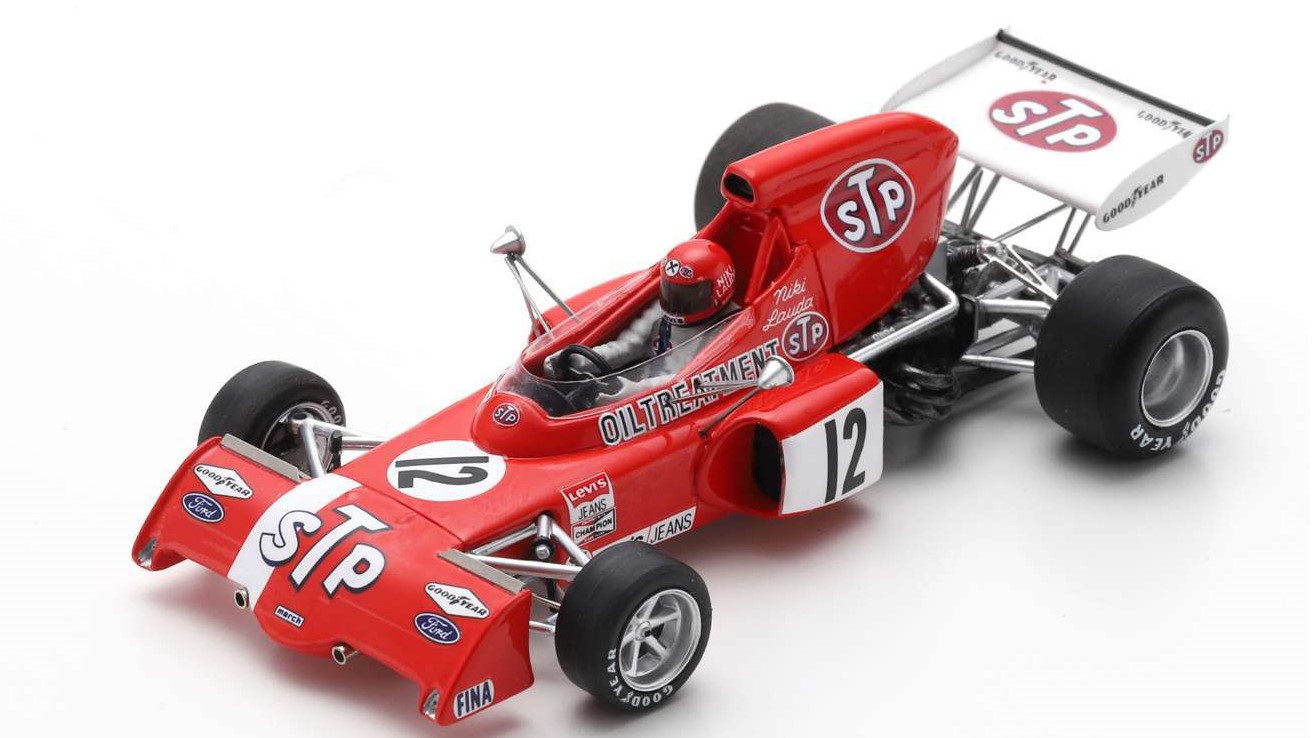 Spark: Niki Lauda March Ford 721X 1972
Spark: Niki Lauda March Ford 721X 1972
OK, that's a wrap for another month. Just the one model fair this month; the 2nd Friday fair at Granville on 13th March. I hope to see you there and until next month, happy collecting.
Formula One
- 1975 Brabham Ford BT44, C.Pace (8) 1st Brazilian GP (Spark)
- 1983 Brabham BMW BT52, N.Piquet (5) 1st Brazilian GP (Spark)
- 1972 BRM P180, J.P.Beltoise (3) 1st Brands Hatch (Non-Championship Race) Spark
- 1972 BRM P180, P.Gethin (8) Spanish GP (Spark)
- 1965 Lotus Climax 33, J.Clark (5) 1st British GP (Spark)
- 1972 March Ford 721X, N.Lauda (12) Belgian GP (Spark)
- 1969 Matra Ford MS80, J.Stewart (7) 1st Spanish GP (Spark)
- 2018 McLaren X2 Concept car in orange (Minichamps)
- 1978 Surtees Ford TS19, R.Keegan (18) Monaco GP (Spark)
Bathurst 12 hour
- 2019 BMW M6 GT3, Farfus/Mostert/Tomczyk (42) Bathurst 12 hr (Spark)
- 2015 Nissan GT-R Nismo GT3, Chiyo/Reip/Strauss (35) 1st Bathurst 12 hr (Spark)
- 2019 Porsche 911 GT3, Calvert-Jones/Estre/Evans (12) Bathurst 12 hr (Spark)
Le Mans / Sports Car
- 1976 BMW 3.5 CSL Turbo Gp.5, Petersen/Nilsson (1) Silverstone 6-hour (Spark)
- 1992 Toyota TS010, Raphanel/Sekiya/Acheson (33) "Casio" 2nd Le Mans (IXO)
- 2019 Toyota TS050 Hybrid LMP1, Buemi/Nakajima/Alonso (8) 1st Le Mans (Spark)
Helmets 1:5 Scale / 1:2 Scale
- 2019 Valtteri Bottas - Mercedes AMG 1:5 (Spark)
- 2019 Antonio Giovinazzi - Alfa Romeo F1 1:5 (Spark)
- 2019 Kimi Raikkonen - Alfa Romeo F1 1:5 (Spark)
- 2015 Nico Hulkenberg - Porsche 919 Le Mans 1:2 (Schuberth)
- 2017 Nico Hulkenberg - Renault RS17 1:2 (Schuberth)
- 2016 Felipe Massa - Williams FW38 1:2 (Schuberth)
- 2018 Mick Schumacher - Dallara F317 1:2 (Schuberth)
Road Cars
- 2018 Bentley Bentayga, Pikes Peak Ltd. Ed. By Mulliner in light green (Spark)
1:18 Models
- 2019 Renault R.S.19, D.Ricciardo (3) Australian GP (Spark)
After Thoughts: "The Return of Aston Martin" Recently, it was announced that Lawrence Stroll, the Canadian billioniare whose consortium of investors currently owns Racing Point F1, had injected 182 million pounds to rescue luxury car-maker Aston Martin. This investment gives Stroll a 16.7% stake in the company, possibly rising to 20% in the future and he will join the board as executive chairman. The small, British-based Aston Martin, which often buys its core components like engines and transmissions from larger European manufacturers, had been struggling with the economic slowdown in China as well as issues associated with Brexit. Aston Martin has changed hands multiple times over the years, including spending almost 20 years under the Ford umbrella and is currently owned by Italian and Kuwaiti private equity groups.
The Racing Point F1 team will be renamed Aston Martin as a result of the takeover starting in 2021. The Red Bull team, which has a commercial partnership with Aston Martin has announced that this would cease at the end of 2020. However, Aston Martin's association with F1 actually dates back to the late 1950's.
Aston Martin began in 1913 when founders Lionel Martin and Robert Bamford realised their desire to build distinctive, high quality sports cars that were both exhilarating to drive and a beauty to behold. Martin regularly competed in hill climb races at Aston Clinton and a combination of the name of the event and the driver gave birth to a famous motoring marque. Aston Martin's international racing debut was in 1922 when two cars competed in the French Grand Prix. Industrialist David Brown, who had a passion for high performance sports cars, acquired Aston Martin in 1947. Brown recognised the potential that existed for Aston Martin if he could take the company racing on the international motor racing circuits. A purpose-built sports car, the DB3S made its Le Mans debut in 1952 and showed great potential. In the hands of the factory drivers, the DB3S went on to win its class at Le Mans for three consecutive years from 1955, then in 1959 an Aston Martin DBR1 driven by Shelby and Salvatori won Le Mans outright. Following the success of its sports car racing programme, the company decided to enter the F1 championship.
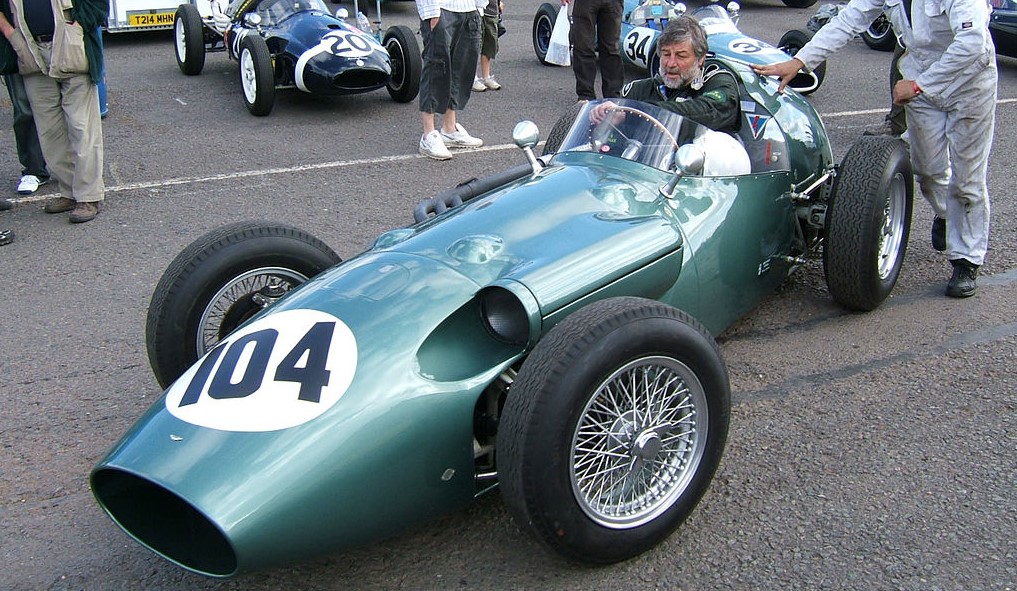 Aston Martin DBR4 at Donnington (John Chapman)
Aston Martin DBR4 at Donnington (John Chapman)
The Aston Martin DBR4 open-wheeler was largely based on the DB3S, borrowing the sports car's basic chassis and engine layout. Although it was ready for testing in 1957, the DBR4 did not make its World Championship debut until the 1959 Dutch GP in the hands of Roy Salvatori and Carroll Shelby. This long development period of their F1 car meant that much of its concept and technology were obsolete when it finally went racing. The bodywork of the DBR4 appeared streamlined but the effect was spoilt by the large air intake mounted on the side of the bonnet and by the installation of a relatively tall, near vertical windscreen. The DBR4 also used the de Dion suspension system, although state-of-the-art in the early 50's, other F1 manufacturers were already moving to all-round independent suspension. At the Dutch GP the works drivers managed to qualify 10th and 13th but during the race, both cars suffered terminal engine problems. The F1 programme suffered further delays and they only appeared in another three races that season. The best results were two sixth place finishes for Salvatori but only the first 5 places scored points.
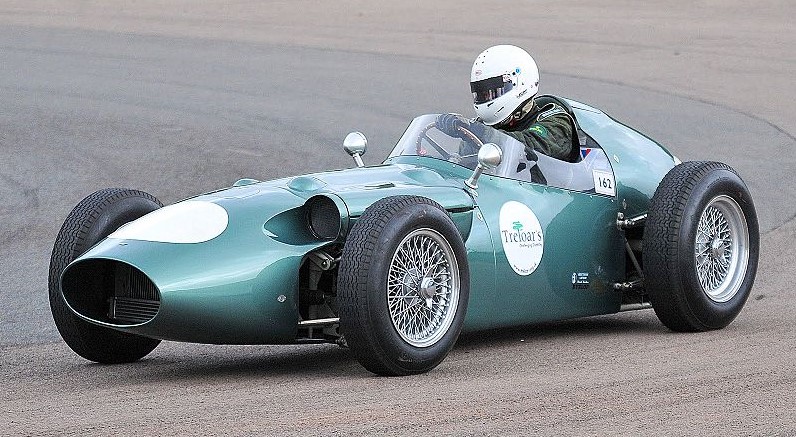 Aston Martin DBR4 at Mallory Park (TOM at Picassa)
Aston Martin DBR4 at Mallory Park (TOM at Picassa)
In 1960, recognising the DBR4 failings, it was replaced by a lighter, smaller and more powerful DBR5. The DBR5 also boasted all-independent suspension and it was entered into the Dutch GP. Unfortunately, the DBR5 wasn't quite ready and a DBR4 was substituted instead for Salvatori but a dispute regarding starting money caused Aston Martin to withdraw prior to the start. Aston Martin then decided to scrap their brief venture into F1 to concentrate entirely on sports car racing.
New Additions: February 2020
Thanks to all those who wished me well during my convalescent and welcome to the February update, how fast did January go by! Happy Chinese New Year to everyone. During this holiday period we traditionally see a lull in releases from the Chinese model factories but in light of what's currently happening in Wuhan, perhaps there could be an extended quiet period? Time will tell, of course. Right, let's get to my highlights for this month ...
Lewis Hamilton is possibly the greatest F1 driver so it's comes as some surprise that his pre-F1 cars have never (to my knowledge) been modelled. Finally, Minichamps have come to the party with three versions of his F3 cars; one from his 2003 Macau race and two from 2004. In 2003 Hamilton was competing in the Formula Renault 2.0 UK championship which he won convincingly and thus was invited to race at the Macau F3 GP. A puncture caused his retirement from that race. In 2004, Hamilton joined the F3 Euro Series racing for Manor Motorsport who ran Mercedes engines in the compulsory Dallara chassis. With just one win at the Norisring circuit, Hamilton would eventually finish 5th in the championship (interestingly, in 4th place was his future Mercedes team mate, Nico Rosberg). Each of these Minichamps Dallara models are limited editions of 504.
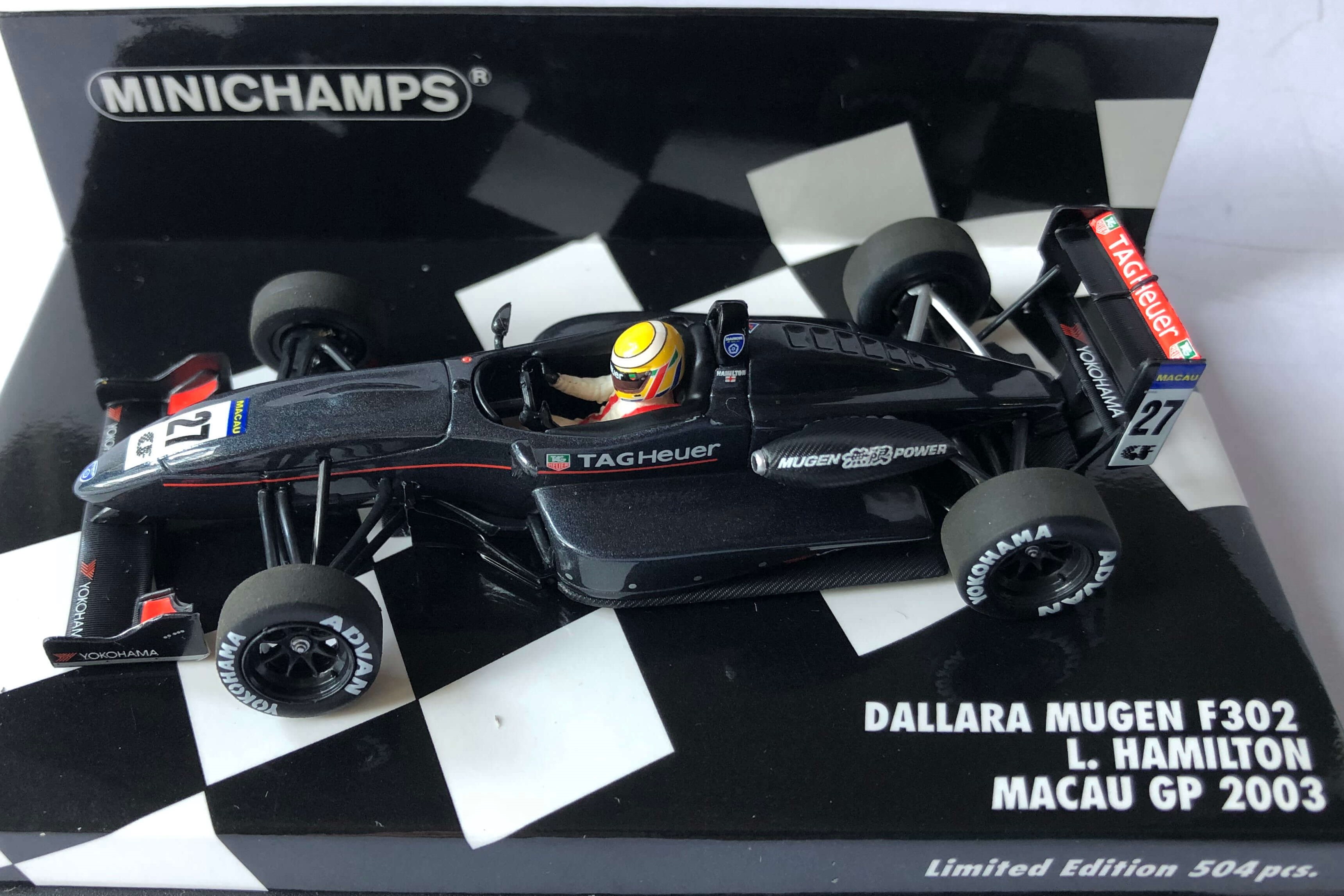 Minichamps: Dallara F302 Hamilton 2003 Macau
Minichamps: Dallara F302 Hamilton 2003 Macau
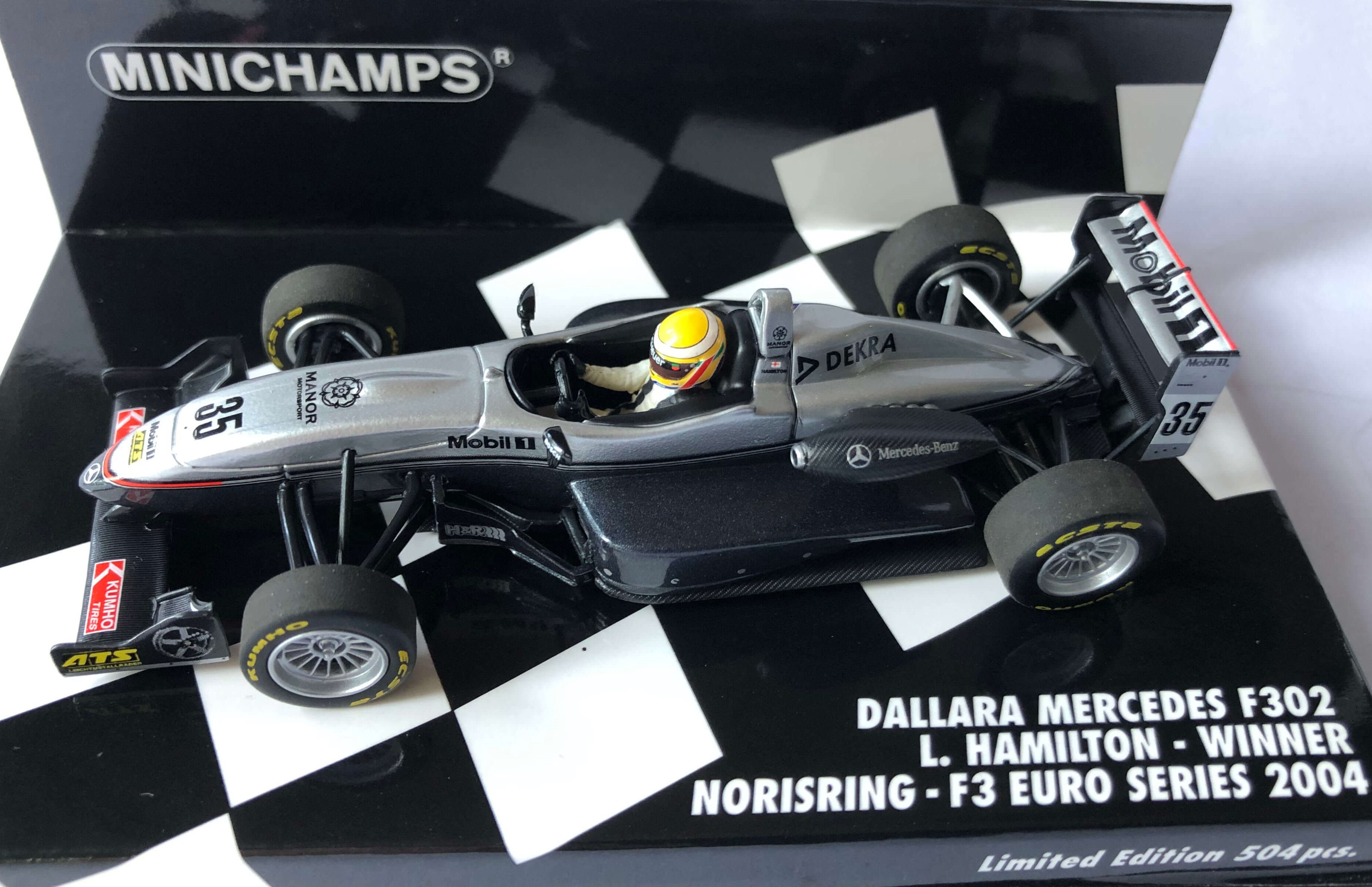 Minichamps: Dallara F302 Hamilton 2004 Norisring
Minichamps: Dallara F302 Hamilton 2004 Norisring
In the mid-1960's the Porsche Company converted two Mercedes-Benz O317 passenger buses into racing car transporters. These vehicles could not only transport the current racing cars of the day, but all the necessasry spares such as engines, gearboxes and body parts as well. These transporters, often derisively labelled as "removal vans", were used by the Porsche racing division well into the 1980's. During the many years of service these transporters moved iconic vehicles such as the Porsche Carrera 6, 917, 935, 956 and 962 race cars. One of the two transporters now resides in the Porsche Museum while the other is owned by Brumos Porsche. Schuco have released this model in four different liveries showing the current company sponsors of the day.
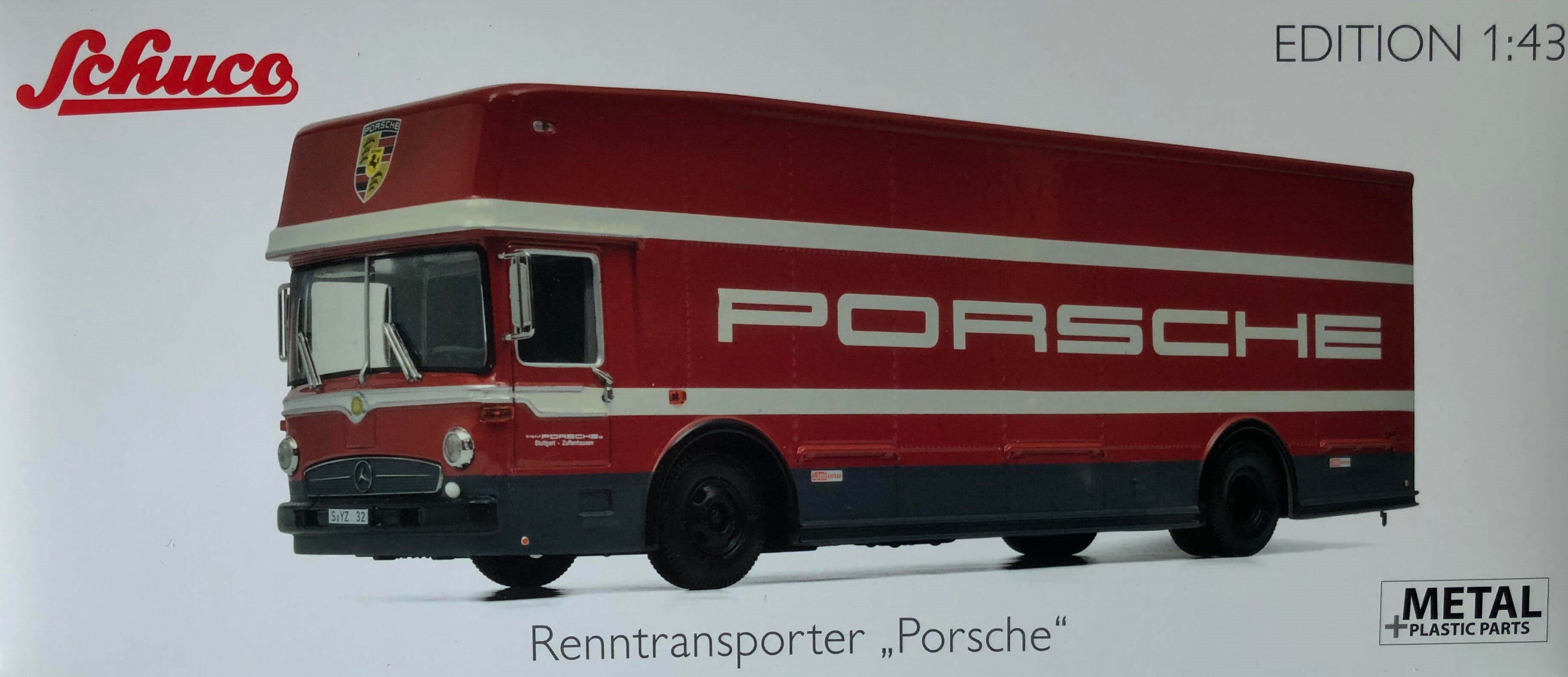
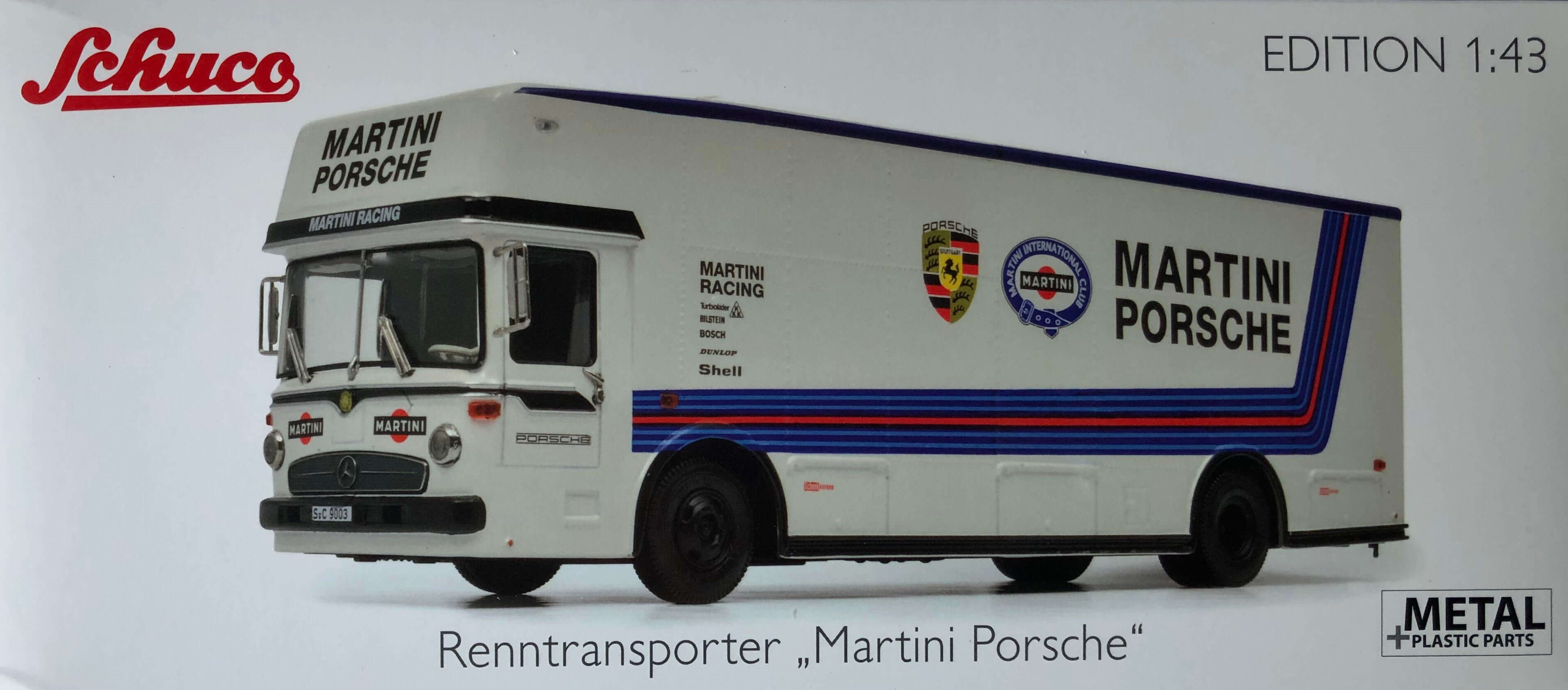
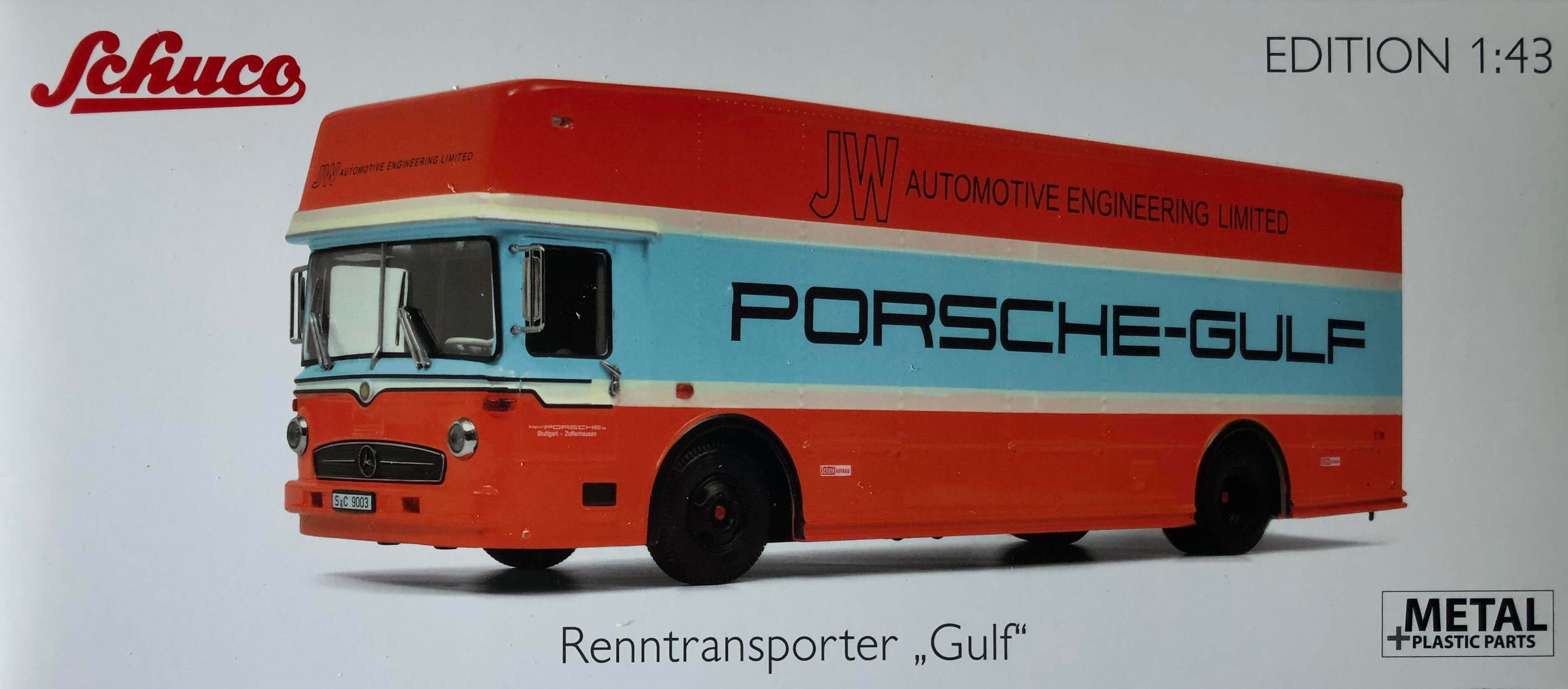
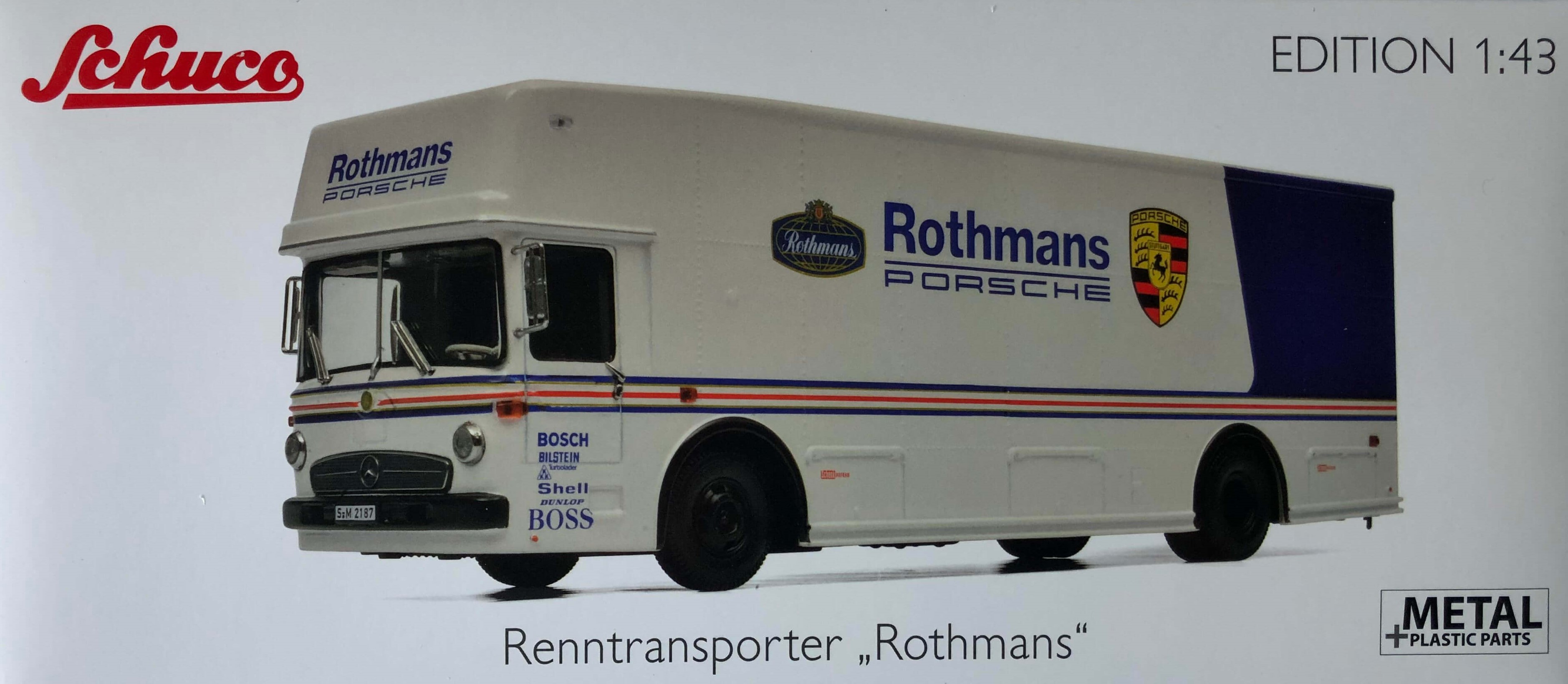 Schuco: Mercedes-Benz O317 Porsche Transporters
Schuco: Mercedes-Benz O317 Porsche Transporters
OK, that's it for another month. There are two model shows in February; the regular monthly 2nd Friday fair at Granville on 14th and then the Collectormania Fair on 23rd February. This Collectormania Fair will be the last ever at the Penrith Pavilion which is earmarked for demolition; the new venue for the Fair will be the Hawkesbury Indoor Stadium at South Windsor. I will be attending both these shows so I hope to see you there. Until next month, happy collecting.
Formula One / Formula Three
- 2003 Dallara Mugen F302, L.Hamilton (27) Macau GP (Minichamps)
- 2004 Dallara Mercedes F302, L.Hamilton (21) Macau GP (Minichamps)
- 2004 Dallara Mercedes F302, L.Hamilton (35) 1st Norisring F3 Euro Series (Minichamps)
- 2019 Haas Ferrari VF-19, R.Grosjean (8) Monaco GP (Minichamps)
- 2013 Marussia Cosworth MR02, J.Bianchi (22) Malaysia GP (Spark)
- 2014 Marussia Ferrari MR03, J.Bianchi (17) Malaysia GP (Spark)
- 2016 Red Bull Tag Heuer RB12, D.Ricciardo (3) Brazilian GP (Minichamps)
- 2019 Renault R.S.19, D.Ricciardo (3) Bahrain GP (Minichamps)
Race Transporters
- 1965 Mercedes-Benz O 317, Porsche Race Transporter (Schuco)
- 1968 Mercedes-Benz O 317, Porsche Gulf Race Transporter white (Schuco)
- 1971 Mercedes-Benz O 317, Porsche Martini Race Transporter white (Schuco)
- 1982 Mercedes-Benz O 317, Porsche Rothmans Race Transporter white/blue (Schuco)
Le Mans / DTM
- 2011 Audi R18 TDI, Fassler/Lotterer/Treluyer (2) LM winner (IXO)
- 1992 BMW M3 E30, A.Hahne (19) DTM (CMR)
- 1966 Ford GT40 Mk ll, Miles/Hulme (1) 2nd Le Mans (CMR)
- 1968 Ford GT40, Rodriquez/Bianchi (9) Le Mans winner (IXO)
- 1957 Jaguar D-Type, Bueb/Flockhart (3) Le Mans winner (IXO)
Road Cars
- 1969 Maserati Indy Coupe in green (Leo Models)
- 2002 Maserati Coupe Cambiocorsa in red (Leo Models)
- 2010 Maserati GranCabrio Sport in dark red (Leo Models)
- 2012 Porsche Panamera Diesel in white (Minichamps)
Misc Scale / 1:18 Scale
- 2019 Renault R.S.19, D.Ricciardo (3) pullback car 1:64 (Z-Models)
- 2019 Renault R.S.19, D.Ricciardo (3) race car 1:18 (Solido)
- 1955 Mercedes W196, J.M.Fangio (10) 1st Belgian GP 1:18 (iScale)
- Ferdinand Porsche Figure 1:18 (LM Miniatures)
After Thoughts: "1976 - The year NASCAR came to Le Mans." At the 44th edition of Le Mans in 1976 two cars from the NASCAR Winston Cup (now NASCAR Sprint Cup Series) came to La Sarthe. The fuel crisis of the early-70's had forced the Automobile Club de l'Ouest (ACO), the organisers of the 24 hour endurance race to run the 1975 race on a fuel consumption formula. But this resulted in a smaller field with several key "works" teams giving the race a miss. In an effort to rectify this, the ACO decided to open up the field in 1976 and a special invitation went out to the American IMSA and NASCAR communities. Discussions were held with Bill France Sr., the founder of NASCAR and the American stock cars were allowed to compete under the new NASCAR class.
Two teams were selected by NASCAR; the Herschel McGriff team with their Dodge Charger and privateer Junie Donlavey with his Ford Torino. NASCAR and the ACO shared the expenses for the teams and transportation. The French dubbed the Torino and Charger "Les Deux Monstres" or the Two Monsters, a term of endearment as the big Detroit cars were enthusiastically embraced by the race fans. The Americans had to make only minimal modifications their cars; they added tail lights, windscreen wipers, lots of headlights and radio communications gear. They also had to add side mirrors when some of the other competitiors complained that the NASCAR drivers couldn't see their low-riding prototypes.
During practice, McGriff was able to push his Charger to 215 MPH (346 KPH) but then the pistons in the 426 cu.in (7 litre) engine started to melt after a couple of laps. In America, the engines were set up for 115-octane fuel but had been modified prior to Le Mans as the ACO stipulated all cars run on 93-octane "pump gas". What was overlooked by the engine builder was that France and the US had different ways of measuring octane; France's 93 actually equated to 88-octane stateside. This caused the engine to pre-ignite badly. Several options were considered to fix this problem, in the end McGriff's team decided to retard the timing and enrich the fuel/air mixture.
With the changes in place, McGriff was able to qualify in 47th position with a time of 4 minutes 29.7 seconds (pole time was 3 minutes 33.1 seconds). The Donlavey Ford Torino qualified in 55th position with a time of 4.38.100. Bill France Sr. was in attendance for the race and Bill France Jr. even waved the starting flag but unfortunately, NASCAR at Le Mans didn't live up to its advance billing and immense popularity. McGriff's engine blew on the second lap, a piston failure caused an oil leak at the end of Mulsanne straight, relegating the Charger to a "Did Not Finish". The Donlavey Ford fared somewhat better but finally retired in the 11th hour with transmission failure having completed 104 laps. Le Mans is hell on transmissions; the Ford Torino's 4-speed gearbox had to make about 22 gear changes per lap and there are some NASCAR races where the driver never made 22 gear changes throughout the entire race! The NASCAR/Le Mans experiment was not repeated the following year. The final words should go to Herschel McGriff, "I was really disappointed in our performance ... We didn't do a good job of representing the class and maybe that's why it didn't run a second year. If we'd run the whole race, and finished, maybe it could've worked."
New Additions: January 2020
Welcome to the first update of 2020 and a happy new year to everyone. I hope everyone had a relaxing break over the festive season and received lots of models cars. January is usually a quiet time of the year but there are a number of new additions to announce and as always I've picked a few highlights amongst my new arrivals. The McLaren M6 GT was the first road car produced by Bruce Mclaren but it was also designed to race on the track. However, before the car could race, 25 copies had to be produced in order to be homologated. The M6 GT road car was presented in 1969 with a 5-litre V8 Chevrolet engine, capable of delivering 430 horsepower in its "race" configuration. McLaren used the assembly firm Trojan to build the 25 bodies needed for homologation but production deadlines were missed and many orders were cancelled. Then in 1970, Bruce McLaren was fatally injured at a Goodwood test session and his death almost marked the end of the M6 GT race programme. Although only three authentic M6 GTs were ever built, many replicas were built by companies such as Coyote so that the M6 GT became eligible for racing. In 1981 an M6 GT made by Trojan was entered into the IMSA GTP class in the Le Mans 24 hour endurance race. Unfortunately the car did not qualify for the race. This was a blessing because without this failure, Ron Dennis could not boast of the triumph of McLaren winning at their first appearance at Le Mans in 1995.
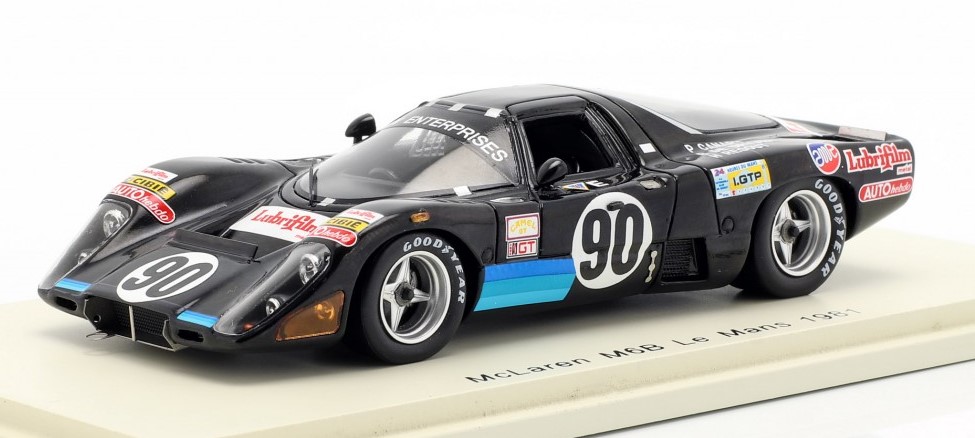 Spark: McLaren M6 GT Le Mans 1981 (DNQ)
Spark: McLaren M6 GT Le Mans 1981 (DNQ)
The Mercedes AMG GT3 is a regular contender in GT racing around the world and three such cars contested the 2017 24 hours of Daytona in the GTD (GT Daytona) class. One beautifully presented entrant was the SunEnergy1 Racing Mercedes AMG driven by several drivers including Australians Paul Morris and Kenny Habul. Habul is the founder and CEO of SunEnergy1 which is ranked the 5th largest developer of utility-scale solar projects in the USA. Unfortunately the car was classified as a non-finisher.
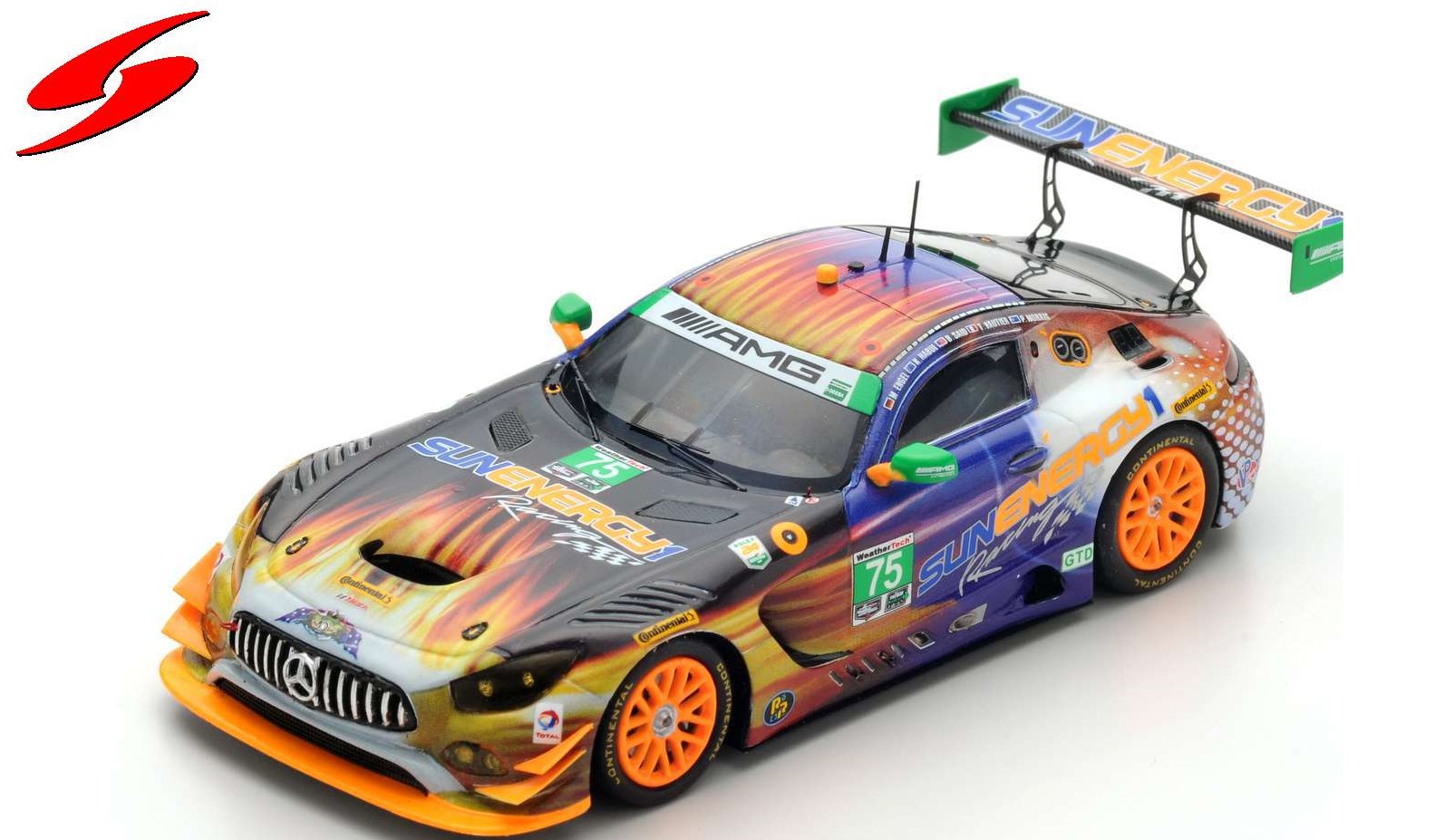 Spark: Mercedes AMG GT3 2017 24hours of Daytona
Spark: Mercedes AMG GT3 2017 24hours of Daytona
There's very little information available about the next featured car; the Fiat 600D Multipla that two adventurous young men drove from Australia overland to England in 1969. Coincidentally, when this model arrived, I was reading a book titled "A Journey that Never Was" by Jeanne de Ferranti which described the 2 year journey of two British girls who drove an Austin Mini in the early 1960's from England to India, then to Australia/NZ, Mexico, USA and Canada before sailing back to England. In fact, the overland trip between England and Australia was quite popular from the mid-50's to late 1970's and was even given the name "The Hippie Trail". The key element was to travel as cheaply as possible by hitchhiking, using local buses/trains and of course, driving converted Kombi vans. The trail came to an end in the late 70s with political changes in countries such as Iran and Afghanistan making them less hospitable to foreign travellers.
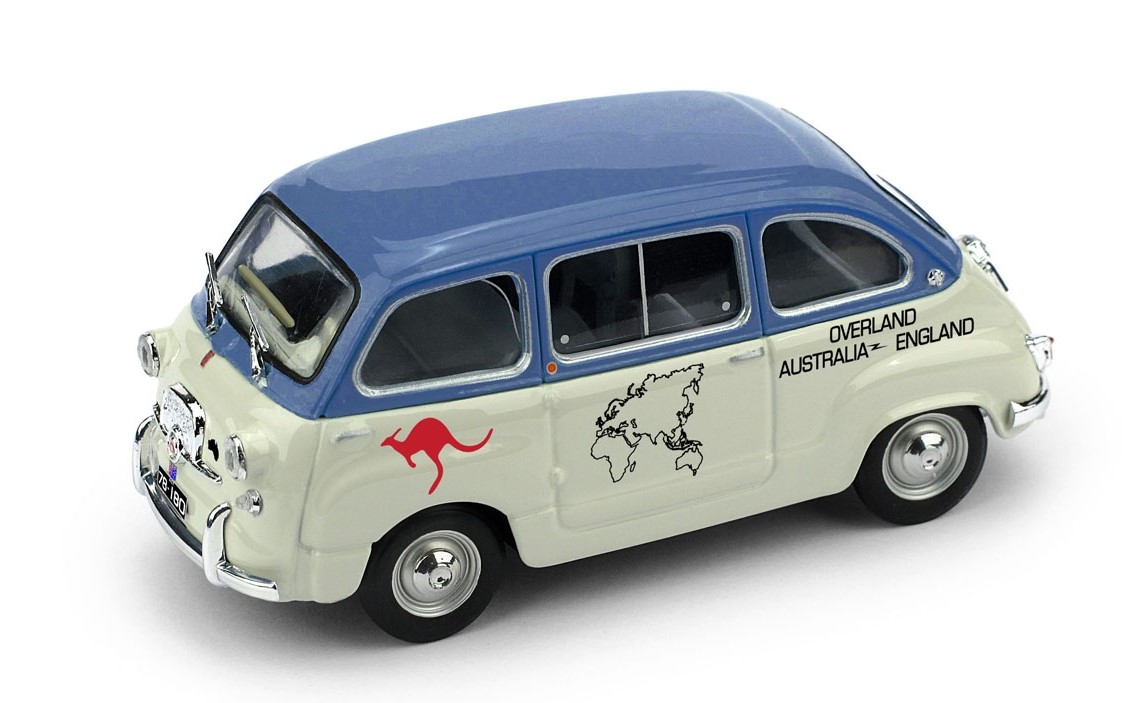 Brumm: Fiat 600D Multipla Aust - England Overland
Brumm: Fiat 600D Multipla Aust - England Overland
Recently, I acquired a number of F1 models from the Partworks F1 Collection by Panini (https://store.panini.co.uk/f1-partworks). These models were sold in newsagents not very long ago and came with a magazine which gave a description and history of the car. I have over 40 different models from this series which I think spanned around 80 issues. The models that I have in stock do not come with the magazine and so are reasonably priced at $15 each but they do come with a protective acrylic cover. I have good stocks of most of the listed models although some are down to one or two. Please use the Partworks F1 Cars link for the full list on models currently in stock.
OK, that's it for the first update for 2020. The only model fair in January will be the Granville fair on 10th January. Unfortunately, I've decided not to attend this fair to allow myself extra time to recover from my recent operation. Please check out the Swap Meets page for all the 2020 model fairs and shows; quite a few shows haven't had dates confirmed yet so please check regularly for updates. Until next month, happy collecting.
Formula One
- 1979 Ferrari 312 T4, J.Scheckter (11) 1st Monaco GP (Brumm)
- 1982 Ferrari 126C2, G.Villeneuve (27) 2nd San Marino GP (Brumm)
- 1976 Hesketh Ford 308D, H.Ertl (24) Dutch GP (Spark)
- 1963 Lotus Climax 25, J.Clark (1) World Champ Belgian GP (Brumm)
- 2016 Manor Mercedes MRT05, E.Ocon (31) Belgium GP (Spark)
- 1976 March Ford 76B, G.Villenueve (69) Form. Atlantic 1st Mont Tremblant (Minichamps)
- 1976 March Ford 76B, J.Hunt (96) Formula Atlantic De Trois-Rivieres (Minichamps)
Australian Race Series
- 1987 BMW M3 E30, Cecotto/Brancatelli (42) 1st WTCC/7th Bathurst 1000 (Spark)
- 2019 Merc-AMG GT GT3, Lowndes/Van Gisbergen/Whincup (888a) 12 hr Bathurst (Spark)
American Race Series
- 1988 March Buick 86G, Roe/Moretti (30) Lime Rock 150 laps "Momo" (Spark)
- 2017 Mercedes AMG GT3, P.Morris/Said/Engel/Vautier (75) 24h Daytona (Spark)
- 2018 Volkswagen ID R, R.Dumas (94) Winner Pikes Peak (Spark)
Le Mans
- 2016 Bentley Continental GT3, Pierce/Harris/Rosenblad/Perel (30) 24hr Spa (Spark)
- 1971 BRM Chevrolet P167, B.Redman (38) 1st Interseries Hockenheim (Spark)
- 1997 Courage C36 Porsche, Pescarolo/Clerico/Belloc (8) 7th Le Mans (Spark)
- 1970 Fiat Abarth 1000, R.Dijkstra (3) Zandvoort Trophy (Brumm)
- 1970 Fiat Abarth 850 TC, R.Zwolsman (7) Zandvoort Trophy (Brumm)
- 1973 Fiat Abarth 1000, R.Amighini (91) Coppa Carri, Monza (Brumm)
- 1981 McLaren Chevrolet M6B (Trojan), Regout/Elkoubi (90) Le Mans (DNQ) (Spark)
- 1996 McLaren F1 GTR, D.Brabham/Raphanel/Owen-Jones(34) 5th Le Mans (Spark)
- 2018 Nissan GT-R GT3, Parry/Buncombe/Ordonez (23) Spa 24 hour (Spark)
- 1976 Fiat Abarth 1000, G.Chivacci (248) Trento-Bondone Hill Climb (Brumm)
- 1990 Peugeot 405 T16, Vatanen/Berglund (203) 1st Paris Dakar Rally (Spark)
Road Cars
- 1984 Bentley Continental Convertible in red (Spark)
- 1999 Bentley Continental SC in black (Spark)
- 1959 Fiat Nuova 500 Sport open roof in white/red stripe (Brumm)
- 1969 Fiat 600D Multipla, Thomas/Harper "Overland Australia to England" (Brumm)
- 1985 Commodore VK GrpA/3 in formula blue (Biante)
- 1977 Maserati Merak 2000 GT in metallic light blue (Altaya)
- 1990 Maserati Shamal in red (Altaya)
- 2004 Maserati Coupe GranSport in metallic white (Altaya)
- 1936 Morgan 4/4 Flat Radiator S1 in green (Neo)
- 1932 Packard 902 Std Eight Coupe dark red/black (Neo)
- 1949 Packard Super DeLuxe Club in metallic turquoise (Neo)
- 1958 Plymouth Fury Hardtop in red/white (Neo)
- 1970 Plymouth Hemi Cuda in sassy grass green (Spark)
- 2018 Porsche 911 GT3 in grey (Spark)
After Thoughts: "Ford vs. Ferrari - Alternative Truths." The blockbuster Hollywood movie "Ford vs Ferrari" was based on the true story of the development of Ford's GT40 to compete against the cars of Enzo Ferrari. As with most movies dealing with real events, inevitably some events are "tweaked" for dramatic effect. Here are some inaccuracies, in no particular order that have been widely reported.
- Ken Miles, in the film showed no patience with the Ford engineers' heavy computer in the passenger seat weighing down the test car and he ripped it out. The Shelby team then taped bits of string to determine the flow of air over the body. In fact both, methods were used successfully and there was no conflict between the Ford technicians and the Shelby team.
- At one point, a Ford executive suggested Shelby was the best man to lead the GT40 project because he was the only American to have won at Le Mans (in 1959). In fact Luigi Chinetti (a naturalised US citizen) and Phil Hill, both previously won the Le Mans 24 hours but, inconveniently both drove Ferraris to victory.
- Carroll Shelby didn't take Henry Ford II for a wild ride; it was actually Ken Miles. Also, Shelby never locked Leo Beebe in his office while Ford was being taken for a ride.
- The race at Willow Springs Raceway in California (the spanner throwing incident) never happened in real life. It was added to develop the personalities and relationship of Shelby and Miles.
- The Ford bureaucrats did not refuse to send Ken Miles to Le Mans in 1965. Miles did, in fact race a Shelby-American GT40, partnered with Bruce McLaren but retired after 4 hours with gearbox failure. No GT40 managed to finish that year.
- Did Enzo Ferrari attend the 1966 Le Mans race? No, in real life Ferrari never attended race meetings, not even F1 races. The most likely explanation was Enzo liked to distance himself from the team so he could blame other people for any problems. However, Henry Ford was at Le Mans to witness his cars coming 1st, 2nd and 3rd.
- On a final note, in the film all three cars crossed the finish line at the same time. But photos of the finish showed the black GT40 of McLaren slightly ahead. It is believed that despite team orders, Bruce McLaren accelerated just ahead of Miles at the last moment in an attempt to finish 1st. As Miles stepped out of his car, he said to his mechanic, "I think I've been fucked".
